Learn English: Beginning Grammar Specialization
Specialization Certificate
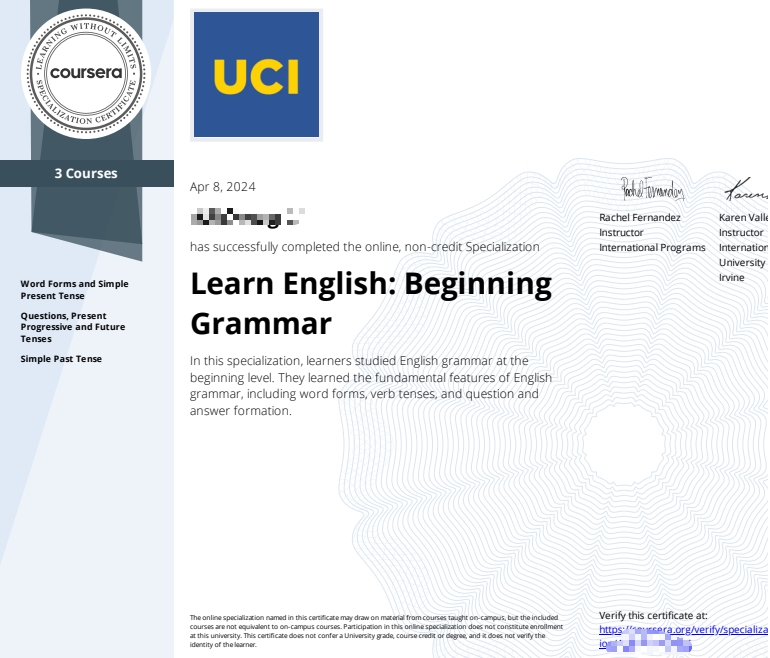
course 3:
Simple Past Tense
Course Certificate
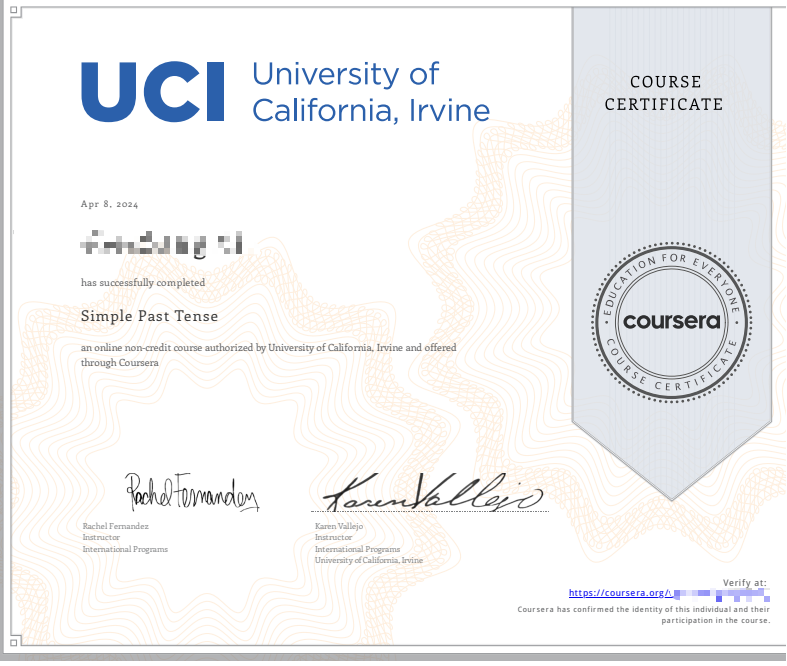
本文是学习 https://www.coursera.org/learn/simple-past-tense 这门课的学习笔记,如有侵权,请联系删除。

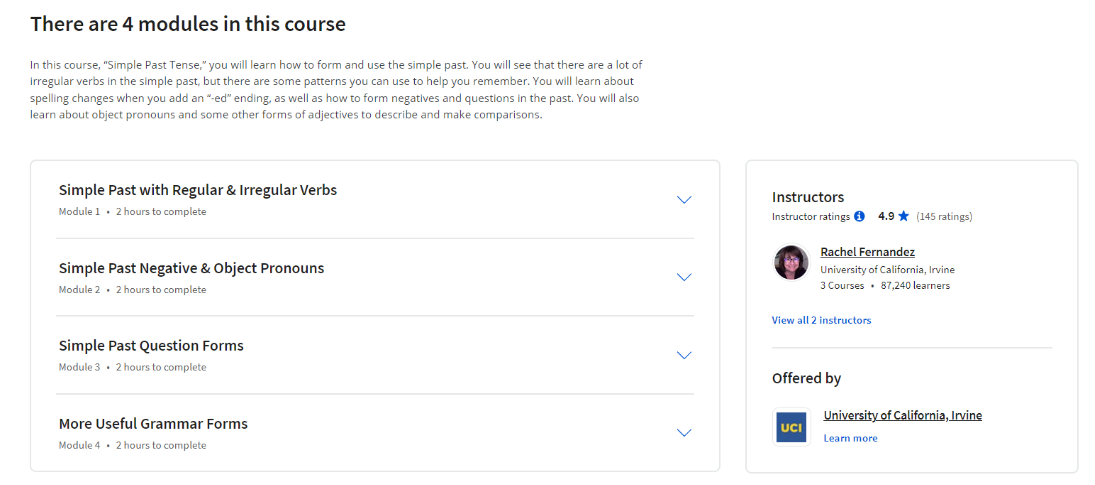
文章目录
- Learn English: Beginning Grammar Specialization
- Simple Past Tense
- Week 01: Simple Past with Regular & Irregular Verbs
- Learning Objectives
- Simple Past BE
- Simple Past BE (Practice Exercise)
- Simple Past Regular Verbs
- Simple Past Regular Verbs (Practice Exercise)
- Simple Past Irregular Verbs
- Simple Past Irregular Verbs (Practice Exercise)
- Quiz: Simple Past with Regular & Irregular Verbs
- Week 02: Simple Past Negative & Object Pronouns
- Learning Objectives
- Simple Past Negative BE
- Simple Past Negative BE (Practice Exercise)
- Simple Past Negative Verbs
- Simple Past Negative Verbs (Practice Exercise)
- Object Pronouns
- Object Pronouns (Practice Exercise)
- Quiz: Simple Past Negative & Object Pronouns
- Week 03: Simple Past Question Forms
- Learning Objectives
- Simple Past Yes/No Questions BE
- Simple Past Yes/No Questions BE (Practice Exercise)
- Simple Past Yes/No Questions Verbs
- Simple Past Yes/No Questions Verbs (Practice Exercise)
- Simple Past Information Questions
- Simple Past Information Questions (Practice Exercise)
- Quiz: Simple Past Question Forms
- Week 04: More Useful Grammar Forms
- Learning Objectives
- This, That, These & Those
- This, That, These & Those (Practice Exercise)
- Comparatives
- Comparatives (Practice Exercise)
- Infinitives with Want, Need & Like
- Infinitives with Want, Need & Like (Practice Exercise)
- Quiz: More Useful Grammar Forms
- 后记
simple past: 一般过去时
comparative:比较级
infinitive:不定式
subject pronoun:主语代词
object pronoun:宾语代词
syllable : 美 [ˈsɪləbl] 音节
county fair:乡村集市
bumper cars:碰碰车 drive bumper cars
merry-go-round: 旋转木马
fishing pole:钓鱼竿
spill: 溢出,洒出;spill coffee on my papers
hippopotamus:美 [ˌhɪpəˈpɑːtəməs] 河马
Week 01: Simple Past with Regular & Irregular Verbs
This week is about the simple past. You will learn how to form BE in the simple past first. Then you will learn about how to add -ed to form the simple past of regular verbs and the spelling changes you need to make. Then you will see a long list of irregular verbs in the simple past. There are many irregular verbs that you just need to remember.
Learning Objectives
- Form the simple past.
- Recognize regular and irregular verbs in the simple past.
Simple Past BE
Simple past BE. In this lesson, we’ll look at how to form
the past of the be verb. Let’s read this. Mark Twain, 1835-1920. Mark Twain was an
American writer. His real name was
Samuel Clemens. Mark Twain was his pen name. He was from a small town
near the Mississippi River, and many of his books
were about that area. His books were popular
when he was alive, and they are still popular now. Let’s look at the verb BE. Here we have many examples
of BE in the past. Was, was, was, was, were. Because books are plural. Were, one more was. But look here, are, this is in the present because his books are
still popular now,

let’s look at the verb
chart for BE in the past. This is the chart for the
simple past form of BE. I was, you were, he was, she was, it was, we were, you were and they were notice there are
two forms was and were. Notice that they
don’t look like BE. Again, BE is always
a little different. The plural forms
are all the same. Were, were, were.

You already know how to use
the BE verb in the present. She is a student. He is in the kitchen. They are happy. The use in the past is the same. These sentences in
the past would be, she was a student. Maybe she isn’t anymore. He was in the kitchen. Maybe now he’s in
the living room. They were happy. They
were happy on their trip.
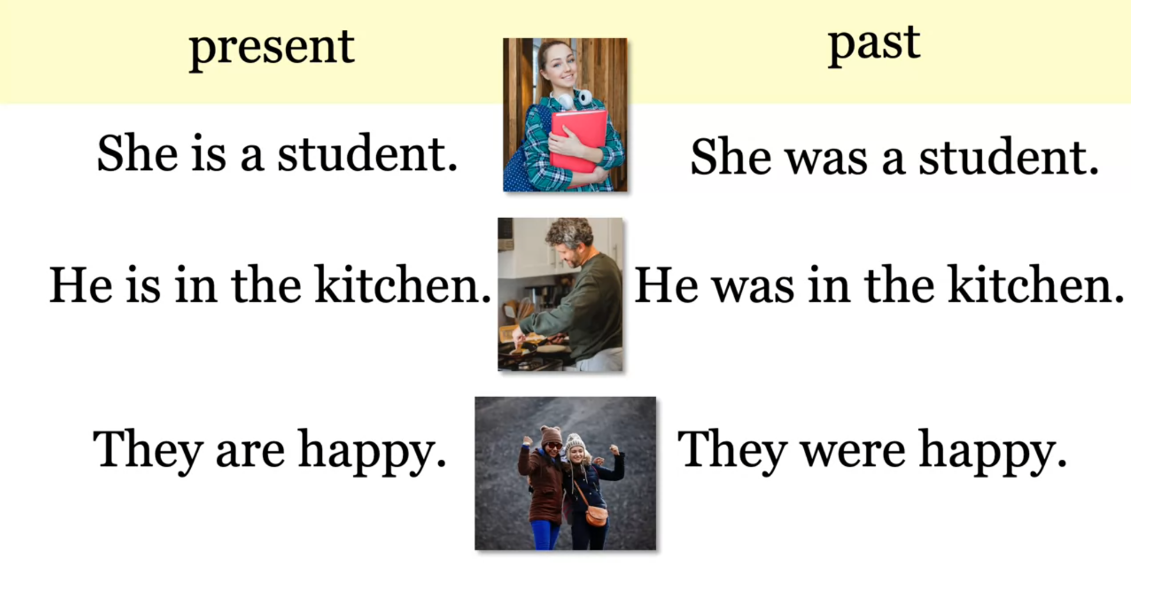
Here’s another example
of BE in the past. John was at work
late last night. It was 11:00 p.m. He was very tired. No one else was in the office. The lights were off, so it was dark. Let’s look for the
past forms of BE. Do you see them? Was, was, was, was, were because the
lights are plural and was.
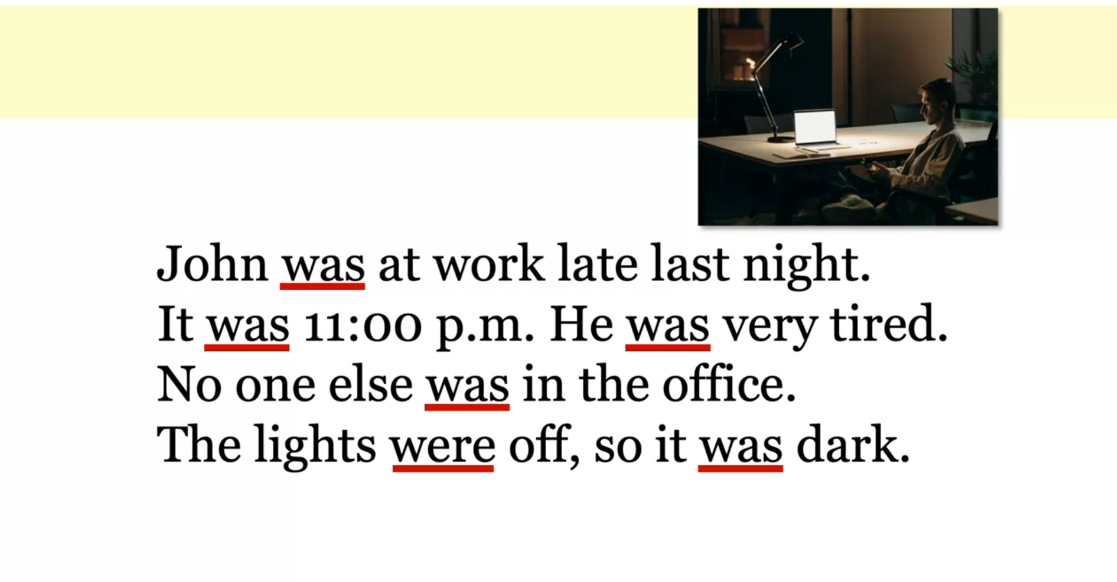
Put it in the past. Here we have some sentences
in the simple presence. Bob and Helen are on vacation. They are at a beach in Mexico. They are very happy because
the weather is beautiful, the people are friendly, and the food is delicious. Take a moment. Maybe you
want to pause the video, put this in the past. You need to find the BE verb, and then change it
to the past form. Let’s look for the
BE verb together. Are, are, are, is, are, are, and is. Are you ready to
see the answers? Bob and Helen were on vacation. They were at a beach in Mexico. They were very happy because
the weather was beautiful, the people were friendly, and the food was delicious.
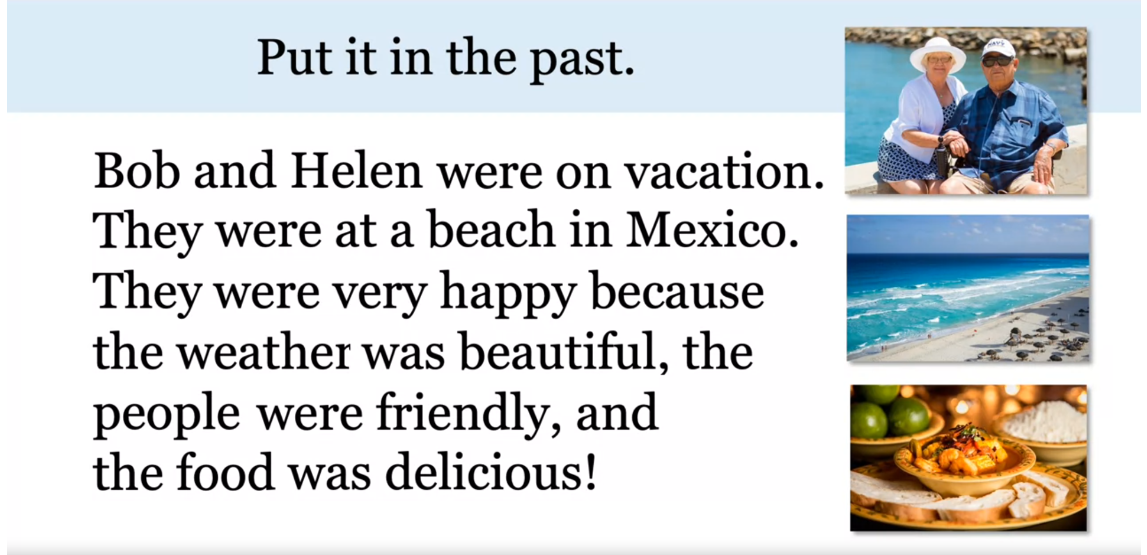
Let’s do it again. Put it in the past. First here it is in the present. Jane is at work today. Her computer is on. There are many
papers on her desk. Her coffee is hot. She is very busy. Find the BE verb and change
them all to the past. Ready? Jane was at
work yesterday. Her computer was on. There were many
papers on her desk. Her coffee was hot. She was very busy. We have all these
past forms of BE. Also notice that we changed today to yesterday
to make it the past.
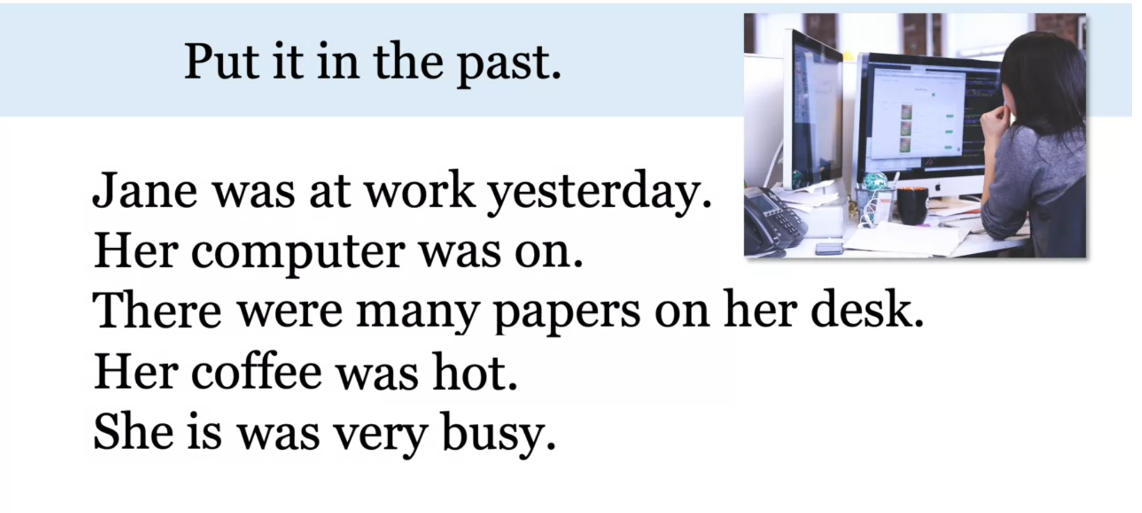
Now you know from
this lesson that the simple past of
BE has two forms. John was at work
late last night. Bob and Helen were on vacation
in Mexico last summer.
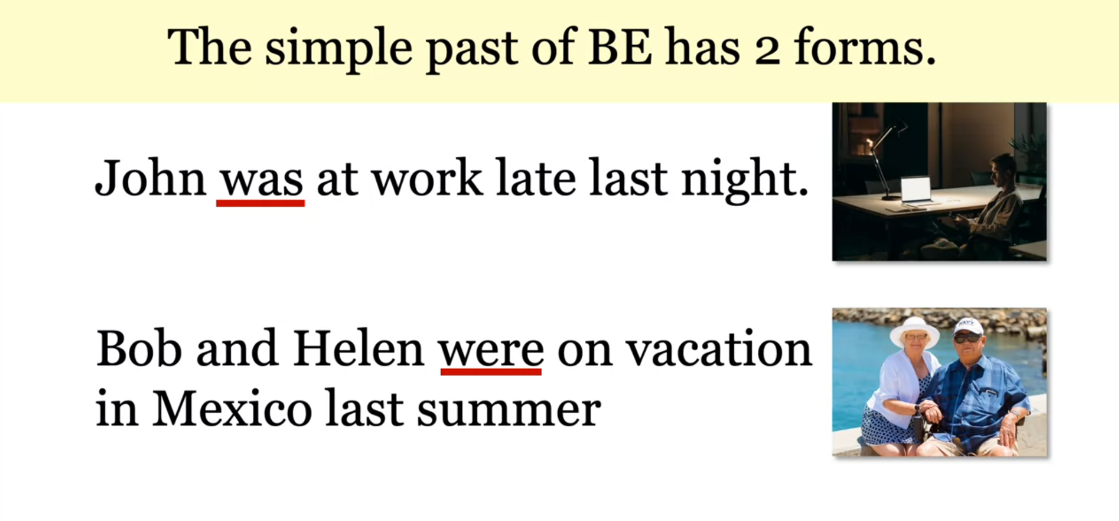
Simple Past BE (Practice Exercise)
Exercise
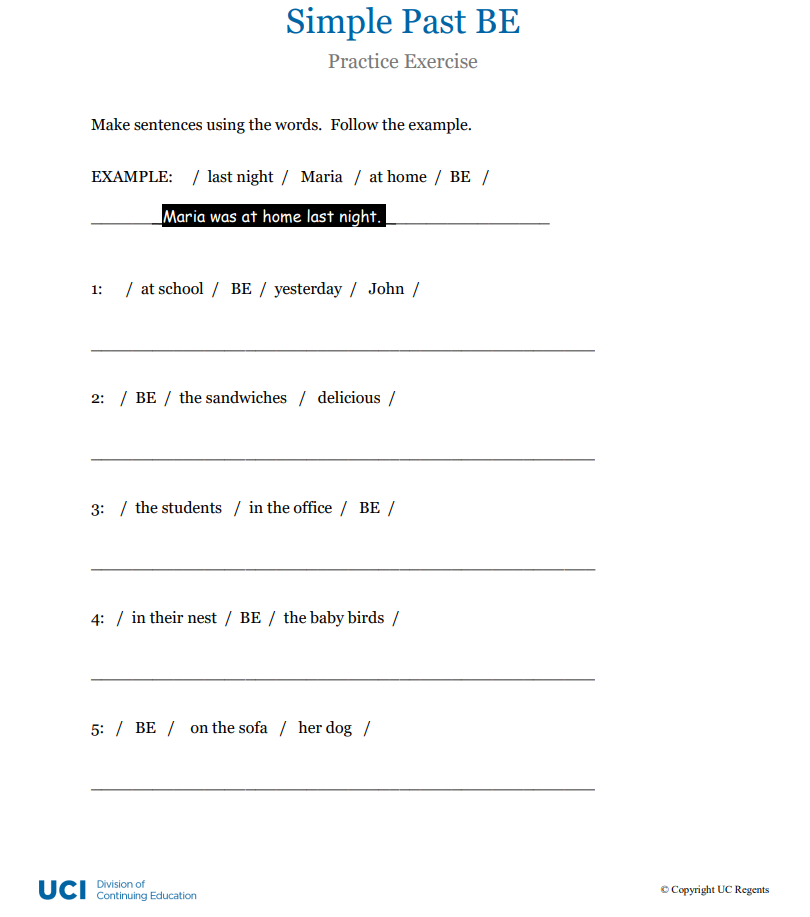
Answer
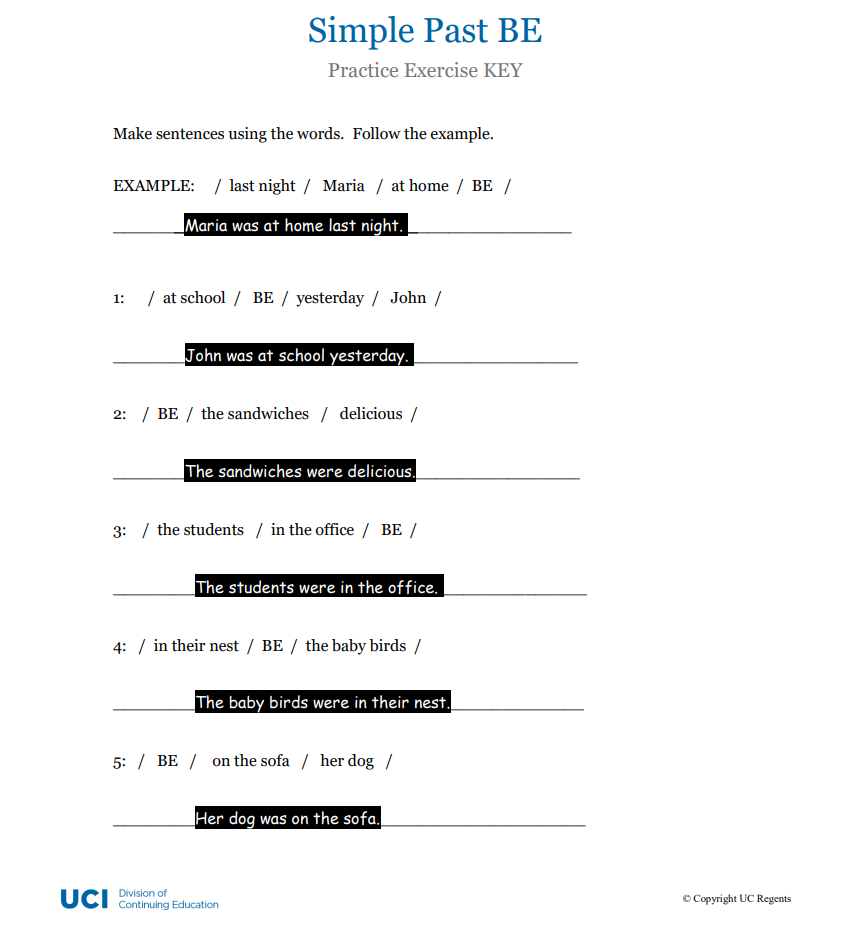
Simple Past Regular Verbs
Simple past regular verbs. Jan cleaned all day. First, she washed dishes. Then she dusted all the shelves. She vacuumed the carpet. She pretended to play
the guitar with a broom. Finally, she rested. Do you see all of the verbs in the past? Let’s look, cleaned, washed, dusted, vacuumed, pretended and rested.
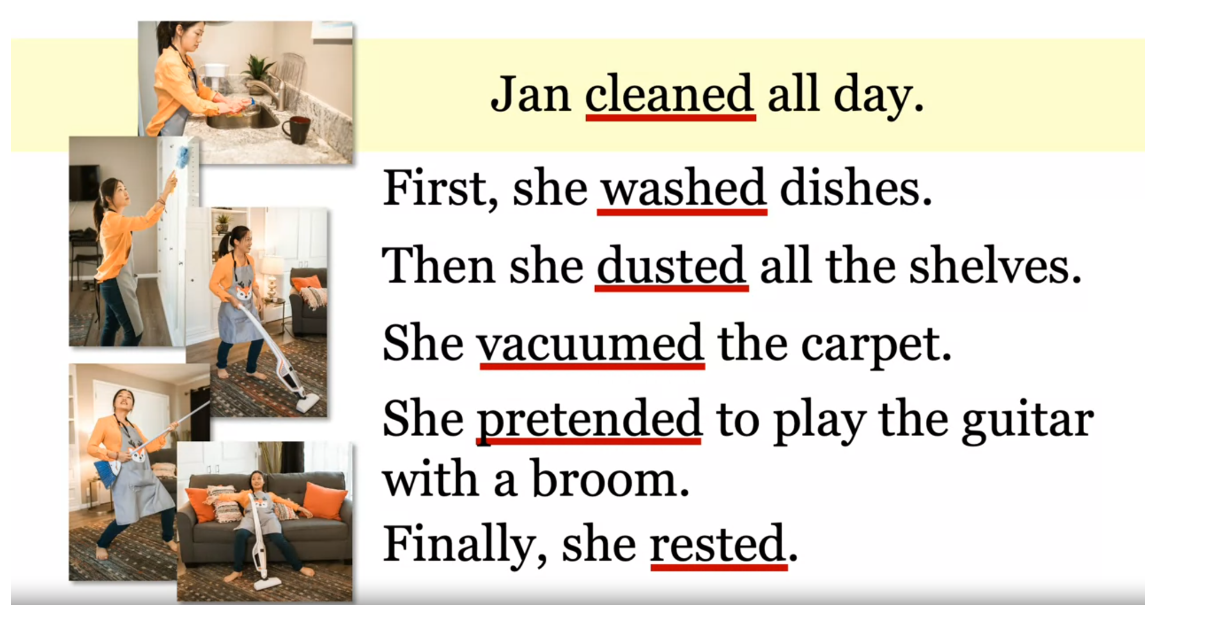
Here is the simple past verb chart. We will fill it out with the verb talk,
okay? I talked, you talked,
he talked, she talked, it talked, we talked, you talked and they talked,
as you can see there is 1 form. They are all the same,
to make the past we just add -ed.
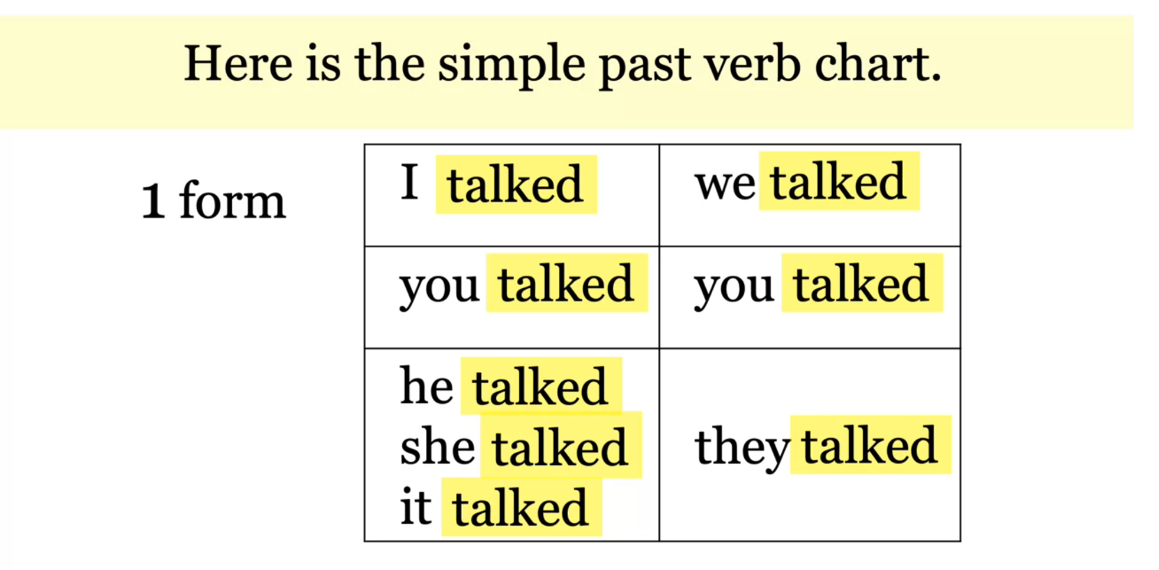
Let’s look, for regular verbs
add -ed to the end of the verb. For example,
they washed the car last week. It rained yesterday. Laura walked on the beach. Notice the -ed endings in washed,
rained and walked.
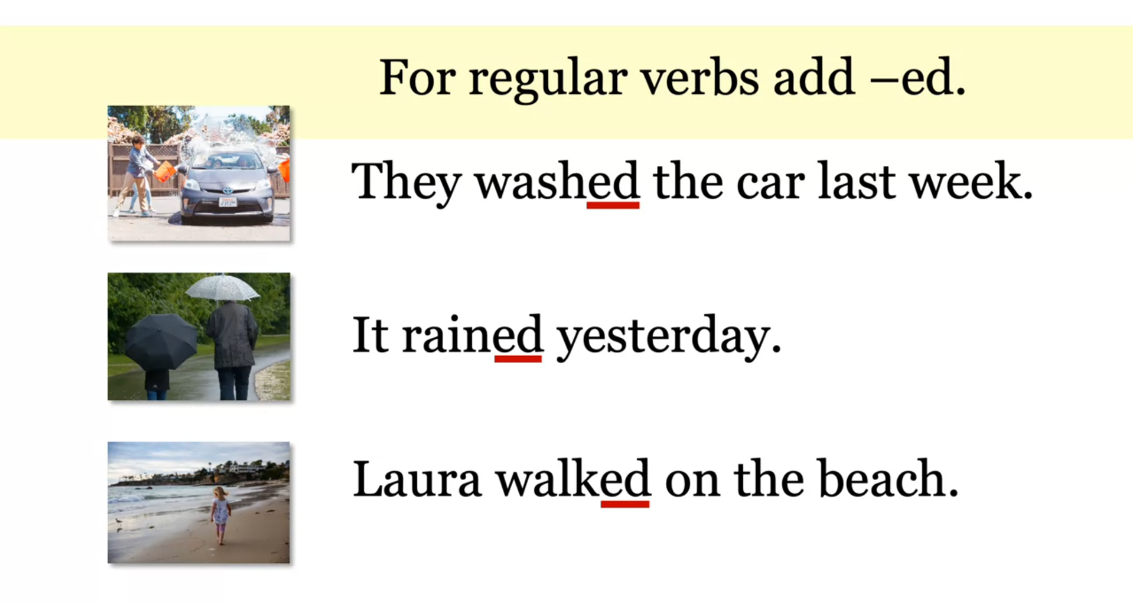
For many verbs add -ed to form the past. So for many verbs just add ed. Clean becomes cleaned, walk becomes walked, wait changes to waited and look becomes looked. There are spelling
changes with ed endings. For some verbs we just add +d. Bake becomes baked, smile, smiled. For other verbs we double
the consonant and add +ed. Stop, gets an extra p and then the ed. Plan gets another n and then an ed. And for others we dropped the y and
add ied. Carry becomes carried. And cry we dropped the y, add ied.
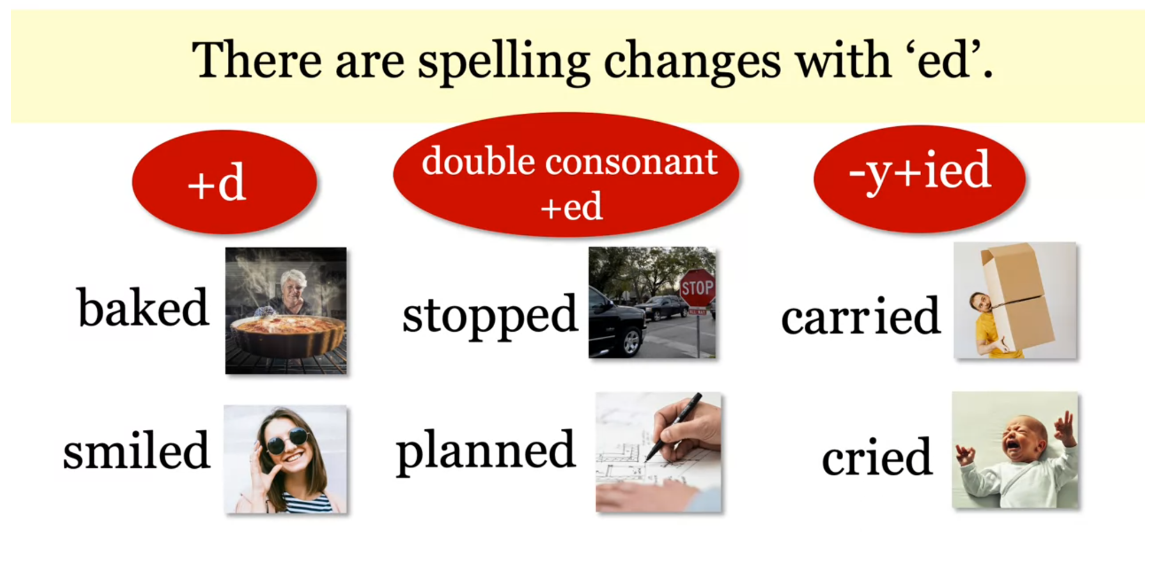
Let’s take a closer look. When the verb ends with -e, add d. You don’t need to add an extra ed just d. So bake becomes baked. Smile becomes smiled. Add a d to move to get moved. And add just a d to dance to get danced.
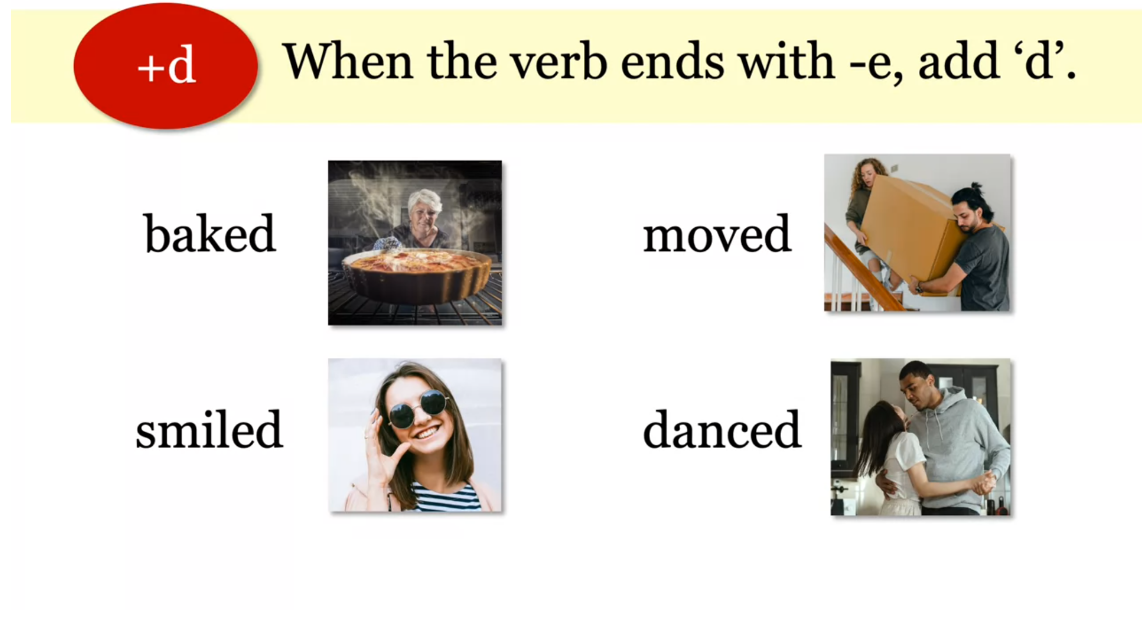
Double the last consonant and
add -ed when the verb is one syllable and ends in CVC,
that’s consonant vowel consonant. This looks complicated, but
it’s not that complicated. So look at the word stop. It has one syllable that means it’s short. It just has one beat, stop and
it’s got a consonant, a vowel and a consonant at the end. We double the consonant and add ed, so stop double the p add ed and
we get stopped. This doesn’t happen with verbs
that end with -w, -x, -y or -z.
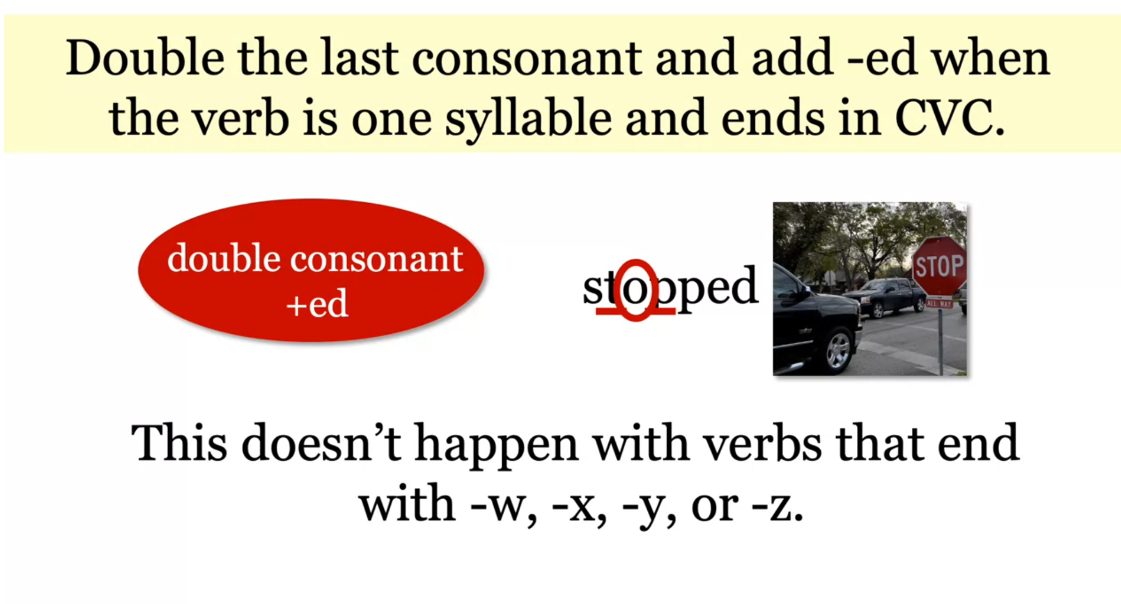
Let’s look at some examples. Stopped. Let’s look at some examples. So we already did stopped. And now look at plan. Plan also ends with a consonant vowel and
a consonant. So we add an n and then ed, planned. Hop is the same thing. I need to double the consonant and
add ed, hopped. Hug also double the g add ed, hugged.

And the last spelling change is drop y and add ied when verb ends with consonant and
y. So carry, we dropped the y add ied and
it changes to carried. Cry, cried. Study drop the y add ied, studied. Worry drop y add ied, worried.
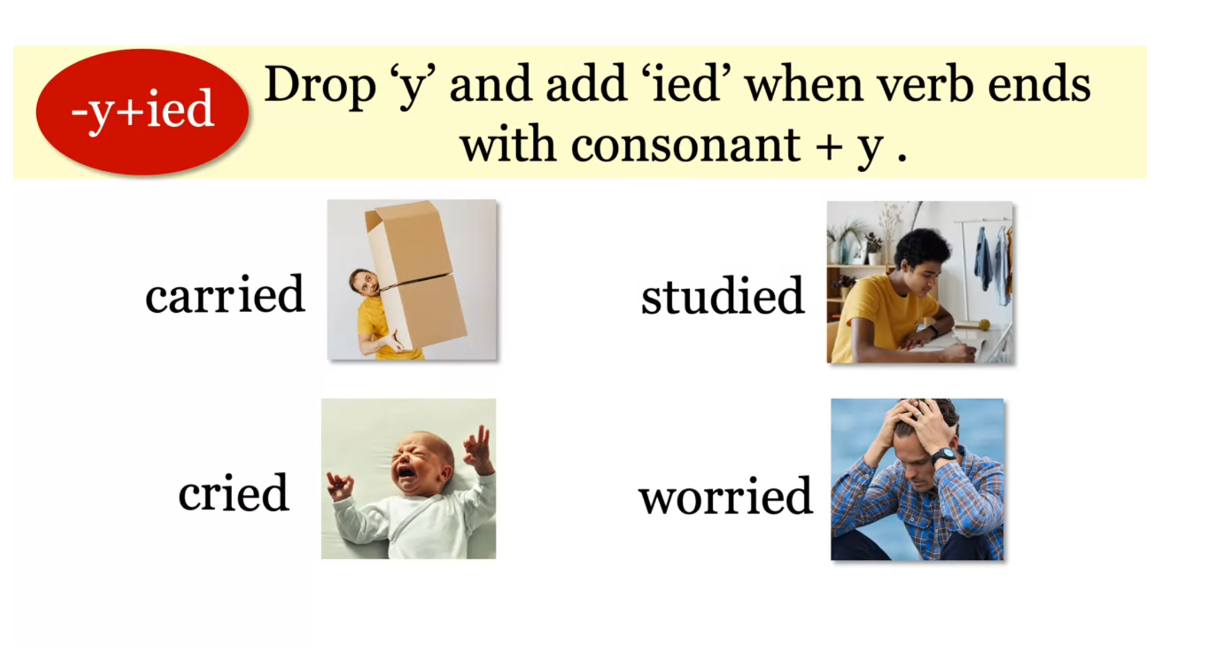
Simple past tells what
happened in the past. Let’s look at some examples. Here is our timeline. Let’s say, Meg visited her grandparents. When? Meg visited her grandparents yesterday. Meg visited her grandparents last week. Meg visited her grandparents last month. Meg visited her grandparents last year. This word last is a signal word for
the past. We put it with another time,
last week, last month, last year. Meg visited her grandparents 3 years ago. Now this ago is the signal that
tells us it happened in the past. And we can use ago with
a long time like 3 years ago. Or we could say Meg visited
her grandparents 3 hours ago. Ago signals that it happened in the past.
Let’s practice,
change the verbs to the past. You can pause the video and
write them down if you want. These are all in the present right now. The research team works all day. Rob explains the diagram. They talk a lot about the problem. They change part of their plan. They decide to build a new system. Are you ready for the answers? Okay. The research team worked all day. Rob explained the diagram. They talked a lot about the problem. They changed part of their plan. They decided to build a new system. Notice that all of
the verbs now end with ed. In the present, they have different
endings depending on the subject, but in the past there is just one form,
okay?
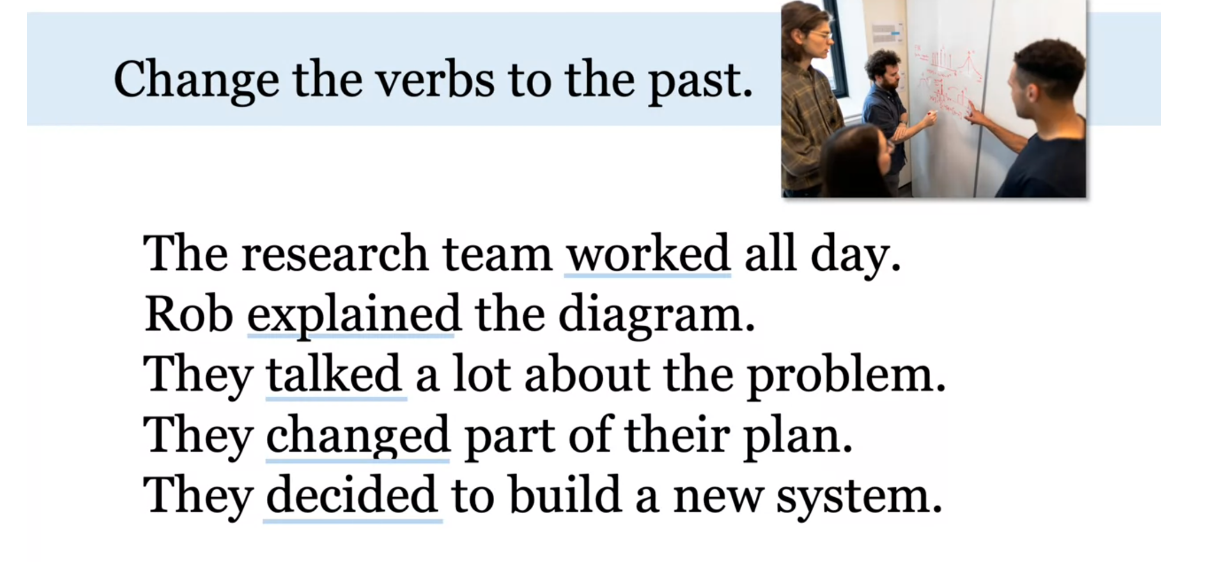
One more time, put the verbs in the past. This time these verbs
are all in the simple form. They’re not in the present. They all need to be in the past. But watch your spelling. Some of these have spelling changes. Maybe you want to pause the video and
try to write them down, okay? Are you ready for the answers? The children listened to a story. There was a little boy. Did you remember be is irregular? Don’t add ed to be. One day he carried a bowl of
noodles to the kitchen table. He dropped the bowl. He cried because he wanted
to eat the noodles. Then an old man appeared and I don’t know,
I don’t know at the end of this story.
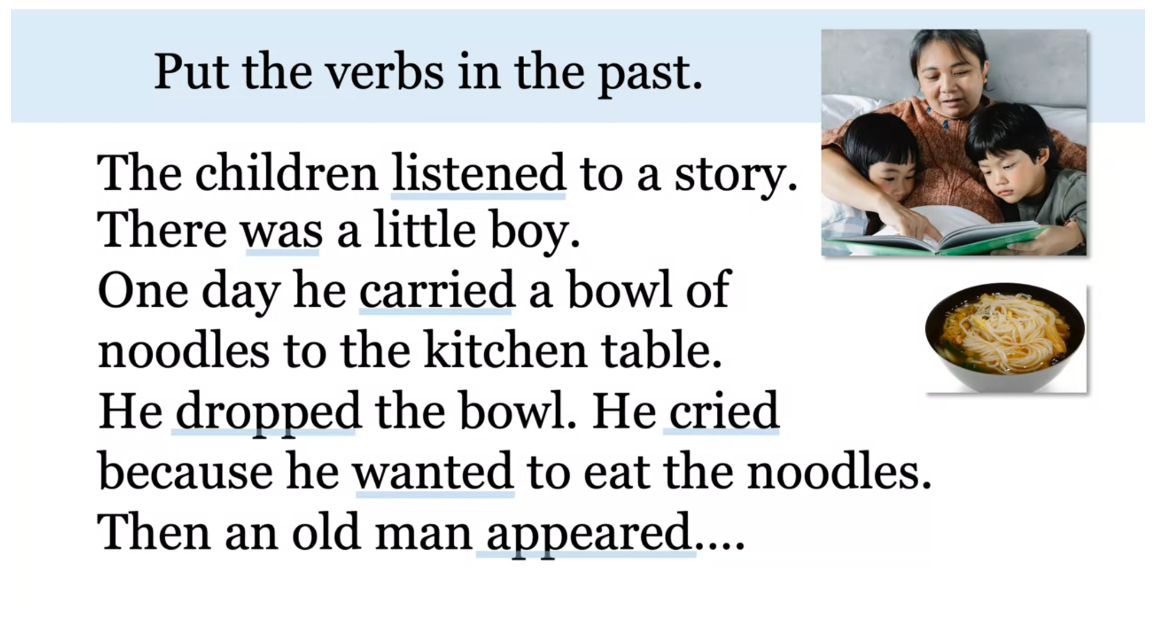
Now you know, add ed to form
the simple past for regular verbs. She cleaned. They danced yesterday. They hugged last week. He studied two days ago and you know
that there are some spelling changes. A lot of times we add ed,
sometimes we just need the d. Sometimes we double the consonant and
sometimes we dropped the y and add ied. You also know that yesterday, last and ago are signal words for the past.
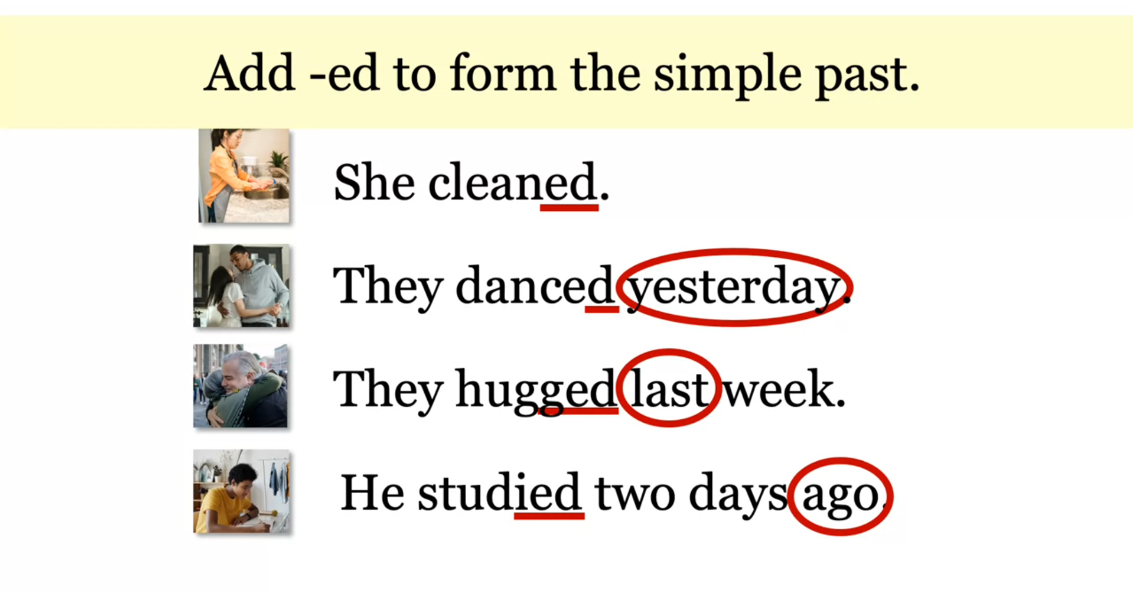
Simple Past Regular Verbs (Practice Exercise)
Exercise
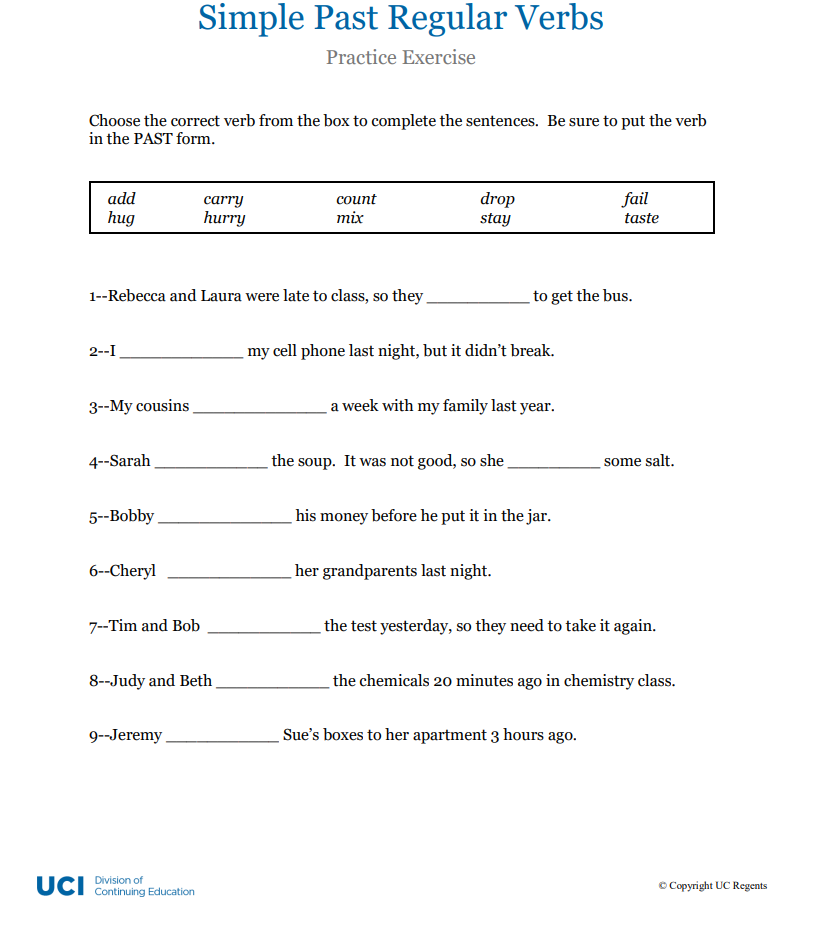
Answer

Simple Past Irregular Verbs
Simple past. Irregular verbs. We went to San Francisco
for a weekend. We took pictures of
the Golden Gate. We bought souvenirs
in Chinatown. We saw the famous
painted houses. We rode on a cable car, and we drove down
a crooked street. This all happened in the past. You know to form a past, we add “ed” to the
verb but look here, none of these verbs end in “ed”. They are irregular; went, took, bought, saw,
rode, and drove. These are all irregular
verbs in the past, and this is what this lesson
is going to be about.
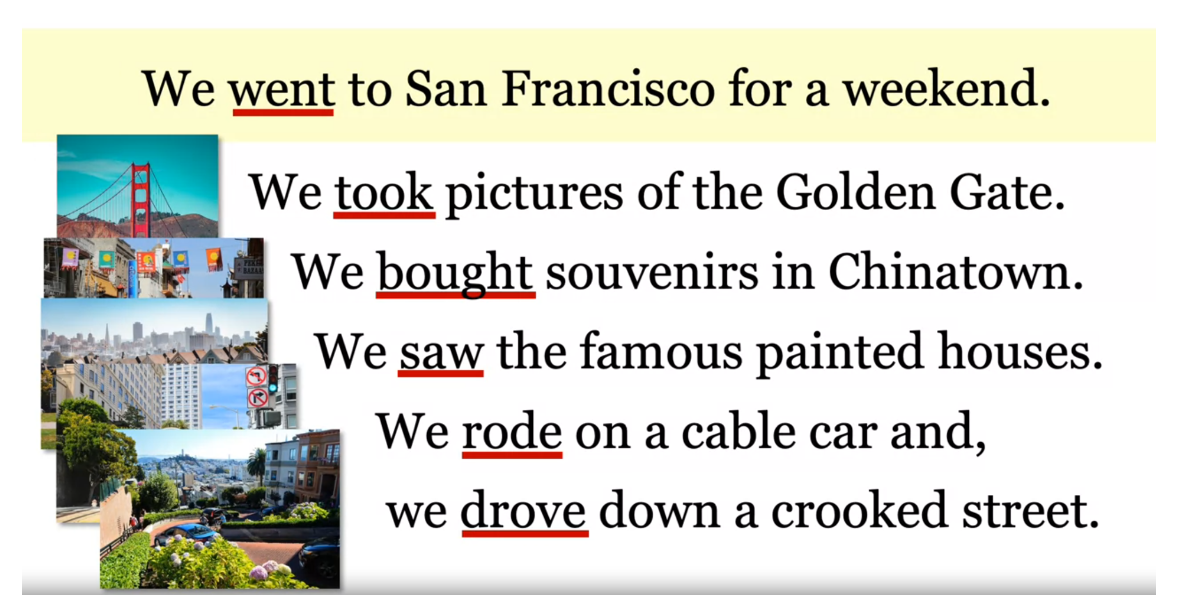
Irregular verbs
don’t end with “ed”. Here are some examples; go, went, have, had, make, made, see, saw, eat, ate, take, took. You can see sometimes
they look like the verb, sometimes they don’t
look like the verb. Here are these verbs in
some example sentences. The students went to
school at 08:00 a.m.
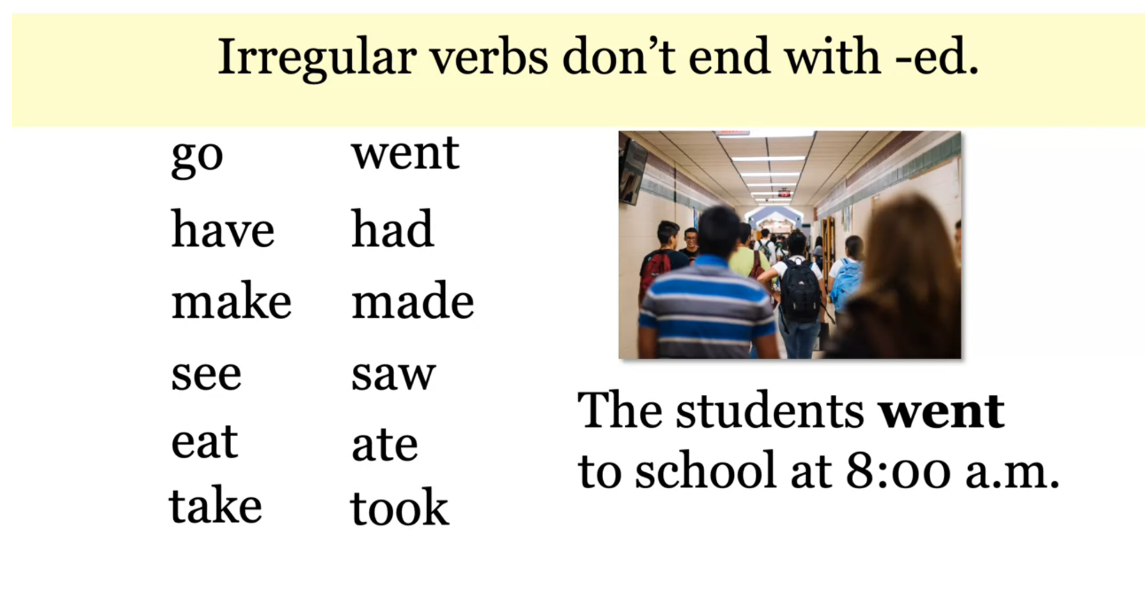
They had classes in the morning. They made a model in
engineering class. They saw some interesting
presentations in English class. They took their lunches
outside and ate at 12:15. It was a typical day at school.
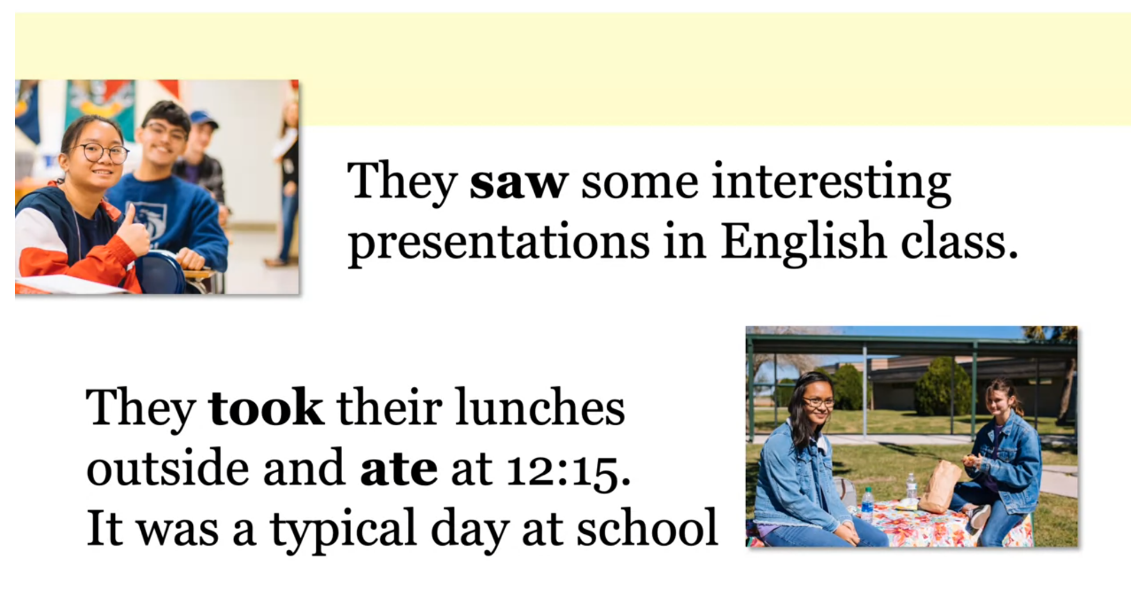
There are many
irregular past verbs. Irregular verbs don’t look
like the simple form. Sometimes they look
almost the same, but sometimes they look
completely different. You can see from this list that there are no
rules to learn, you just have to learn
them as you learn English. In this lesson, we will look at some of the irregular
verbs and put them in groups to help you
see some spelling patterns.
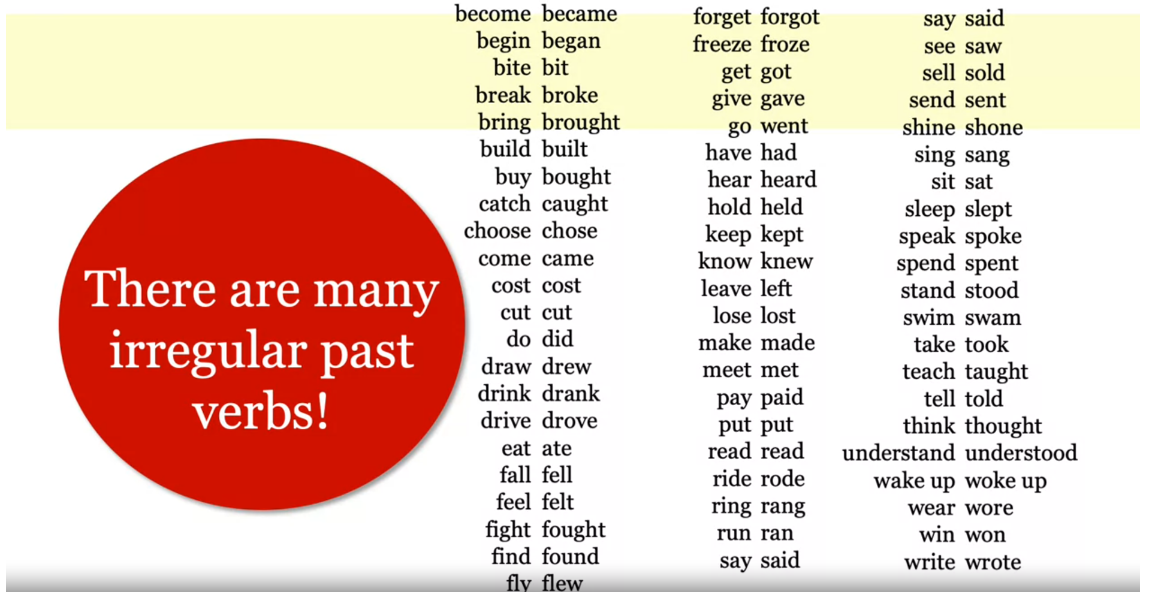
These verbs and with “ew” in
the past; know, knew fly, flew, grow, grew, draw, drew, and blow, blew. Let’s look at them
in some sentences. It was Kate’s
birthday last week.
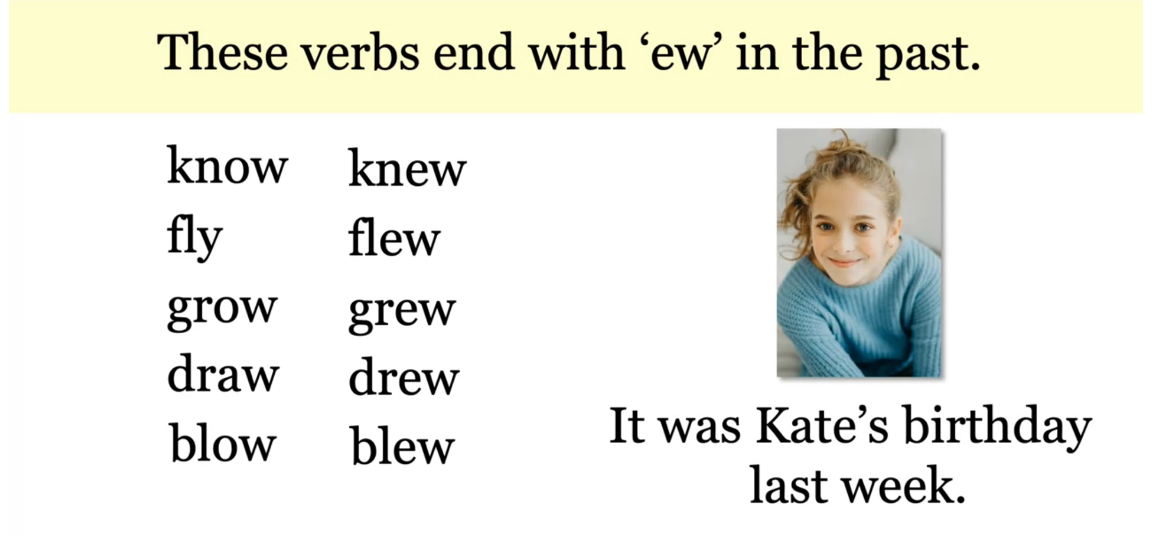
Her parents knew
she wanted a party. Her little brother
drew her a picture. Her big brother flew
home from college. She blew out the candles
and made a wish. These verbs have an “o” in
the past; drive, drove, ride, rode, wear, wore, win, won, and break, broke. The family went to the
county fair last summer.

They drove the bumper cars. Ally rode the horses
on the merry-go-round.
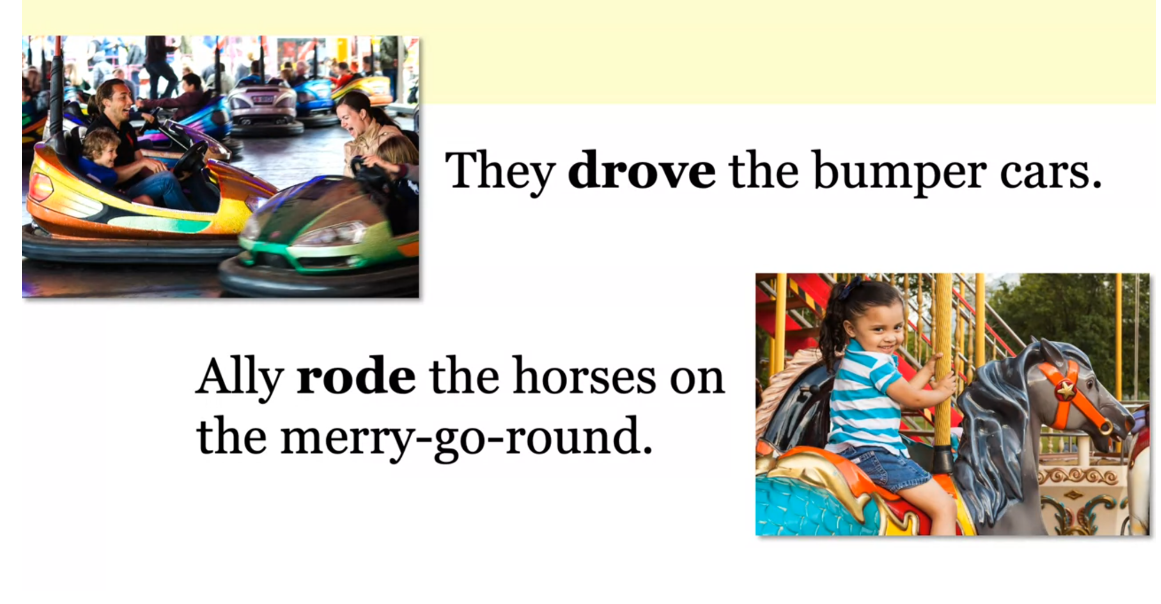
Her brother wore
funny sunglasses. Her father won a prize when he broke a balloon
with a water gun.
These verbs have a “ught” ending in the past;
think, thought, buy, bought, catch, caught, teach, taught, and
bring, brought. You can see that sometimes it’s “ought”, sometimes
it’s “aught”. Here are some sentences. Tanner went fishing last month.

He bought a new fishing pole. He brought all of his equipment. He waited a long time. He thought there were no fish. Finally, he caught a fish. After that, he taught his friend how to fish so they
could fish together. These verbs have an “a” in
the past; sing, sang, drink, drank, run, ran, give,
gave, swim, swam. The friends did a
triathlon together.
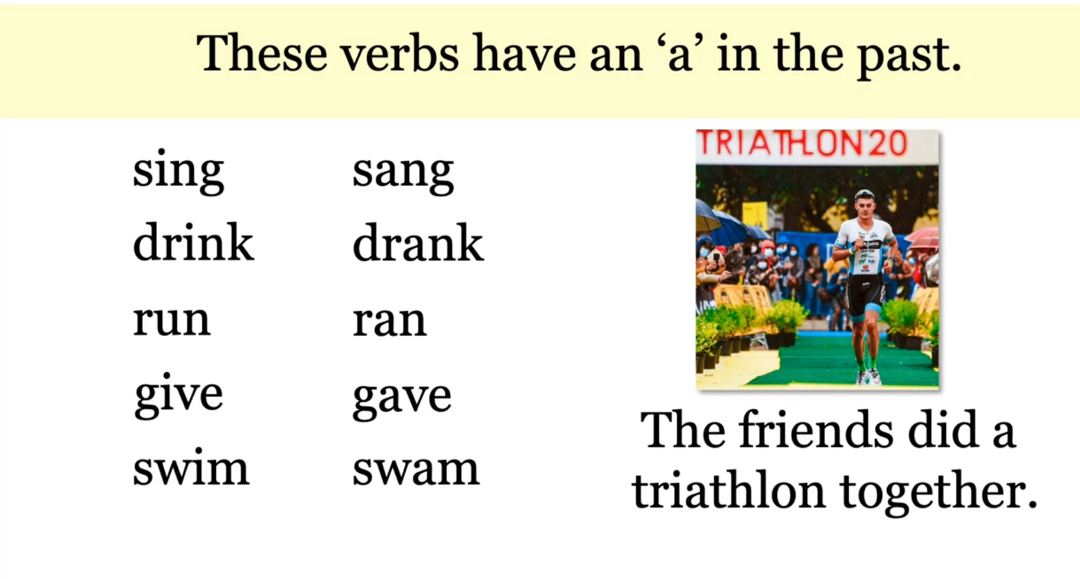
First, they swam
1.5 kilometers,. Then they rode 40 kilometers. People gave them water. They drank a lot. Finally, they ran 10 kilometers. They were so happy to finish
that they sang a song. Maybe they were
too tired to sing.
These verbs end with a “t” in the past; spend, spent, build, built, keep, kept, feel, felt, sleep, slept, leave, left. The families spent
the day at the beach.
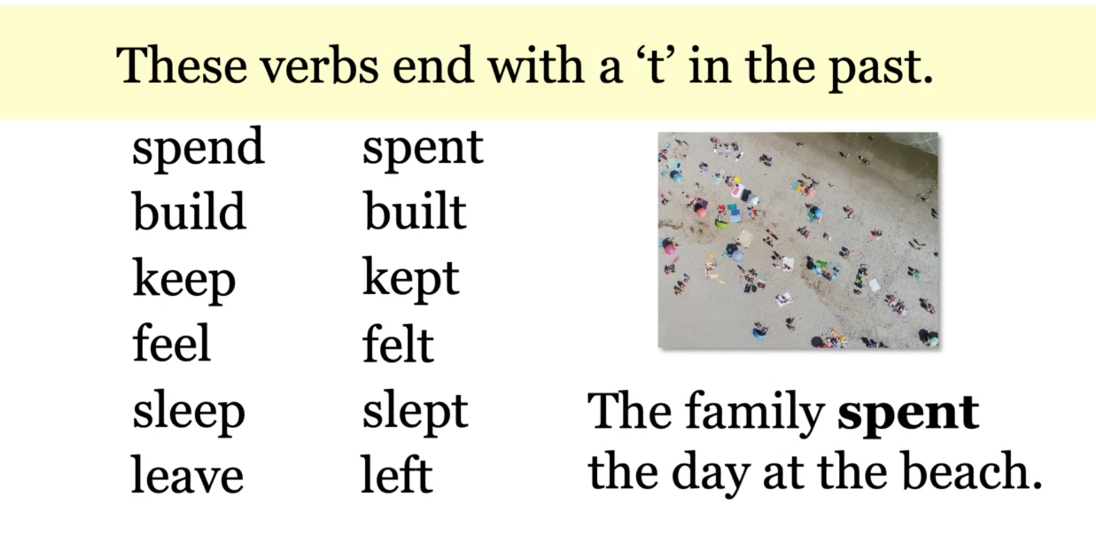
Sam and Katie built
a sand castle. They collected many seashells, but Sam just kept one.

Katie felt tired, so
she slept for awhile. They stayed at the
beach all day. They left at sunset.
These verbs don’t change
in the past; cut, cut, put, put, read, read. Now, look, the
spelling is the same, but the pronunciation
is different. Read in the present and read in the past sounds
like the color red, read, read, fit,
fit, cost, cost. Helena made a dress
for her niece.
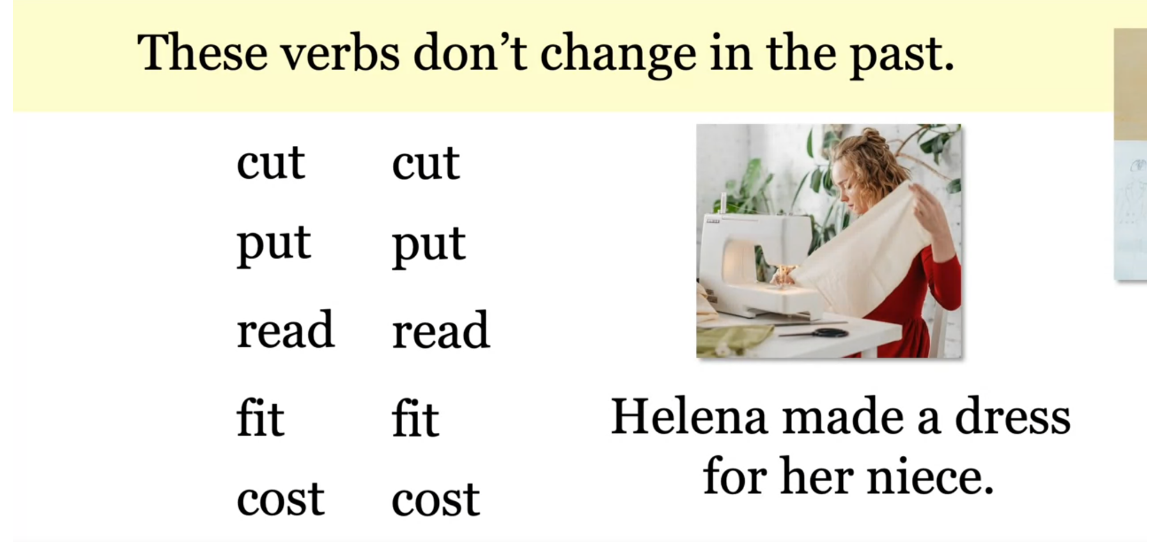
First, she read the directions. The fabric cost a lot. She put the fabric on the
table. Then she cut it. Helena was very happy because the dress fit her
niece perfectly. There are many irregular
verbs in the simple past. This list shows a lot of them, but there are more. You learn them as
you learn English.

Simple Past Irregular Verbs (Practice Exercise)
Exercise
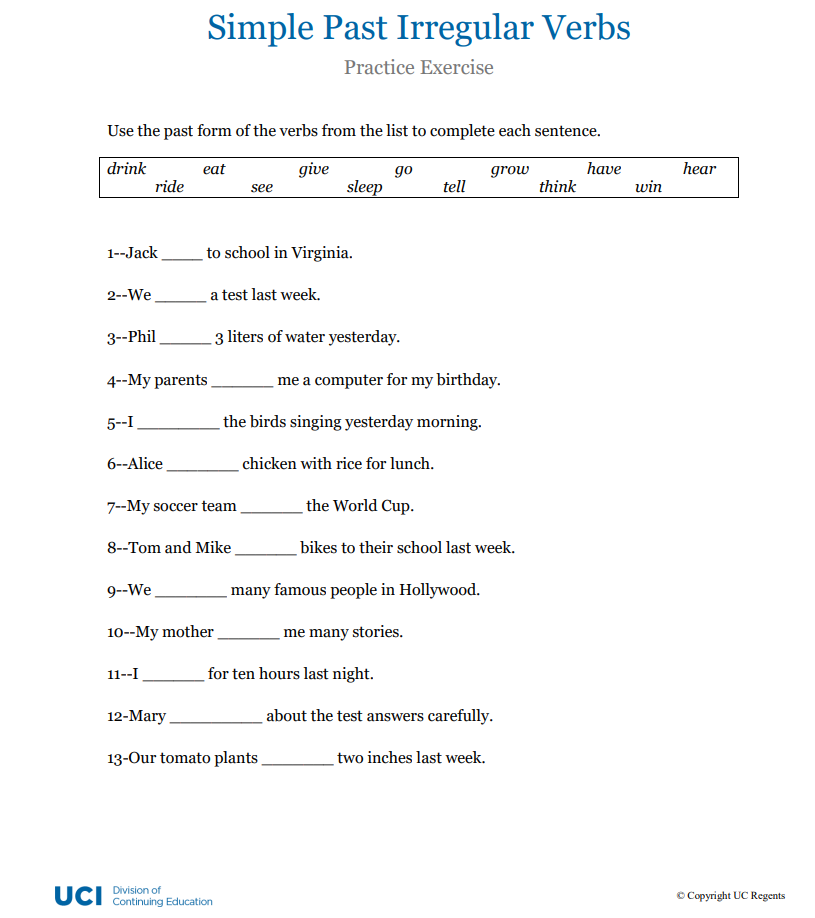
Answer
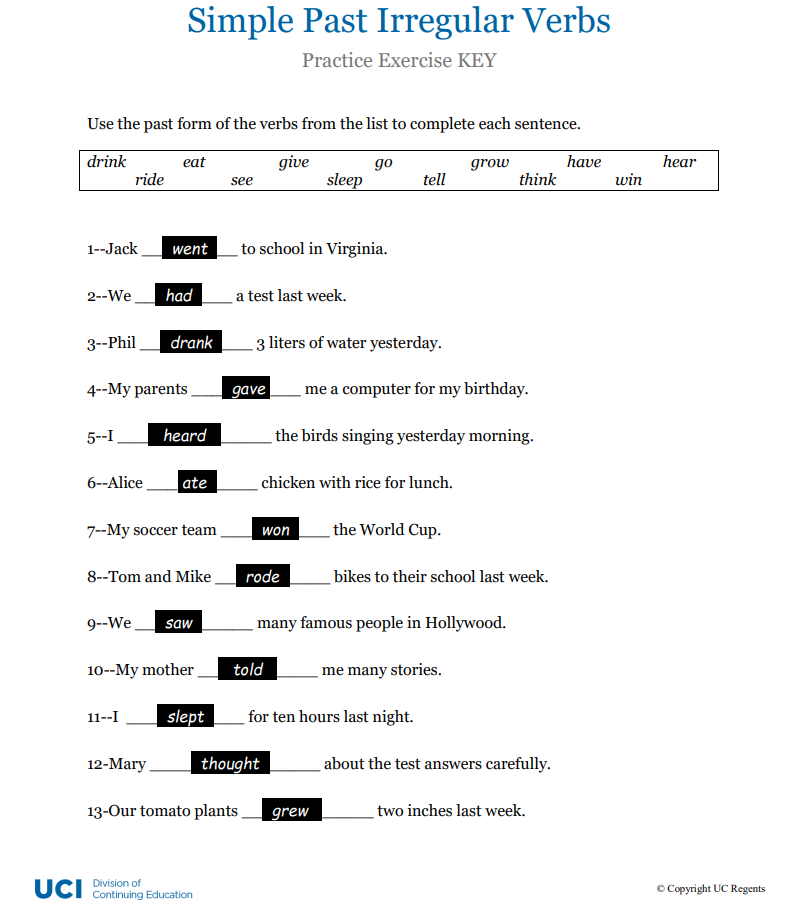
Quiz: Simple Past with Regular & Irregular Verbs
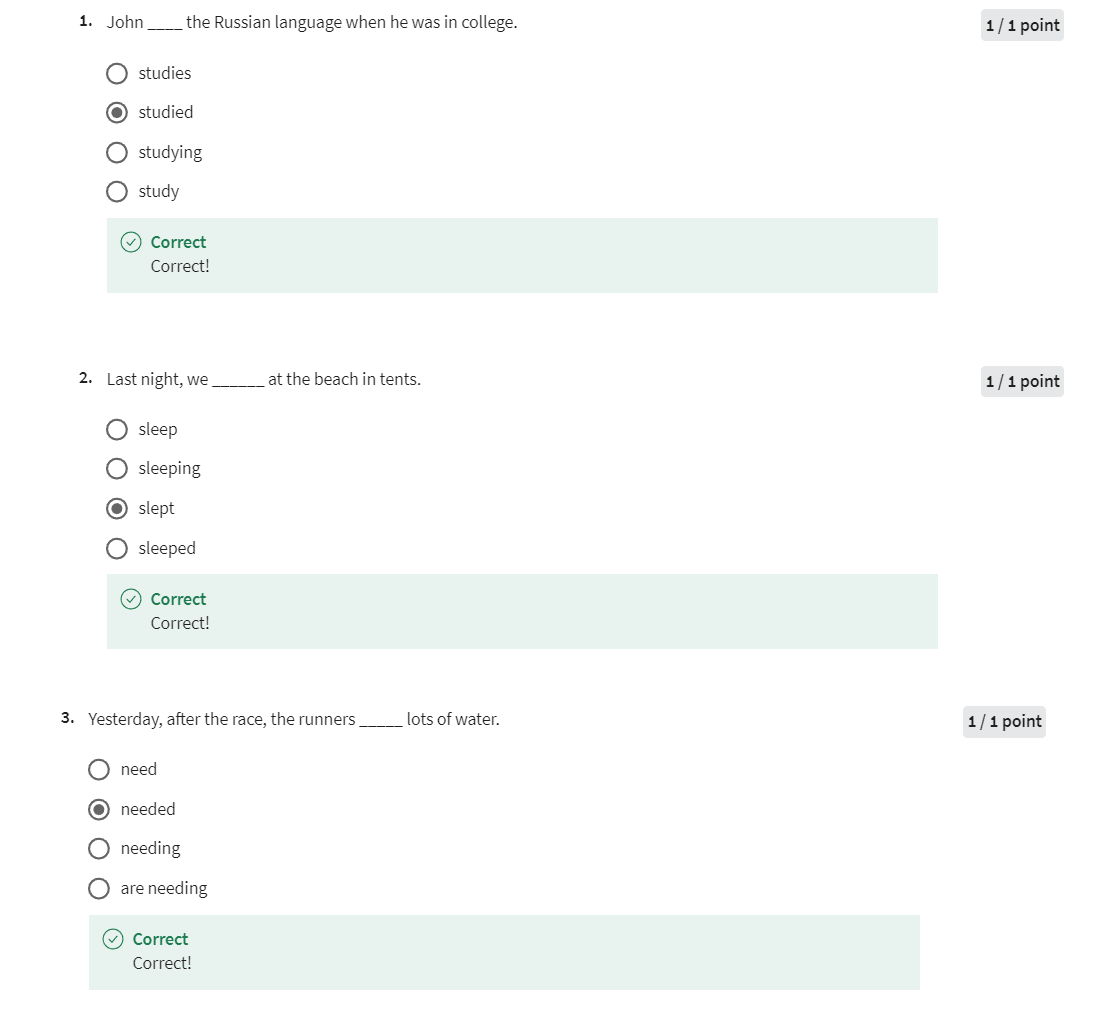
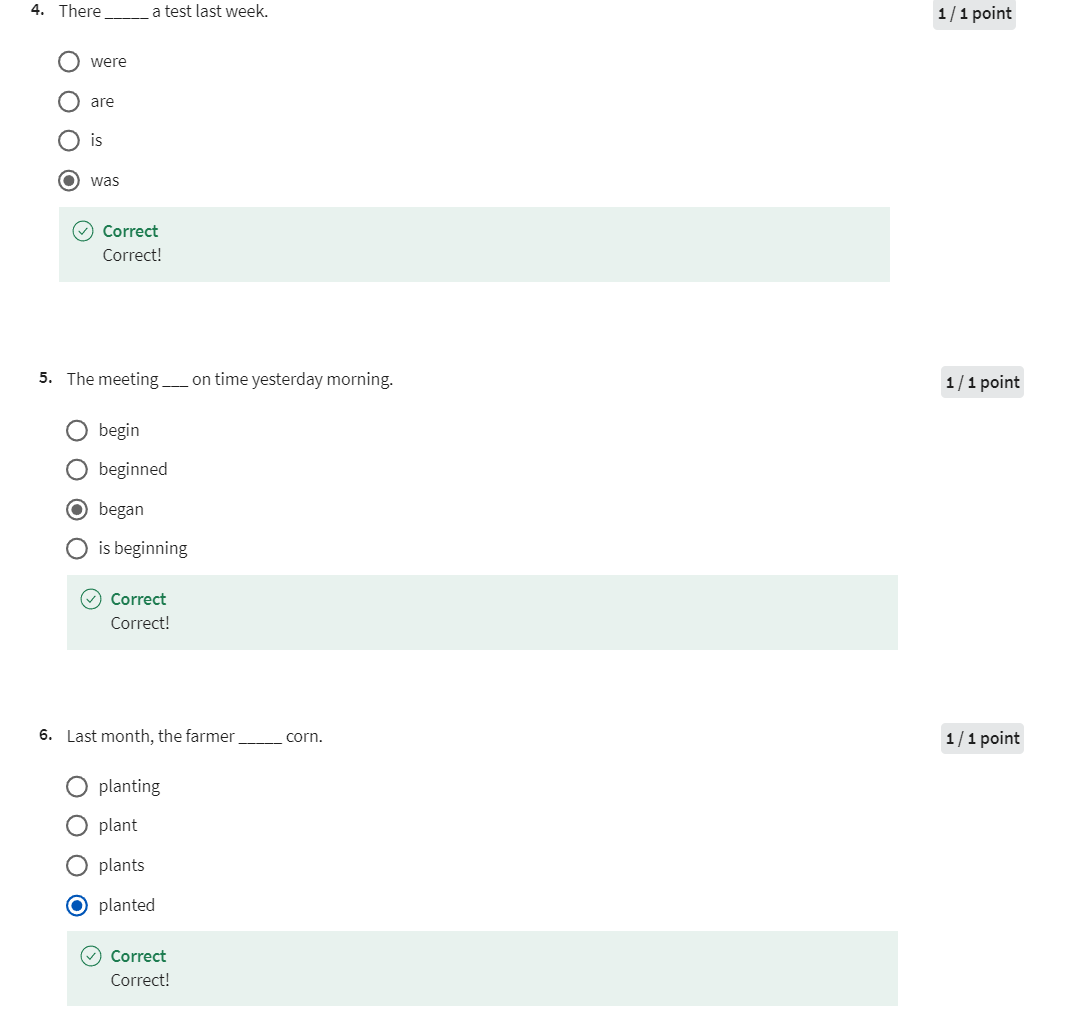
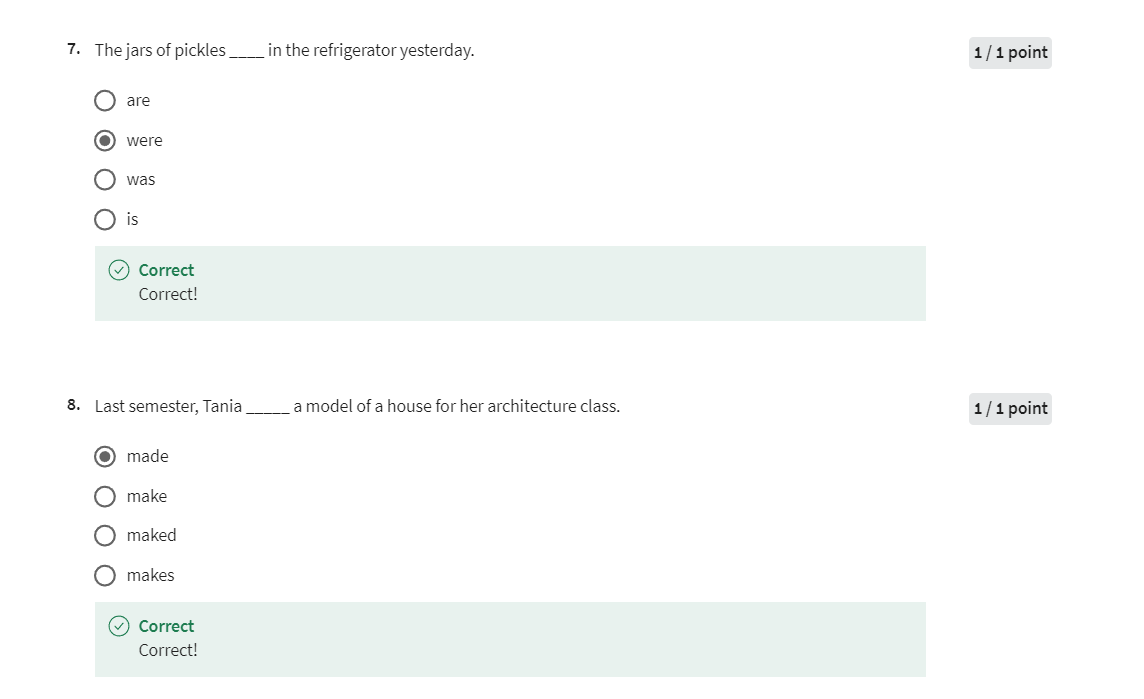

Week 02: Simple Past Negative & Object Pronouns
This week, you will learn about how to form the negative of the simple past. It is different for BE and for all other verbs. The good news is that in the negative form there are no irregular forms. You will also learn about object pronouns. You will learn the difference between the pronouns “she” and “her,” and “he” and “him.”
Learning Objectives
- Form negative statements in the simple past.
- Recognize differences between subject pronouns and object pronouns.
认识主语代词和宾语代词的区别。
Simple Past Negative BE
Past Negative BE. Joe and Brian went to
the movie theater last Friday. Unfortunately the movie
was not interesting. The popcorn wasn’t fresh. The tickets weren’t cheap. Joe and Brian were not happy. Look for
the negative forms of the BE verb here. Here we have was not and here wasn’t, here is word and here is we’re not. These are the ways we form
the negative of BE in the simple past.
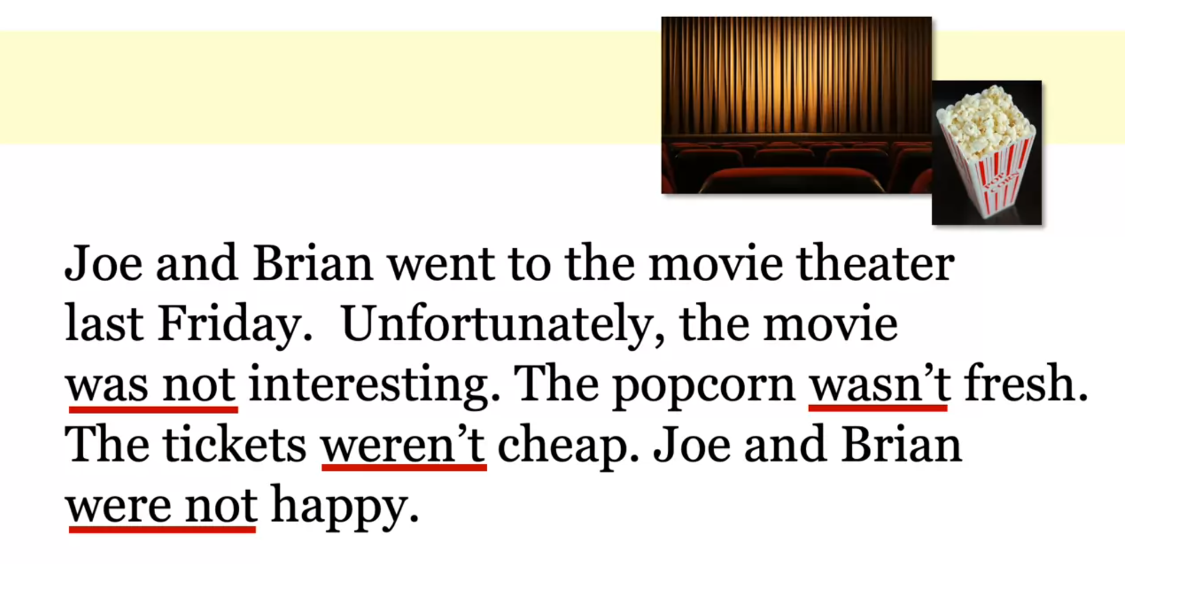
Use was, or were and not to form
the negative of BE in the past. The movie was not interesting. They were not happy.
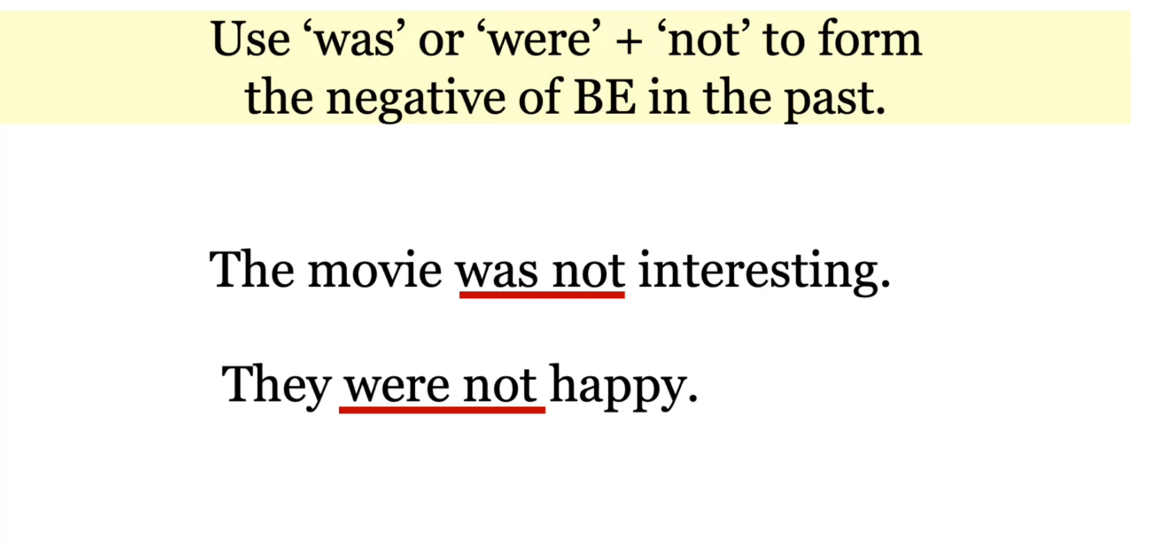
There are two ways. The first way is add
not after the BE verb. You know this already, I was not,
you were not, he was not, she was not, it was not, we were not,
you were not, they were not. It’s all the same. Just add the word not. The second way is make
a contraction with BE and not. So this time to make the contraction,
I was not. We dropped the o and not. We push these letters together and
of course there is an apostrophe. I wasn’t, you were not. Same thing we dropped the o and not. We push these letters together so
we have one word and then the apostrophe you weren’t. And since there are only two forms was and
were in the past, the rest follow the same pattern. He wasn’t, she wasn’t, it wasn’t and
all the plural are the same. We weren’t, you weren’t, they weren’t, okay.
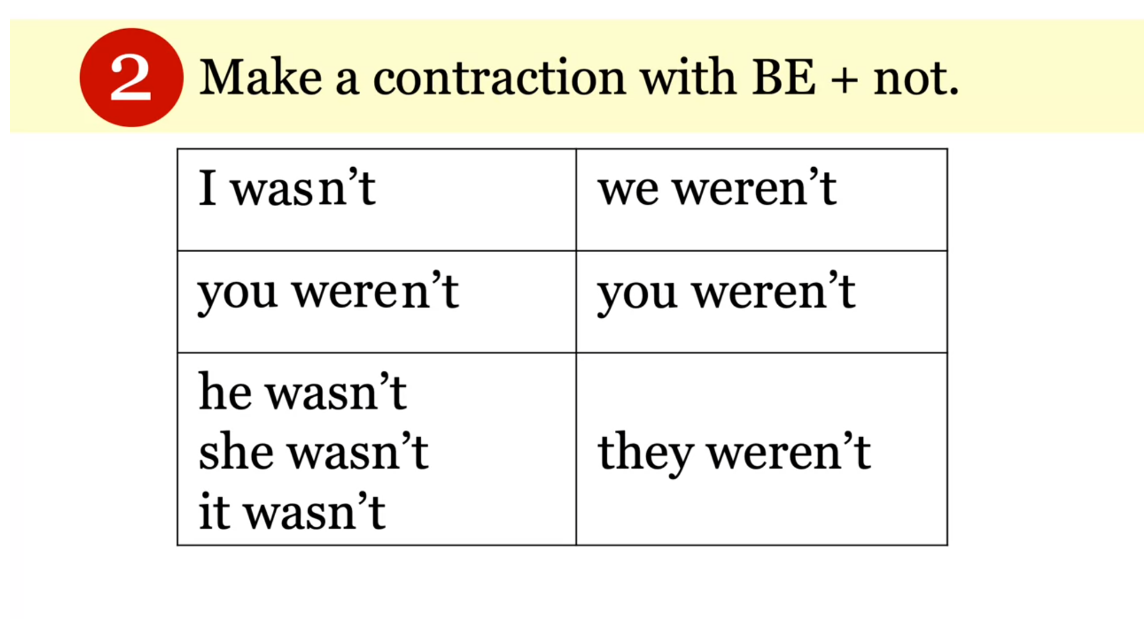
You try look at the sentences, fill in
the blanks with the negative past of BE. What do you need? Was not or were not. Ready? Ryan had a good day,
he was not late to school. His classes, we’re not boring. His homework was not hard, so
he was not awake very late at night.
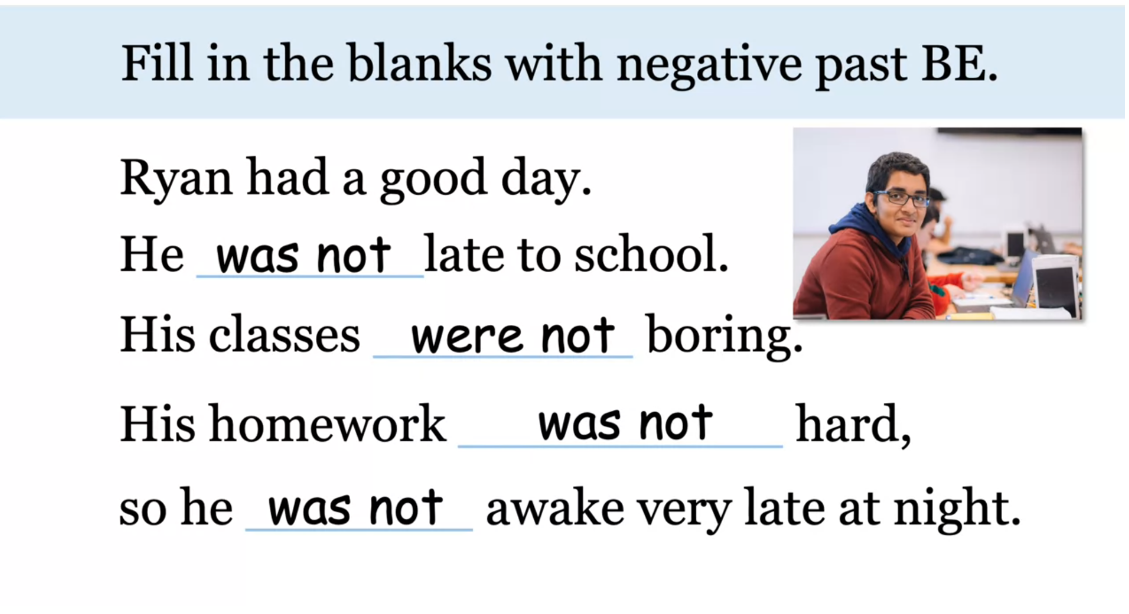
Okay, now can you change all
of these two contractions? Let’s look, Ryan had a good day. He wasn’t late to school. His classes weren’t boring. His homework wasn’t hard, so
he wasn’t awake very late at night. Okay. One more time this time
just use contractions. Take a moment. Look at the sentences and
decide between wasn’t and weren’t. Okay, are you ready. Andres had a terrible day. He had a big project to finish. His boss wasn’t happy. His colleagues weren’t helpful. The office wasn’t quiet, so
he went outside to work, but his computer wasn’t charged,
or Andres.
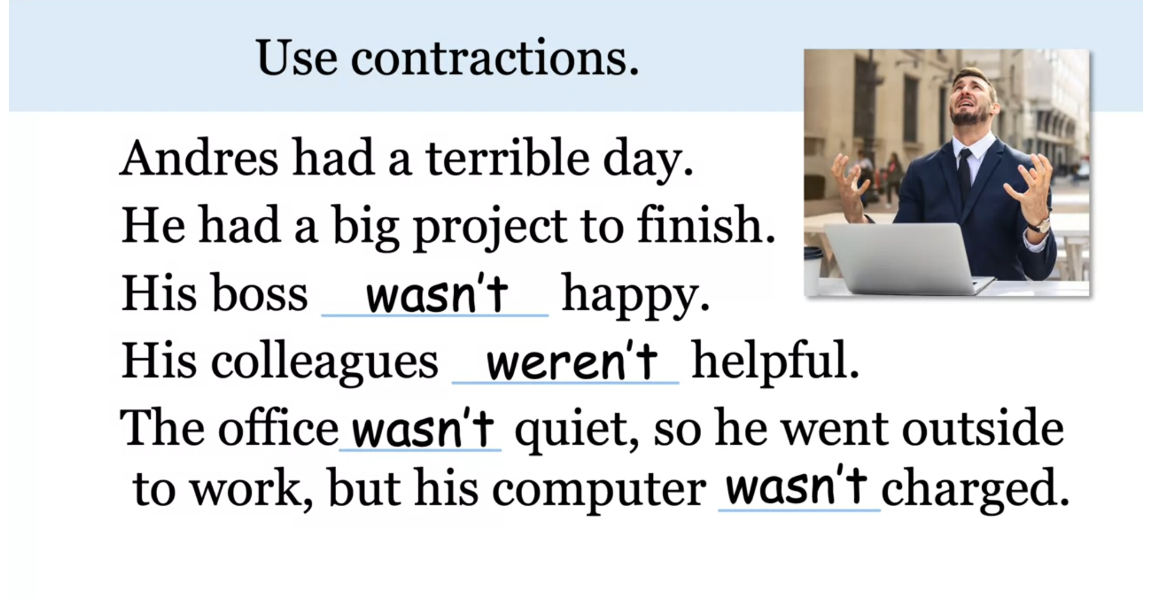
Use was or were plus not to form
the negative of BE in the past. His classes were not boring,
his computer was not charged. We’re not and was not change to weren’t. And wasn’t when we make the contractions.
Simple Past Negative BE (Practice Exercise)
Exercise
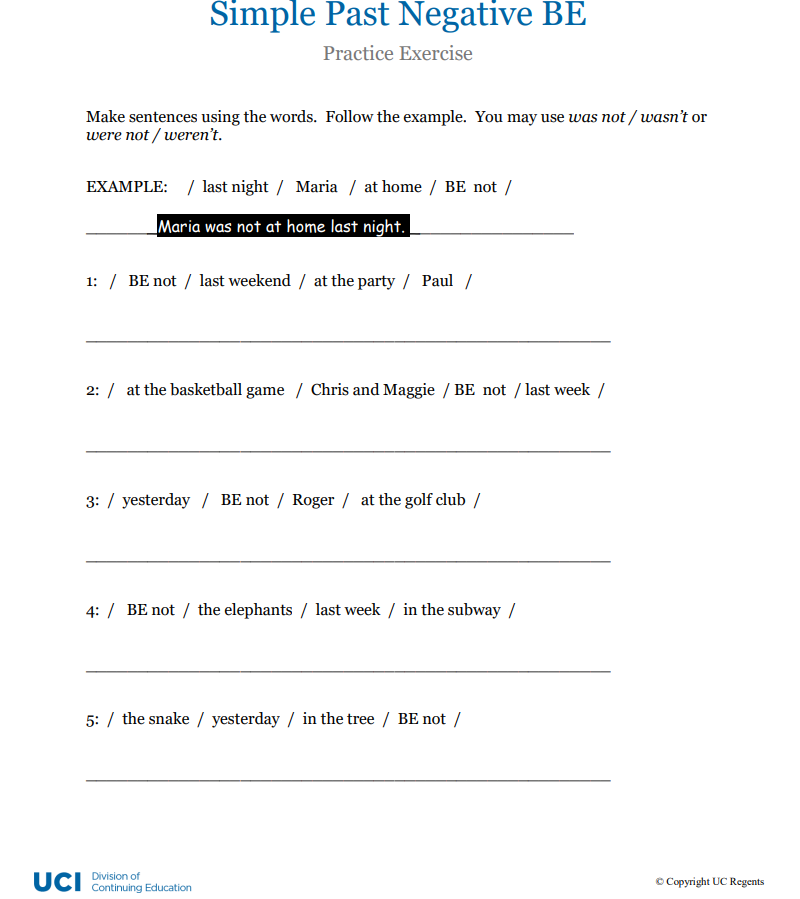
Answer
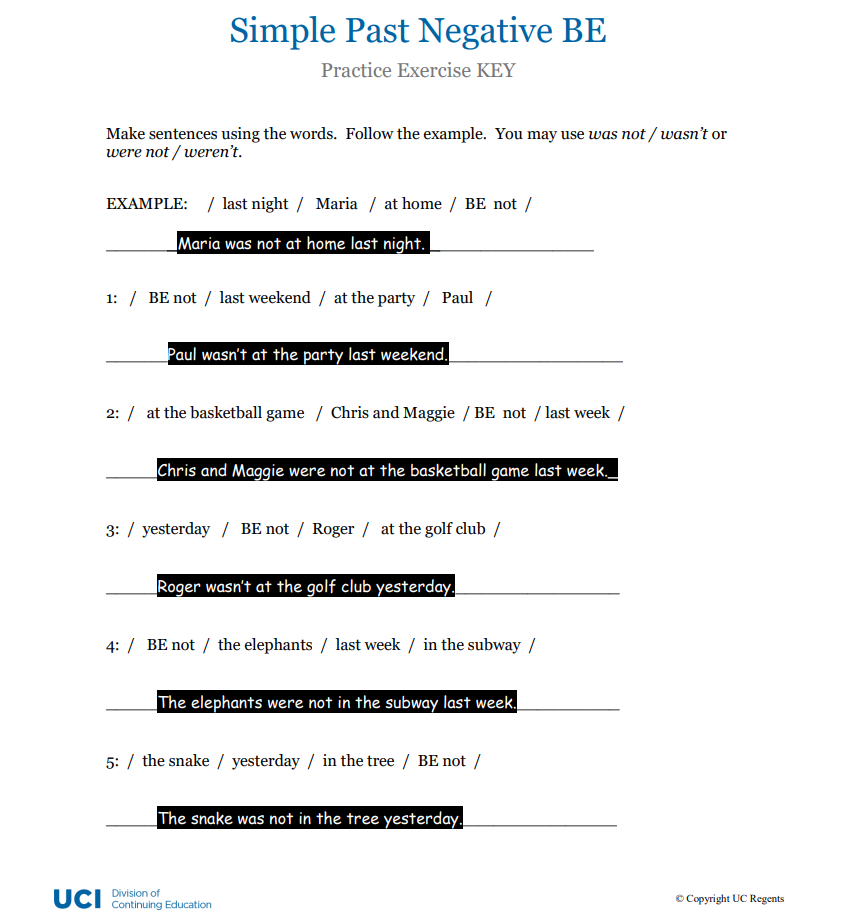
Simple Past Negative Verbs
Simple past negative. Sam wanted to visit a friend at his new apartment
in the city, but he had some problems. He did not remember this street, he did not know the address, and he didn’t have the
right phone number. Do you see the negative forms? You probably see not. He did not remember. We use did not to
form the negative in the past with all
verbs except BE. BE always has some
different rules. Here we also see, did not know, and didn’t have.

Let’s look at how to form these. To form the negative, use did not, and the verb. Here you have the
chart for have, in the simple past. I had, you had, he had. There’s just one form. It’s the same for the negative. Look at I had. This is how you
make the negative. Move the verb over, put in did not. But look here. We don’t want this
to be in the past. We want the simple form. We change it back to have. I did not have, you did not have, he did not have, she did not have, it did not have, we did not have, you did not have, and they did not have. As you can see, there is only one form.
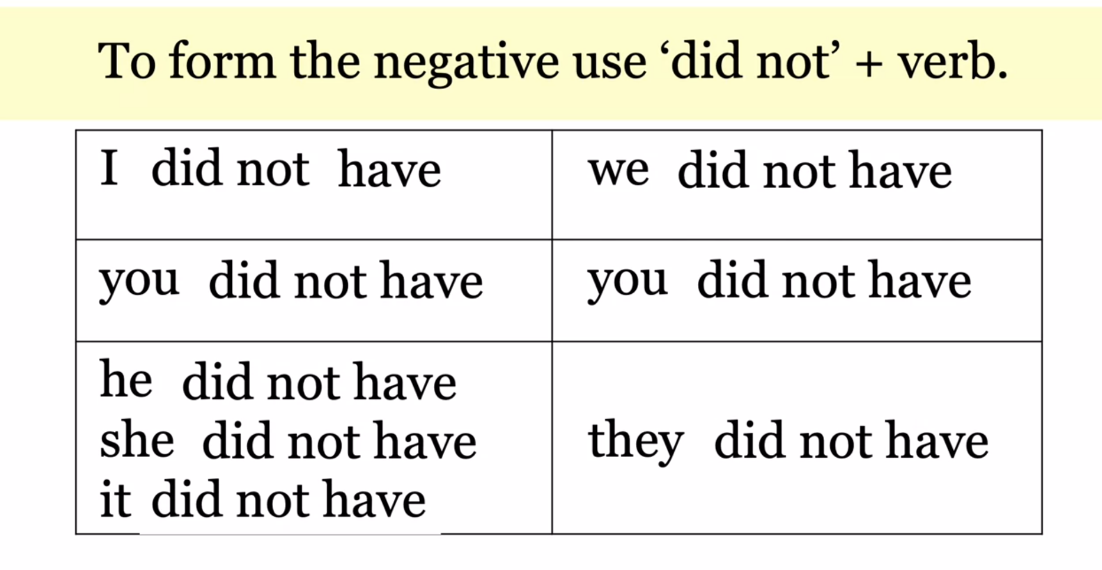
But we can make a
contraction. Let’s look. Form a contraction
with did and not. Look at the sentence, he did not remember. To make the contraction, drop the o in not, move the n and the t
over to form one word. Of course, remember,
we need an apostrophe. He didn’t remember. He did not know the address. He didn’t have the phone number. We have two ways to
say the past negative. That is with did not and didn’t.
Let’s look at some examples. Use did not or didn’t
to form the past. It’s the same for all subjects. Look at these sentences. I did not read that book. You did not call me. She did not travel last year. We did not eat all of the pizza. They did not bring an umbrella. I can change all of
these to didn’t, because it doesn’t matter
what the subject is. It’s always did not or didn’t. Notice, the verbs are
all in this simple form. They are not in the past. The verb doesn’t change.
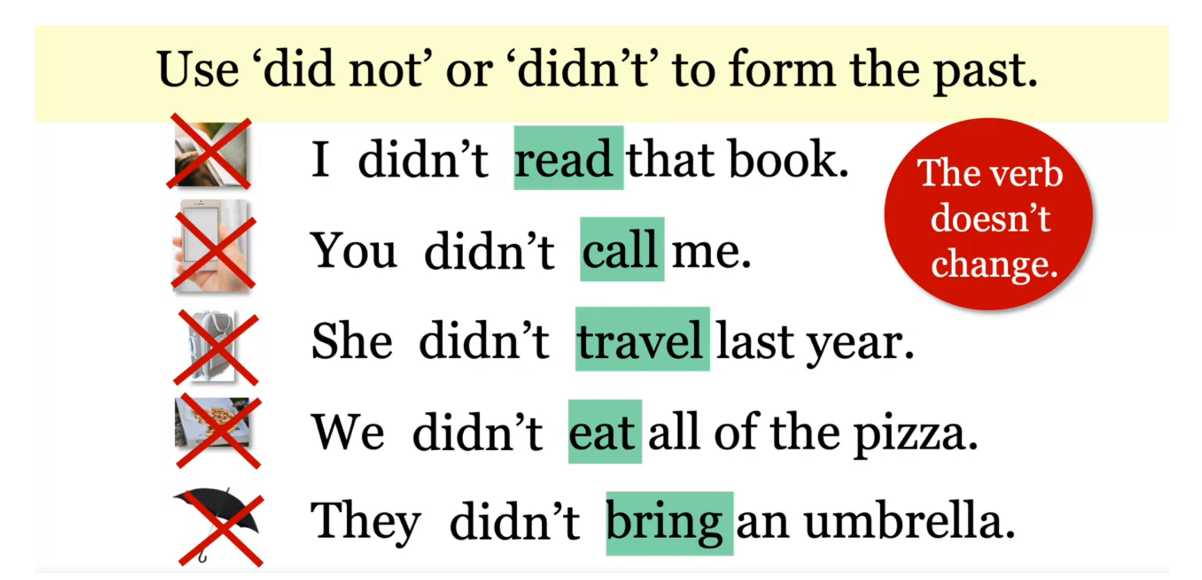
The verb stays in
the simple form. It’s the same in
present and past. Remember, in present, she
doesn’t swims is incorrect. We’ve got an extra s on swims. We have the s in doesn’t. We don’t need the s
on swims anymore. She doesn’t swim. It’s the same in the past. You called me, that ed
shows us it’s the past. When we change it
to the negative, you did not call me, now, the did shows me
it’s in the past. I don’t say, you
did not called me. I’ve got an extra ed here, just like the extra s up above. The main verb, swim and call, they stay in the simple form.
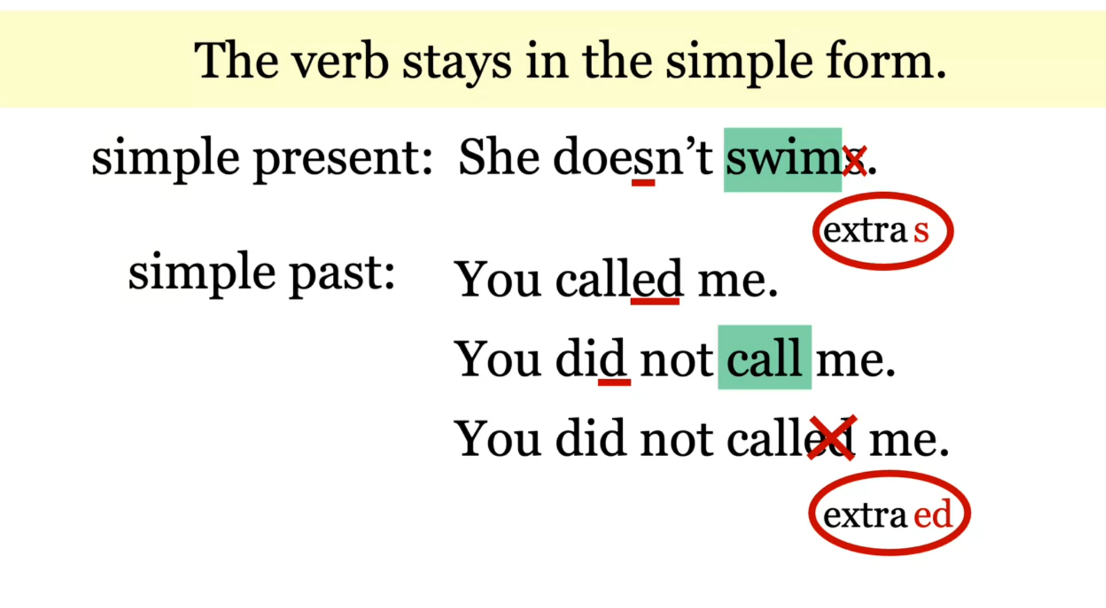
Let’s do some practice. Make it negative. He liked the lemon. No. He did not like the lemon. Now, change did not
like to a contraction. He didn’t like the lemon. It was too sour.
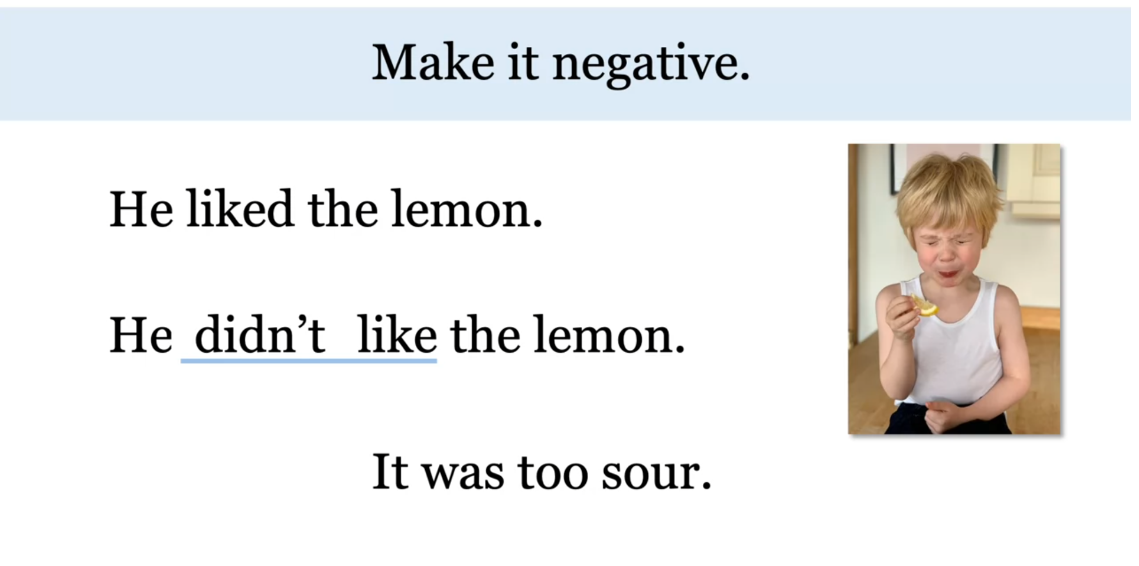
They stayed at home. Make it negative. They did not stay at home. Now make the contraction. They didn’t stay at home. They went for a walk. Make it negative. Rich’s dog walked with him. Rich’s dog did not
walk with him. The contraction, Rich’s
dog didn’t walk with him. His dog didn’t want to walk. Form the past negative
with did and not. He did not know the address. He didn’t have the phone number. You have two choices. You can use did
not and the verb, or you can make a contraction, and use didn’t and the verb.
Simple Past Negative Verbs (Practice Exercise)
Exercise

Answer
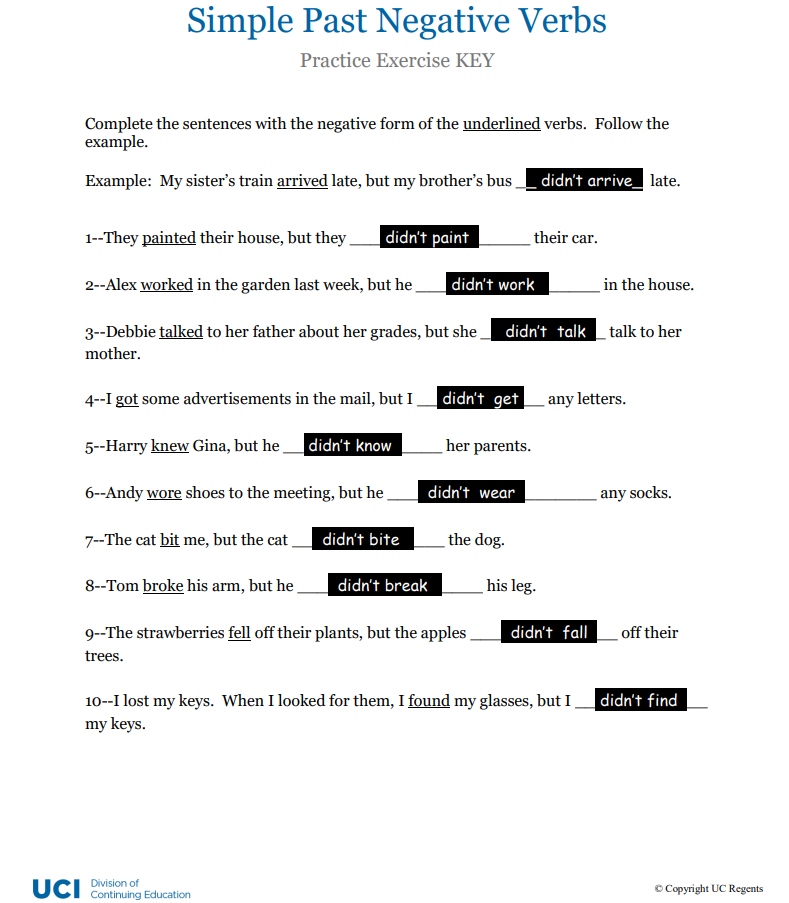
Object Pronouns
Object pronouns. You already know
subject pronouns. I, you, he, she, it, we, you, and they, you hear
them all of the time. Remember, a subject does
the action in a sentence.
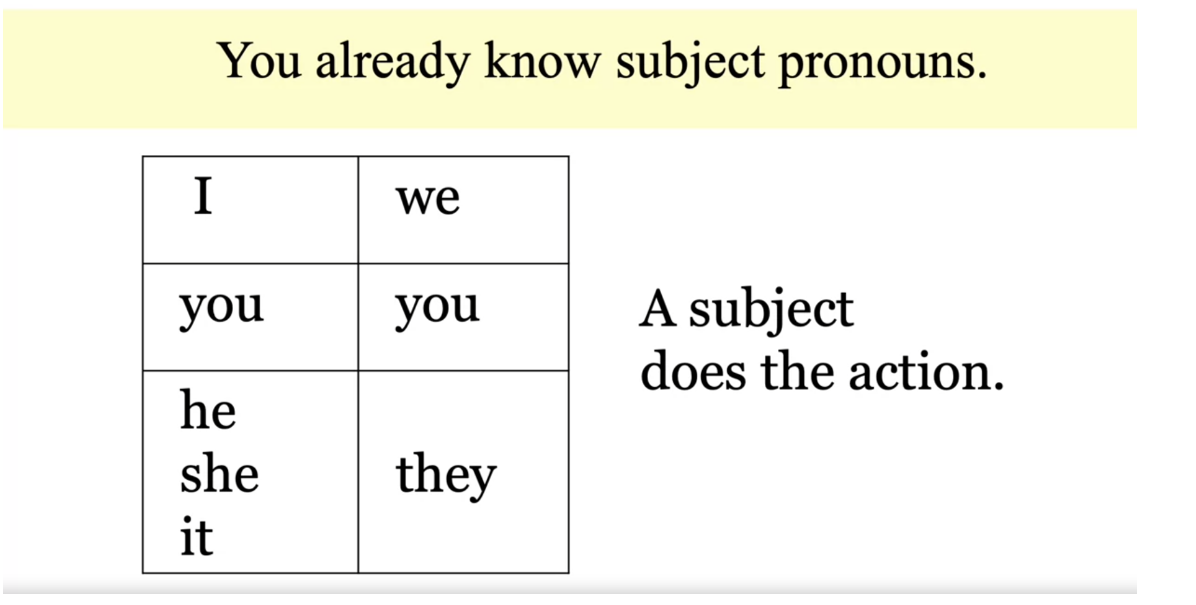
Here’s the chart for
object pronouns. You’ve probably seen these too. Me, you, him, her, it, us, you, and them. An object doesn’t do the
action in a sentence. An object receives the action or the result of the
action.
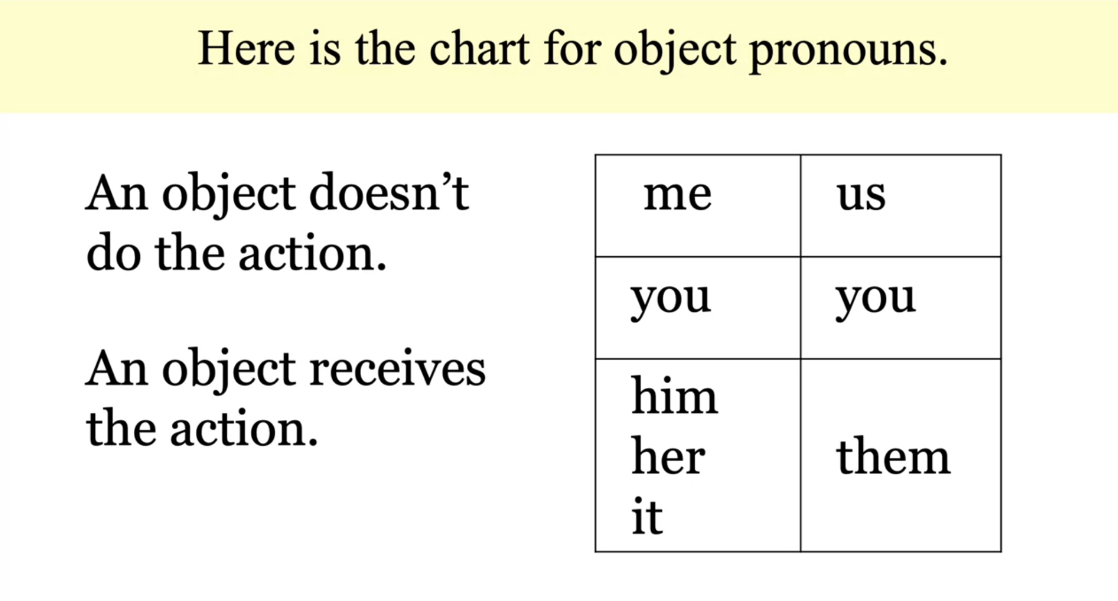
Let’s look. The kids are throwing
water on Jim. Let’s look at this sentence. First, what’s the subject? The kids, right? The kids are the subject
because they are throwing. Now, what’s the object? The object is the thing
that the kids are throwing, so that’s the water. The water here is the direct object because
the kids are throwing it. Now, we still have
Jim over here. The kids aren’t throwing Jim, but he’s still gets
wet from the water. So Jim is an indirect object. If I shorten this
sentence and replace all of these nouns
with pronouns, I get they are
throwing it on him, and in this sentence, the kids, are they. The water is it, and Jim is him. It may seem complicated, but we use the same
object pronouns, whether it’s a direct object
or an indirect object.
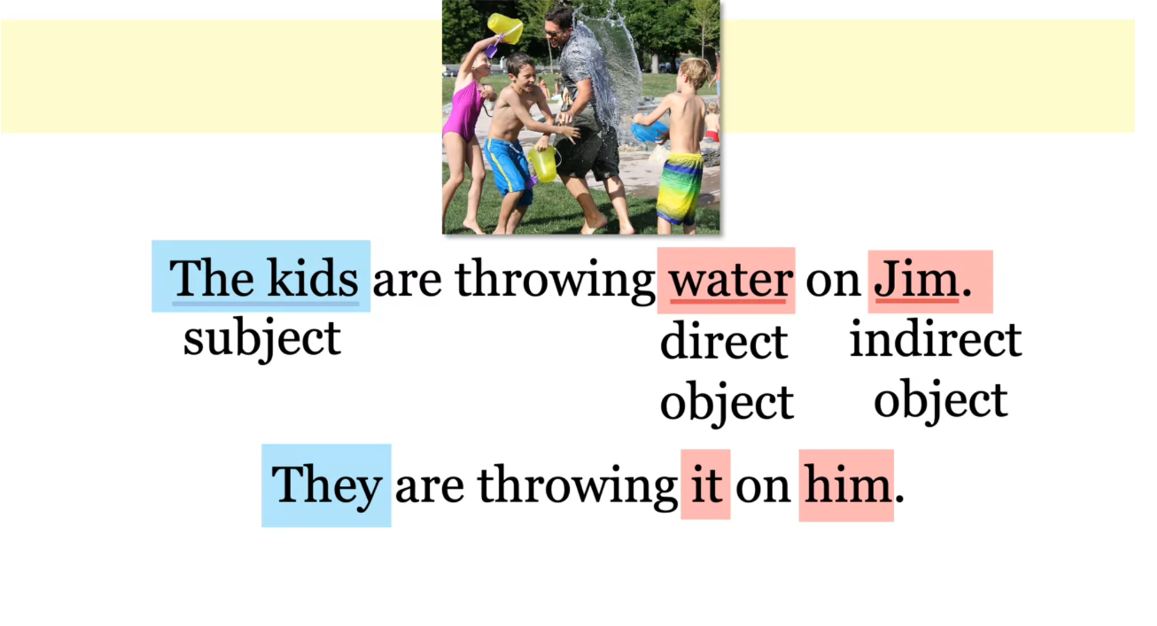
Let’s look at another example. She gives the blue
envelope to him. In this sentence. She is the subject and the word she is
the subject pronoun. Over at the other end, him. Him is the object pronoun because he receives
the envelope, he’s not doing the action, so we can’t use He.
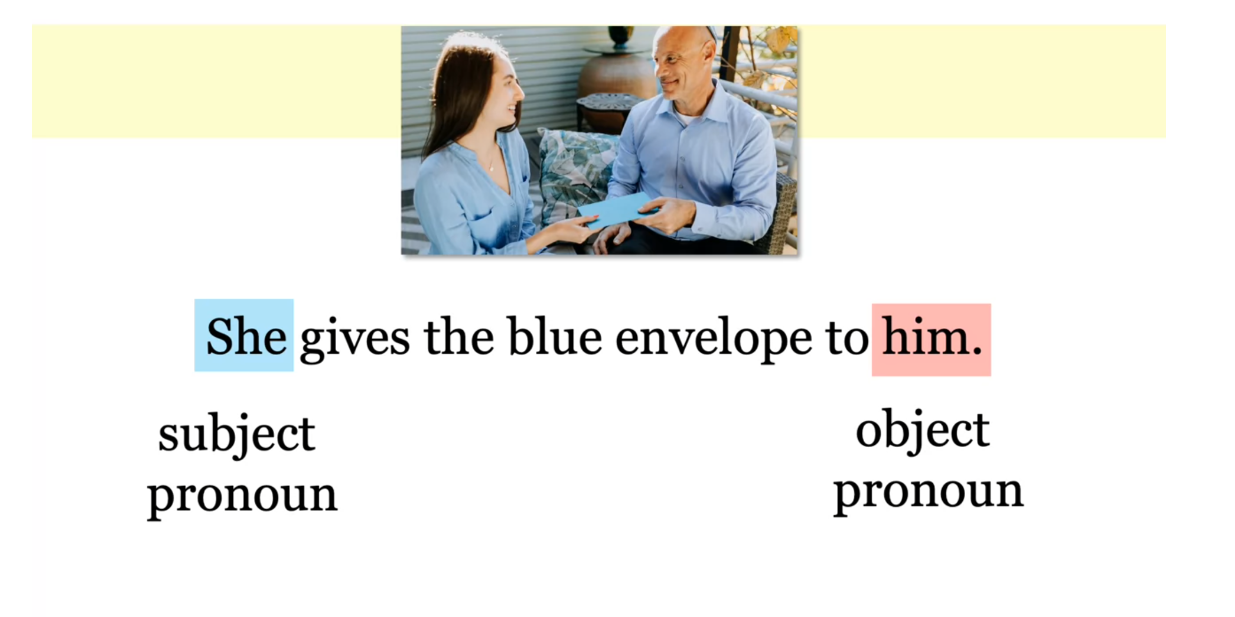
Let’s switch it. He gives
the blue envelope to her. Now, he is the subject pronoun, I don’t use Him, and her is the object pronoun, I can’t use she because she
isn’t doing the action. She’s receiving the envelope. If we look at both
sentences side-by-side, you can see these are
the subject pronouns, and these are the
object pronouns.
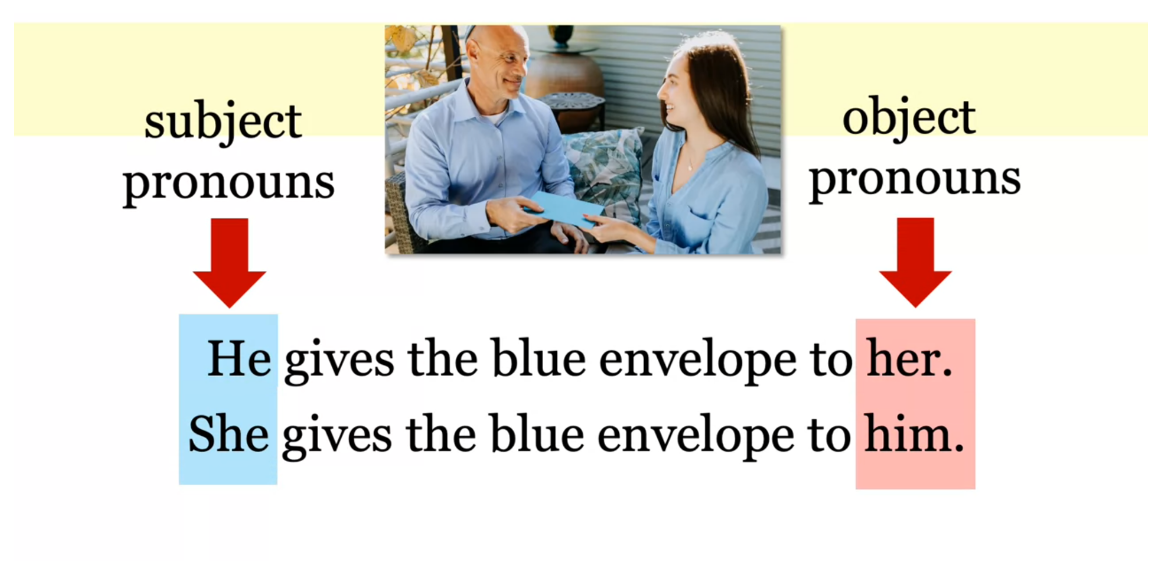
Here are both charts
side-by-side. These are the subject pronouns and these are the
object pronouns. You can see, you is the
same for both charts, and it is also the same, but the other pronouns change.
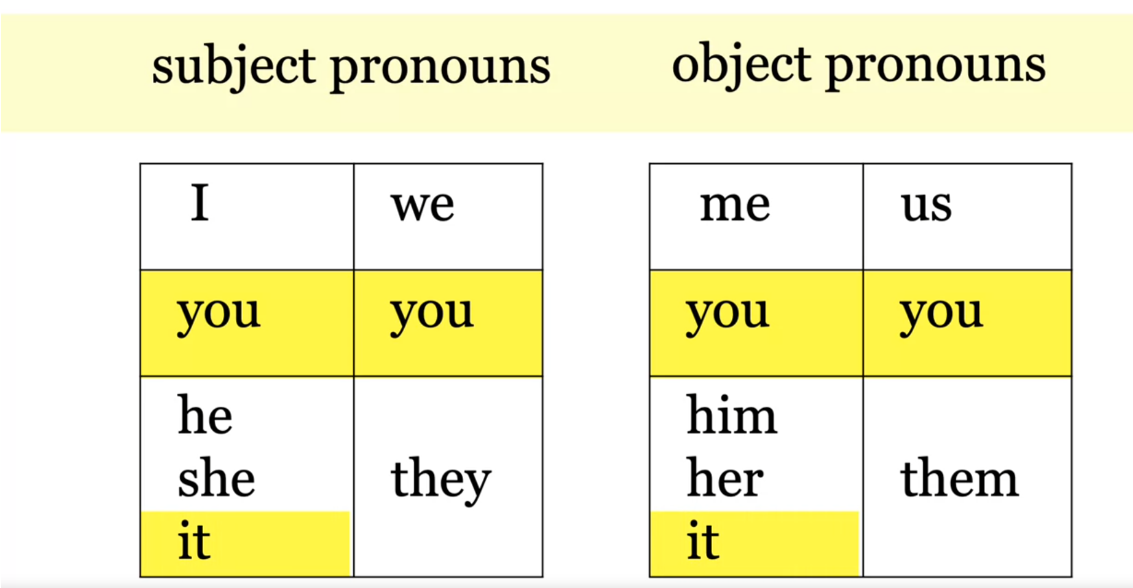
Let’s look at some
more examples. Lily is looking at you. Lily is the subject
because she is looking and you are the object because you
are receiving her looking. If we replace these
with pronouns, Lily, is a she, and you stays the same, so she is looking at you. Mandy checked the price. Here, Mandy is the subject
and price is the object. If we replace these with
pronouns, she checked it. She is Mandy, and
it is the price. Here’s another. “Smile. I
am taking a picture of us.” In this one, I is the subject, because I am taking and us is the object because the picture
is being taken of us. We aren’t taking the picture. “Are you listening to
me?” How about here? Still, you is the subject, and me is the object. You is the subject pronoun
and me is the object pronoun. Even when it’s a question. Her brothers are
looking for her. Now this might look confusing, but if you remember. This her is a
possessive adjective and this her is an
object pronoun. Oh, sometimes it
can be confusing.
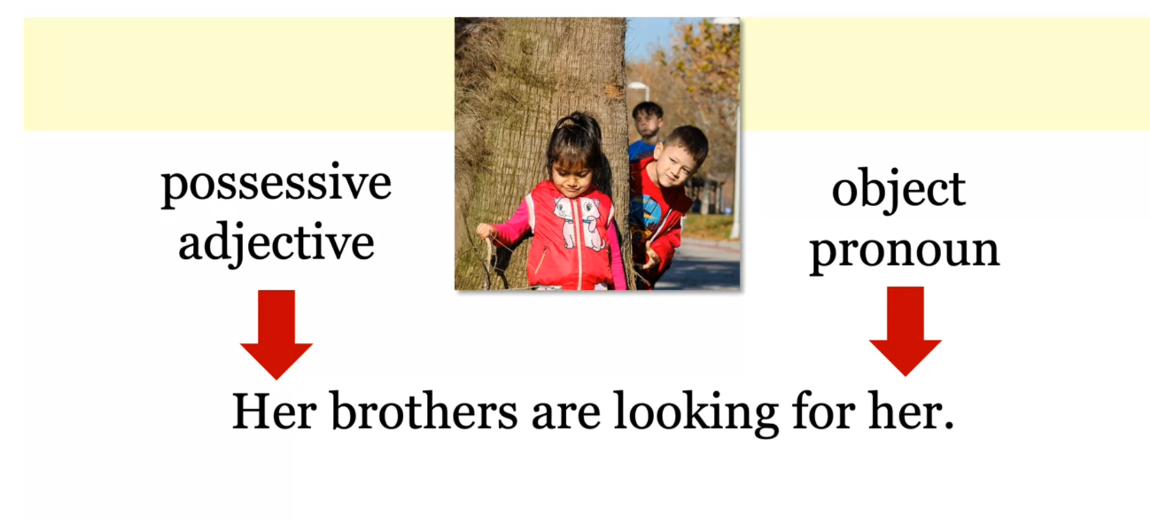
Let’s do some practice. Rob gives a drink to Scott. Can you replace Rob
with a subject pronoun? He. He gives a drink
to Scott and now, can you replace Scott
with an object pronoun? He gives a drink to him.

Professor Kaye is explaining
the task to the students. Replace Professor Kaye
with a subject pronoun. He. He is explaining the
task to the students. Now, let’s replace students
with an object pronoun. He is explaining
the task to them. He’s explaining
the task to them. One more. The children
listen to their grandmother. Can you replace the children
with a subject pronoun? They. They listened
to their grandmother, and now, let’s replace the grandmother with
an object pronoun. They listened to her.
They listened to her. In this lesson, you learned
the difference between subject pronouns and
object pronouns. These are the subject pronouns. The subjects do the action, and here are the subject
pronouns in sentences. These are the object pronouns. The object pronouns received the action or the
result of the action, and here they are
in the sentences.
Object Pronouns (Practice Exercise)
Exercise
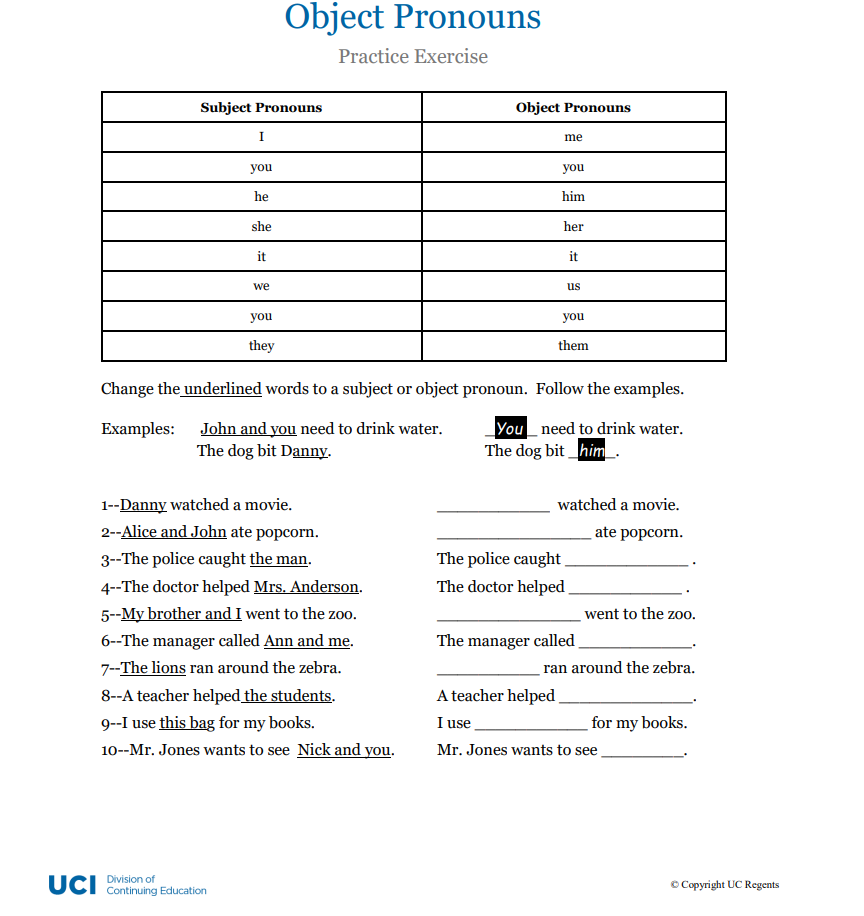
Answer
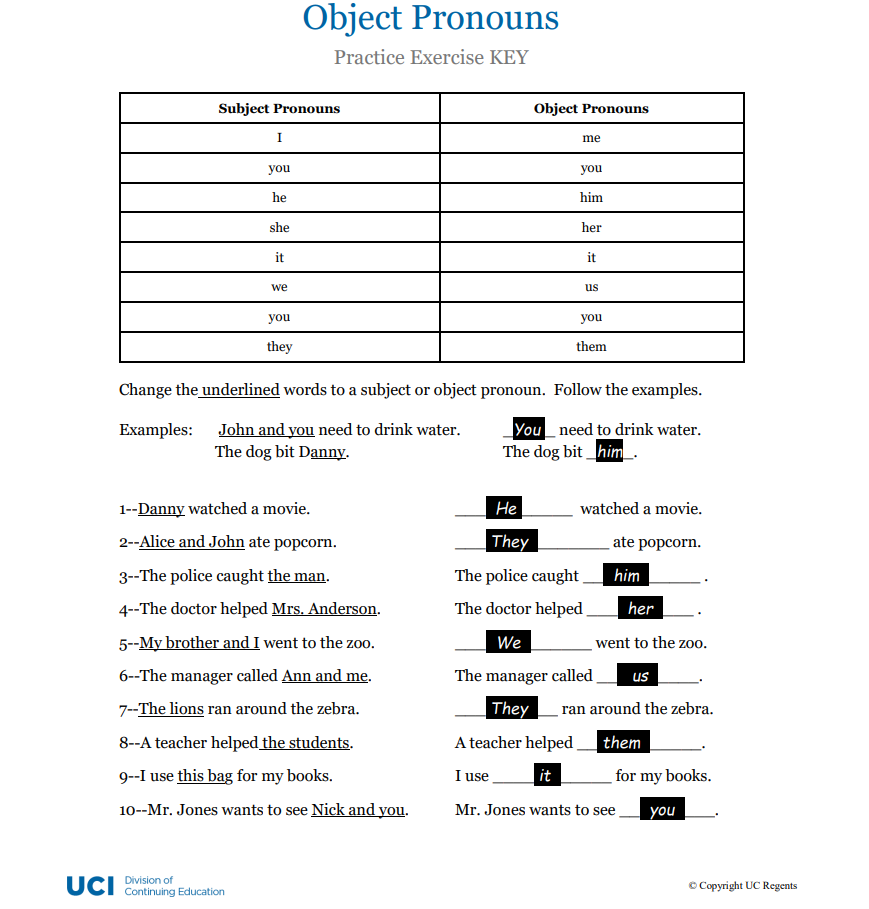
Quiz: Simple Past Negative & Object Pronouns
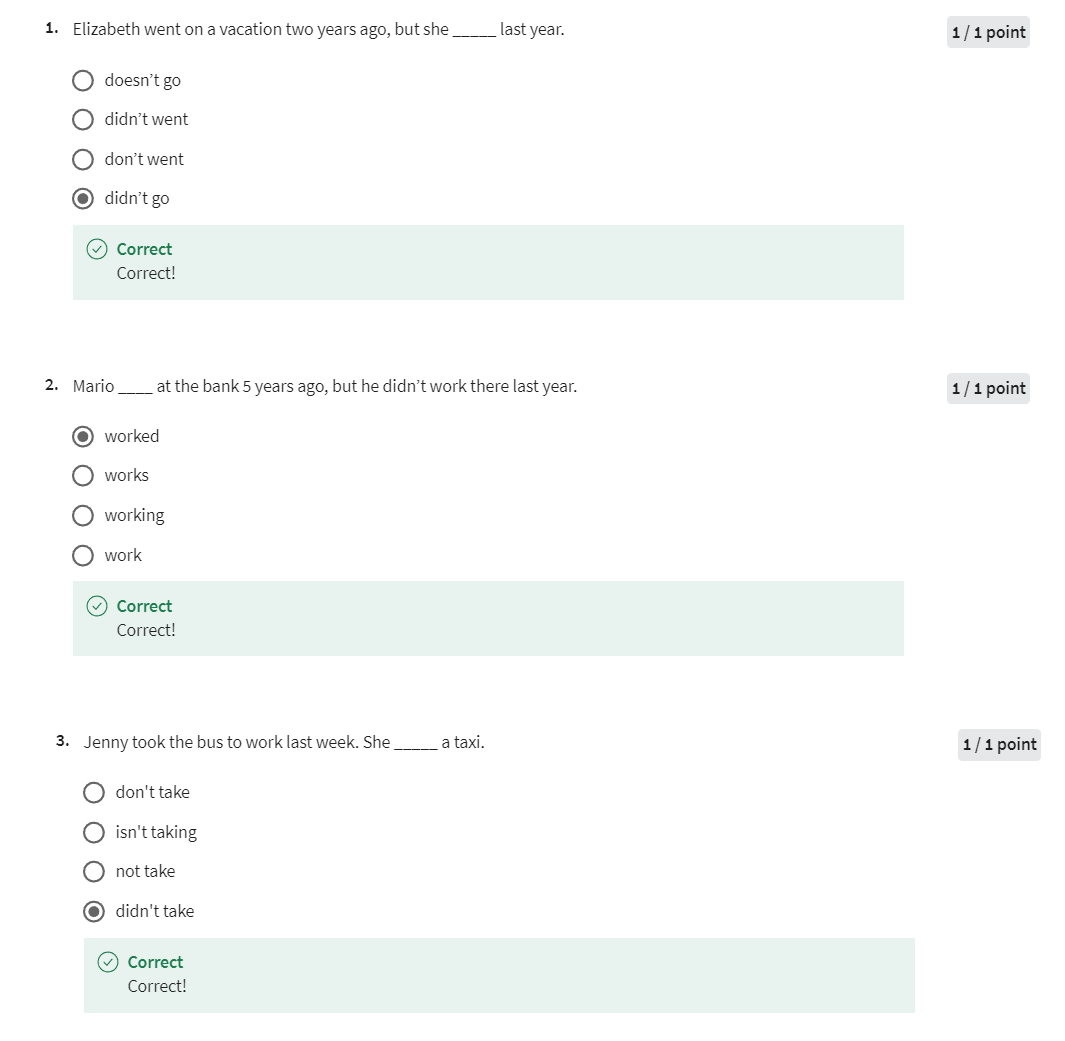
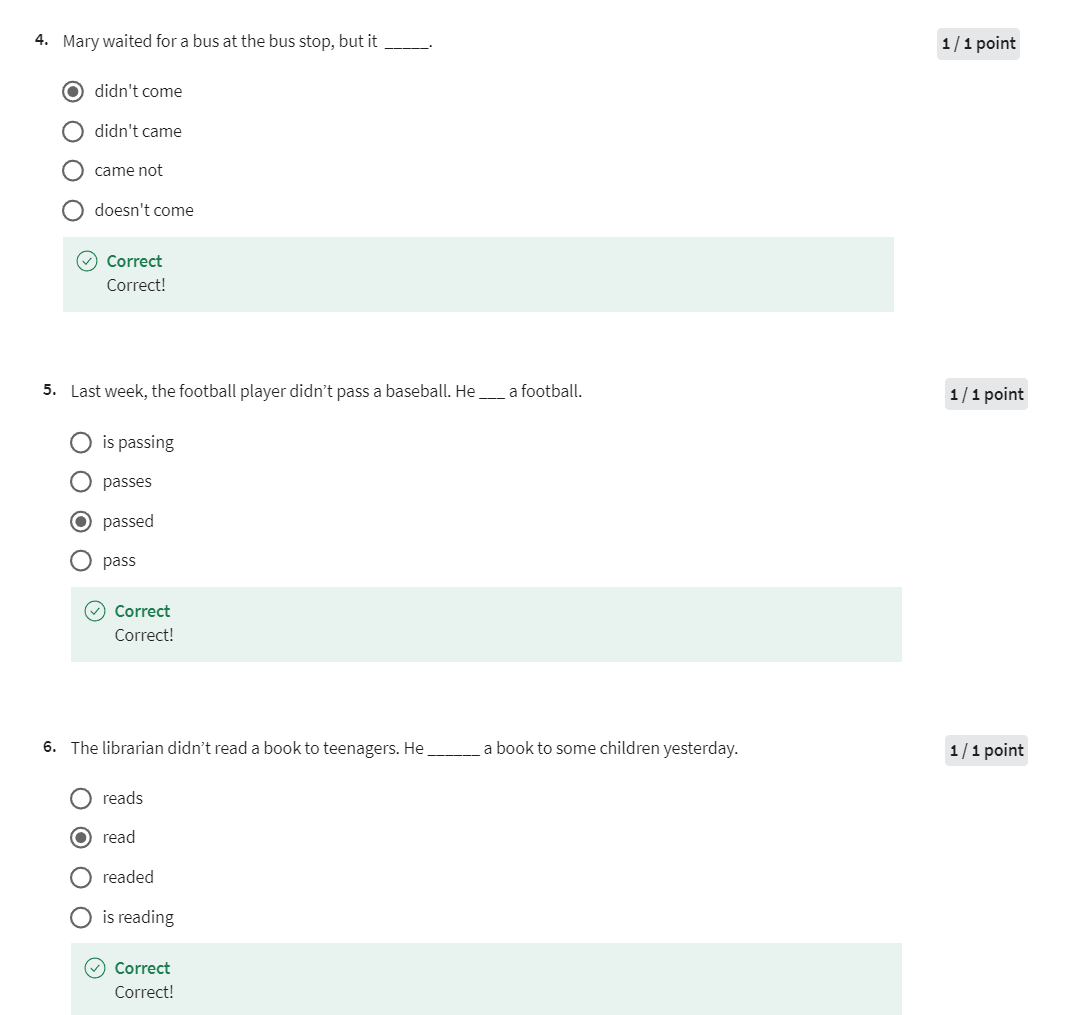
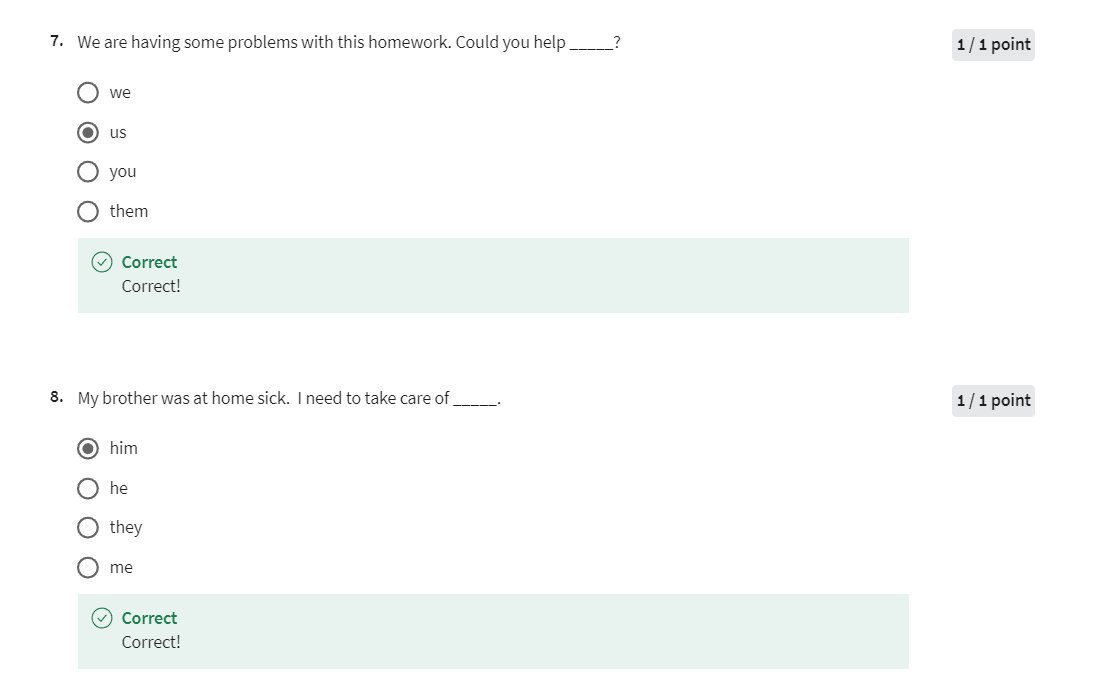
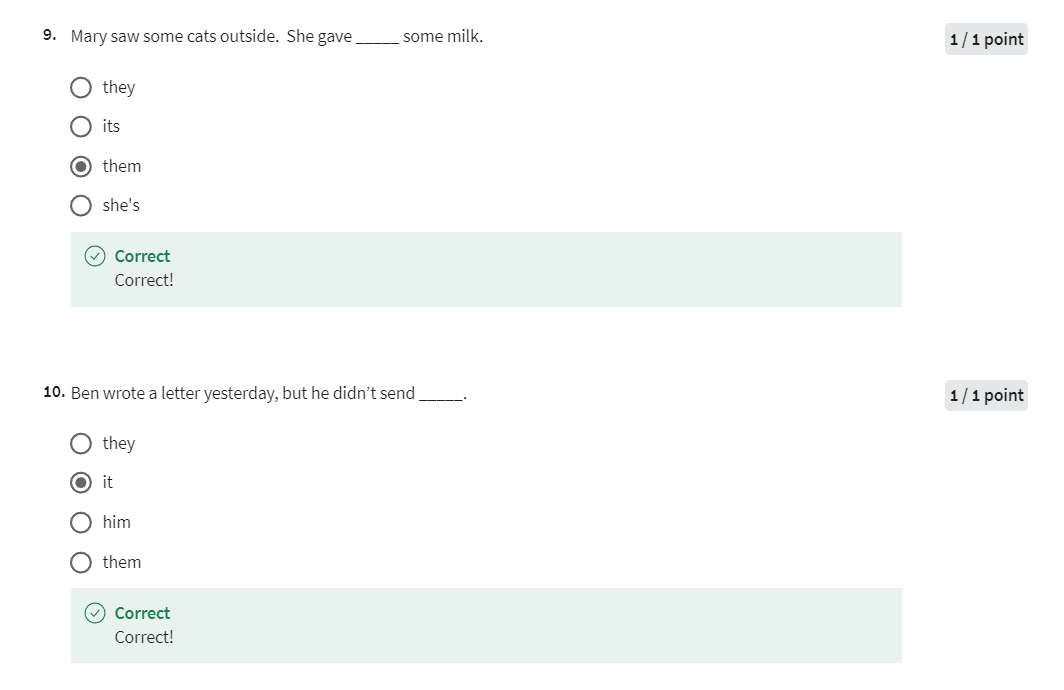
Week 03: Simple Past Question Forms
This week is all about how to form questions in the simple past. You will learn how to ask questions with the BE verb and how to use “did” to ask questions with all other verbs. This will include yes/no questions and information questions.
Learning Objectives
- Ask yes/no questions in the simple past.
- Ask information questions in the simple past.
Simple Past Yes/No Questions BE
Yes-no questions simple past BE. I went to my friend’s
wedding last weekend. Oh, was it fun? Were there many guests? Was that inside or outside? Was there a big cake? Look at the yes-no
questions here. They all begin
with the past form of the BE verb. Was it fun? Were there many guests? Was it inside or outside? Was there a big cake?

Form a question with
BE in the simple past. The same way you form a question with BE in
the simple present. You already know how to
write this sentence. It was fun. It, is the subject, was, is the verb. Here, the verb is in the
simple past, “It was fun.” To make the question, we just switched the order
of the subject and the verb. The answer is the verb,
then the subject. Was it fun? Yes, it was.

Here are some more examples of yes-no questions in the past. There was a fire downtown
yesterday. Was it big? Were you there? Was anyone hurt? Was there a lot of damage? You can see they
all start with BE. Then they have the subject, and the answer to
these are yes or no.
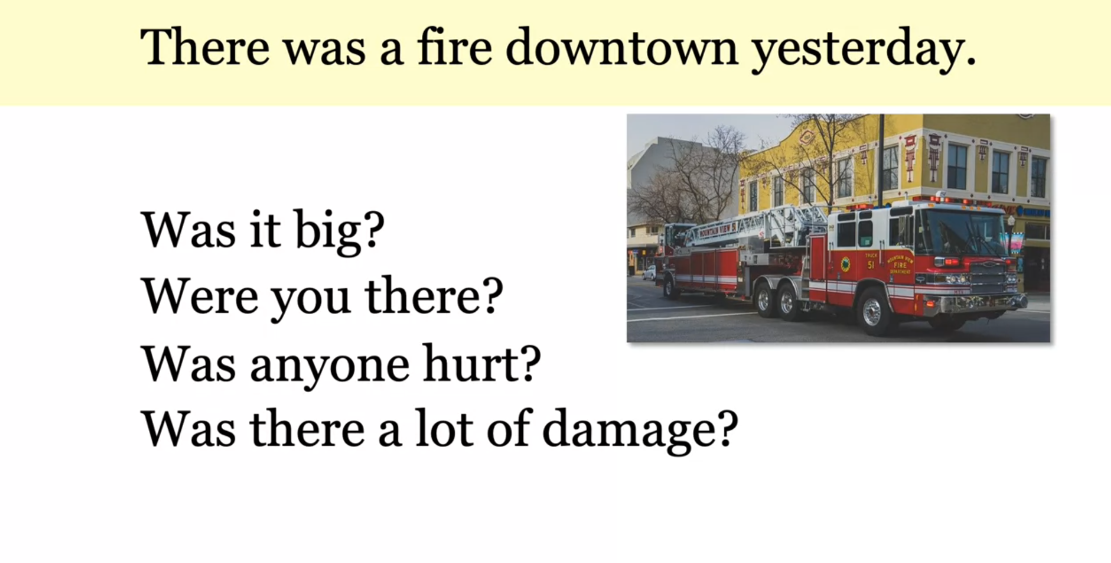
Okay, let’s practice. You have the answer. Yes, she was. She was very surprised. What is the question? Was she surprised? Yes, she was. She was very surprised. How about here. No, it wasn’t. The show wasn’t good. What’s the question?
Was the show good? No, it wasn’t. The show wasn’t good. Here, you have the answer again. Yes, they were. My textbooks were expensive. This one is plural, so start with the plural
form of BE in the past. Were your textbooks expensive? Yes, they were. My
textbooks were expensive.

Here, the answer is,
“Yes, they were. The strawberries were sweet.” What’s the question? Were the strawberries sweet? Yes, there were. The
strawberries were sweet." Here the answer is,
“Yes, there were. There were many people
at the farmers market. It was very crowded.” So what’s the question here? Were there many people
at the farmers market? Yes, there were. There were many people there. It was very crowded.
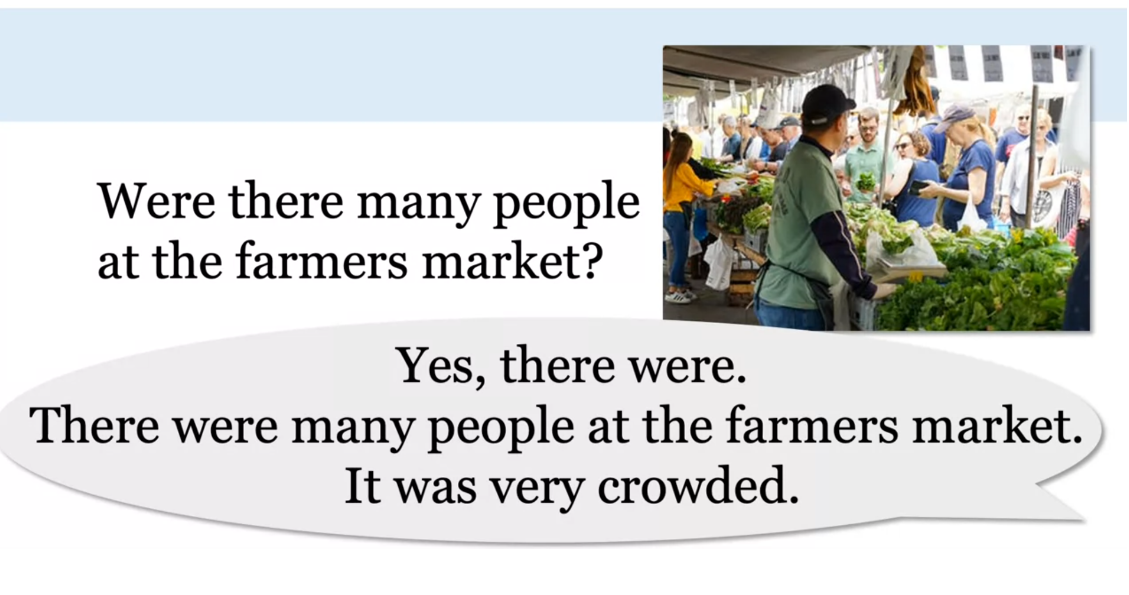
Last one, the answer
is, “Yes, it was. The weather was nice. It was a beautiful day.” What is the question? Was the weather
nice? Yes, it was. Now you know, form a
question with BE in the simple past by putting
the BE verb first. Was it crowded? Yes, it was. Were they expensive?
Yes, they were.
Simple Past Yes/No Questions BE (Practice Exercise)
Exercise
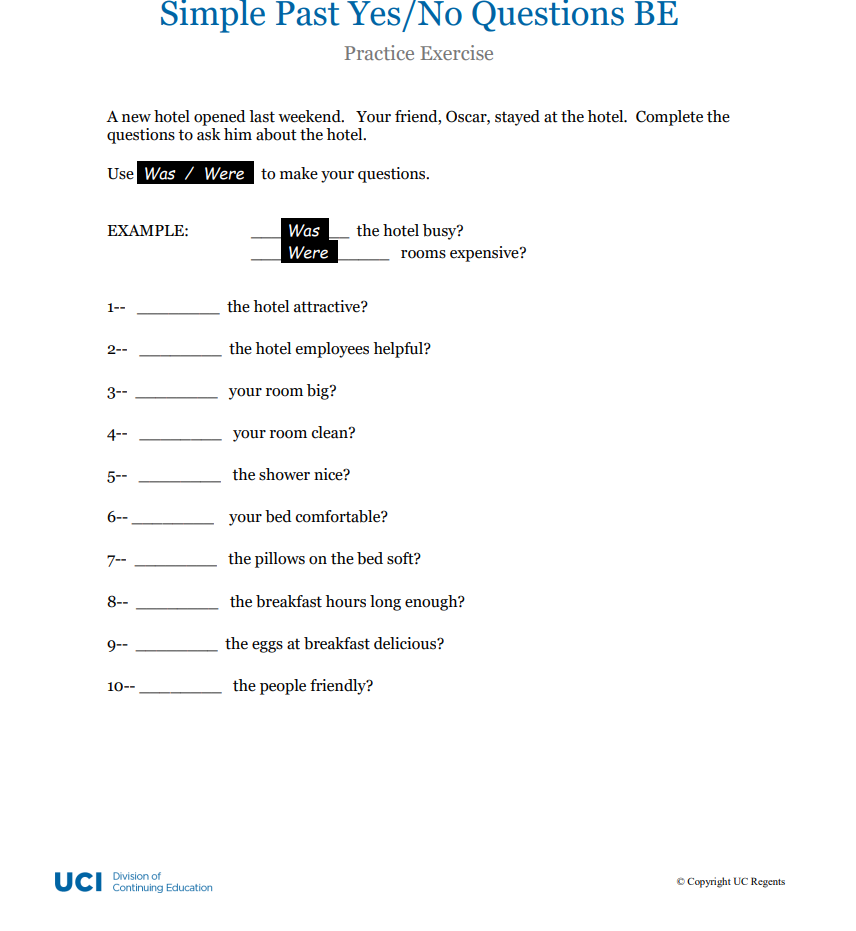
Answer
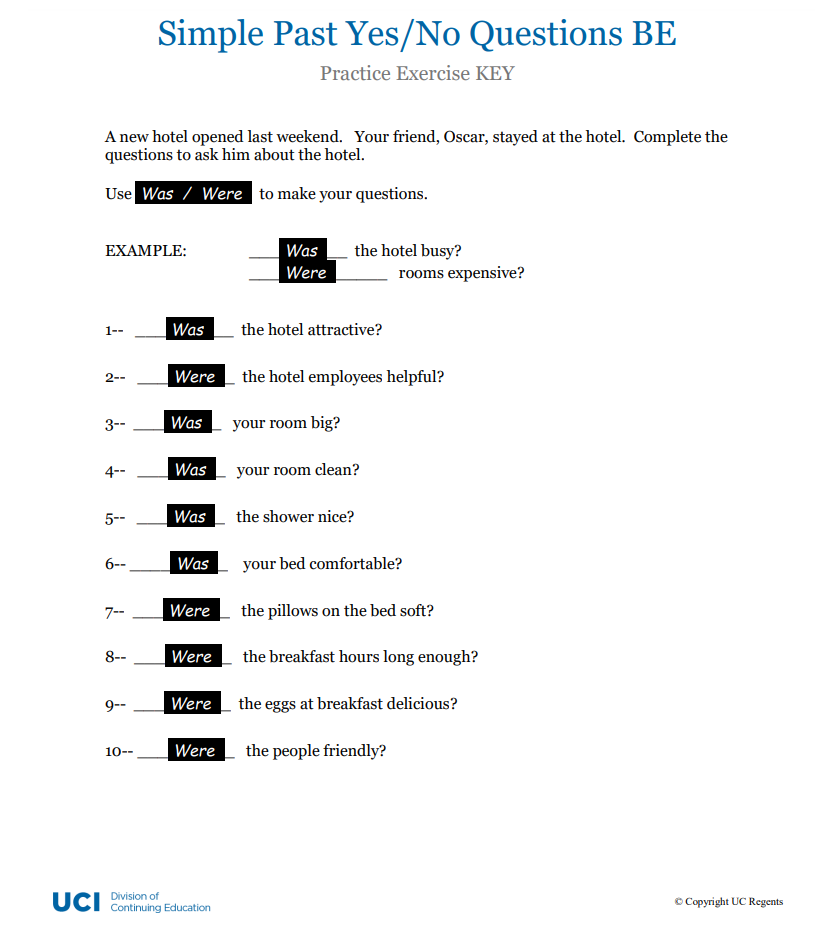
Simple Past Yes/No Questions Verbs
Yes, no questions, simple past. In this lesson,
you will learn about how to make yes, no questions with all the verbs in
the simple past except the be verb. How was your trip to New York City? Did you walk across the Brooklyn Bridge? Did you visit the Statue of Liberty? Did you visit the museums? Did you eat a bagel? Was the weather nice? Okay, these are all yes, no questions, but you can see we have four
questions that start with did. Did you walk, did you visit,
did you visit, did you eat? And then we have was the weather nice? This one, this last one, is a yes,
no question with the be verb. But you can see for all other verbs
we need did to ask the question.
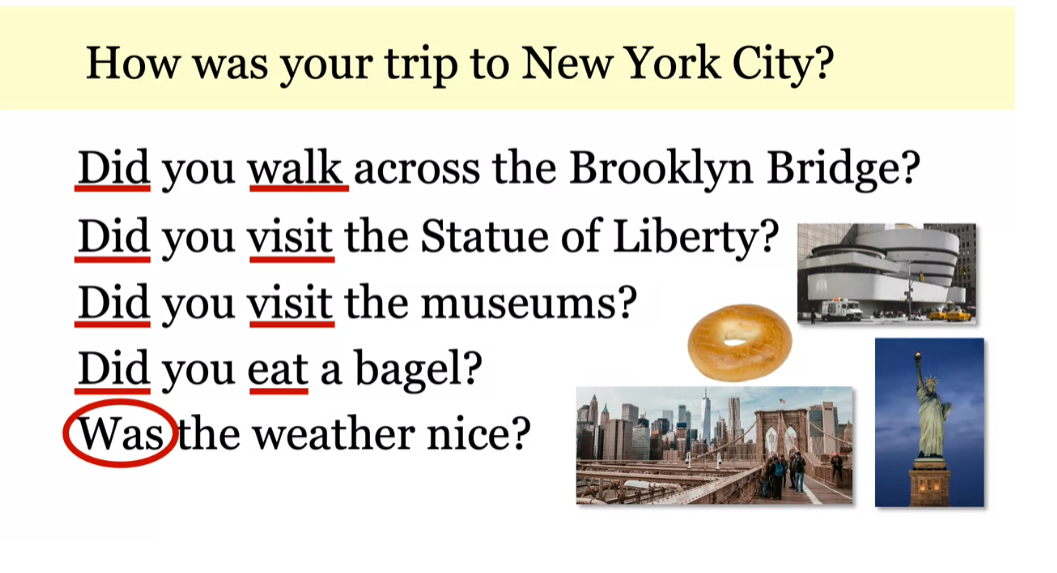
Let’s look. Use did to form a question in the past. Every question starts with did. And then the subject, here we have
a list of pronouns to use as subjects, and then the verb, and the verb stays
in the simple form, it doesn’t change. Let’s make some questions. Did you sleep well? Yes, I did. Did he run yesterday? No, he didn’t. He swam.
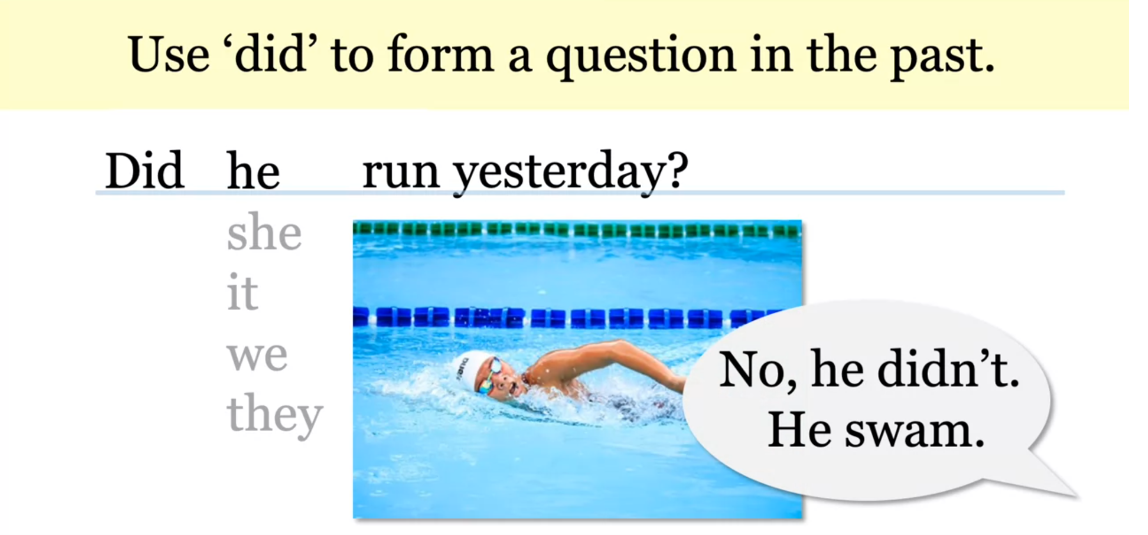
Did she finish her research paper? No, she didn’t, not yet. Did it rain a lot last spring? Yes, it did. Did we get the contract for the project? Yes, we did. Did they eat all of the cake? Yes, they did. You only need to remember
one pattern to form yes, no questions in the past. Start with did, then put the subject, and then put the verb and
whatever other information you need. Did I lock the front door? Did she forget her water bottle? Did her grandchildren arrive? They all start with did and
then have the subject and then the verb and noticed lock,
forget, and arrive. The verb stays in the simple form. Don’t put the verb in the past.
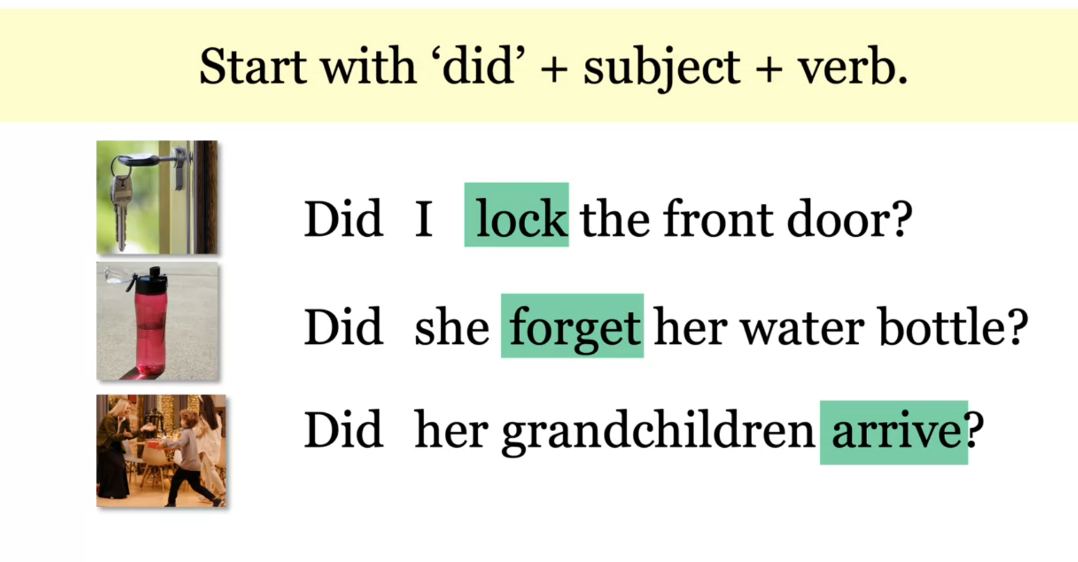
Okay, let’s practice. What is the correct word order? You know you have to start with did. Did Gina work in her garden? Did Gina work in her garden? Yes, she did,
she planted flowers yesterday.
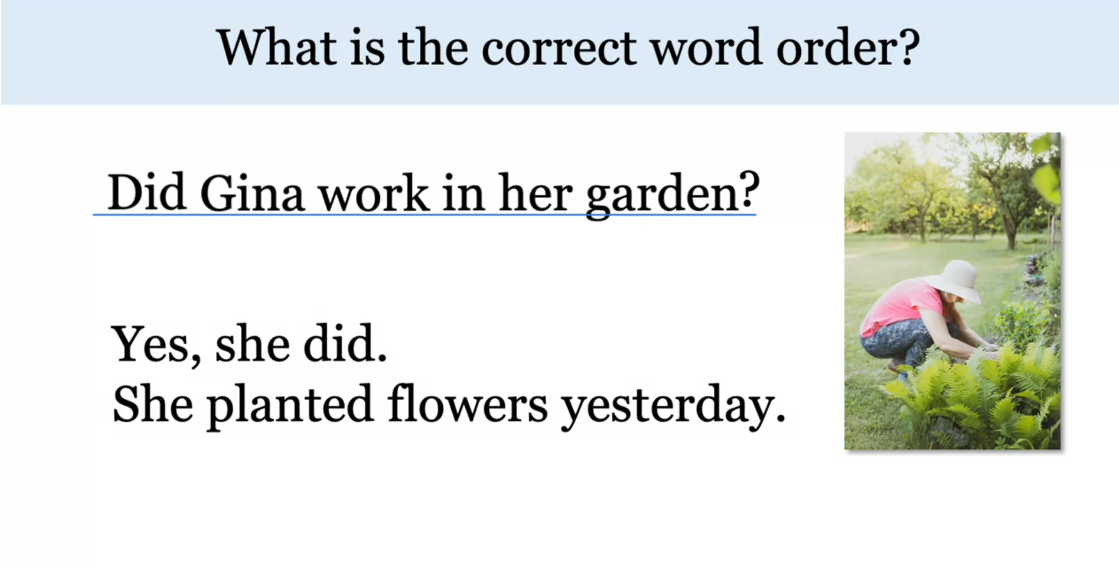
What is the correct word
order to make this question? Did they do laundry yesterday? Did they do laundry yesterday? Yes, they did. They did three loads of laundry.
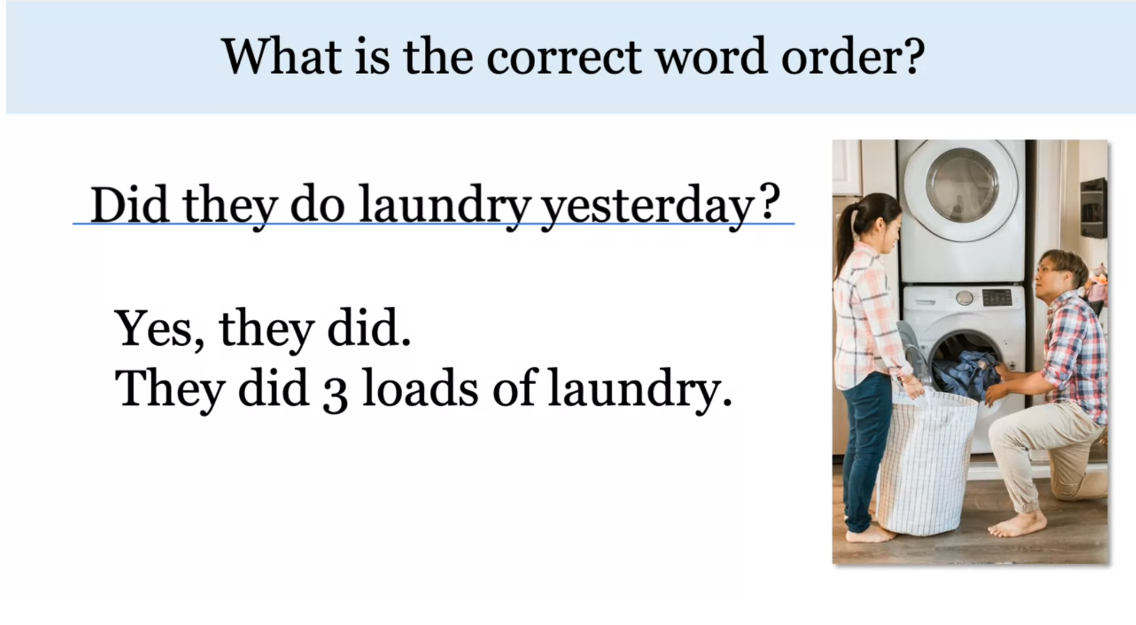
Last one. Did you spill coffee on my papers? Did you spill coffee on my papers? No, I didn’t. The cat spilled your coffee. Now you know to form yes,
no questions in the simple past. Start with did, then put the subject, and then put the verb and
any other information. Did I lock the front door? Did they eat all of the cake? Did you understand?
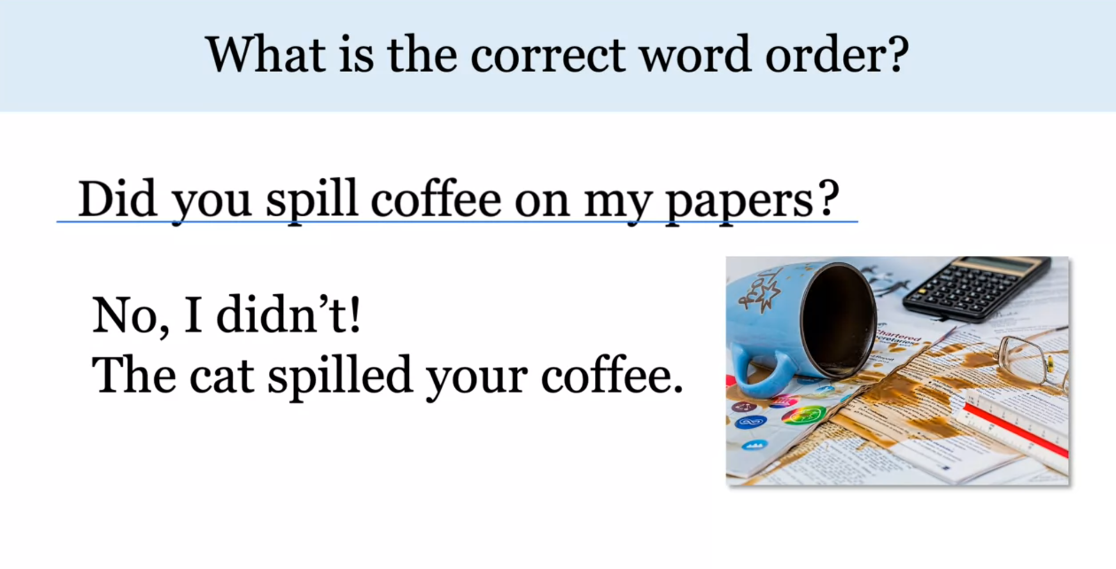
Simple Past Yes/No Questions Verbs (Practice Exercise)
Exercise
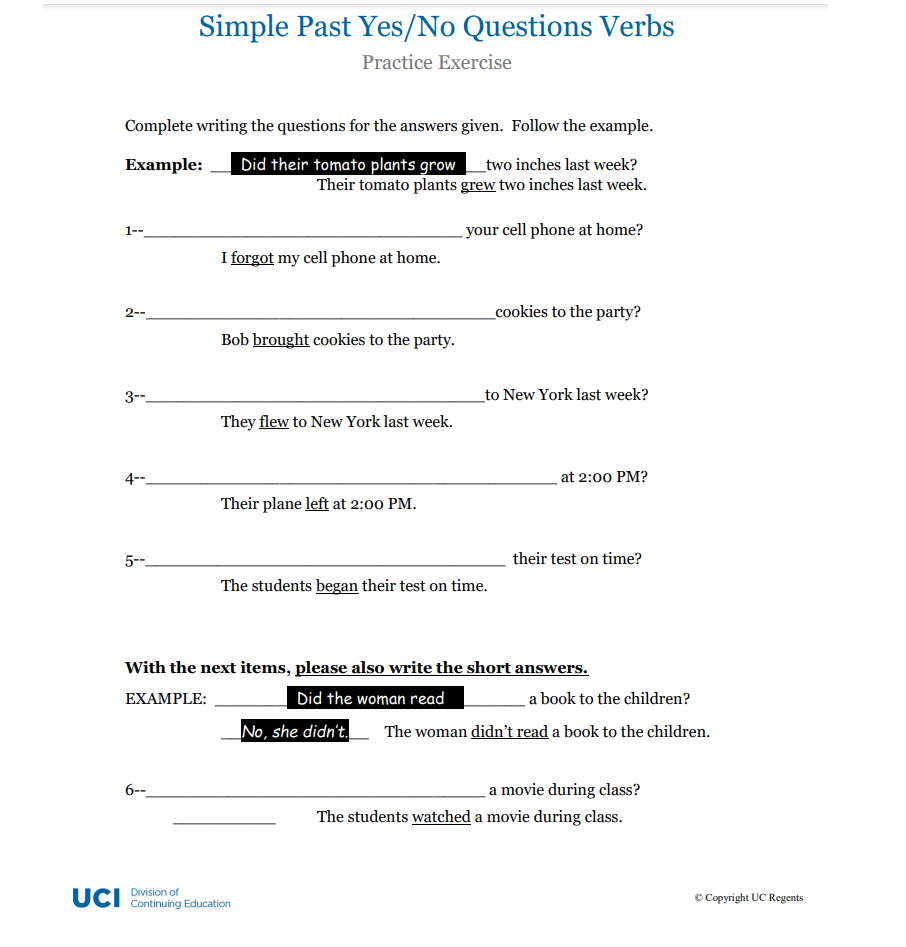
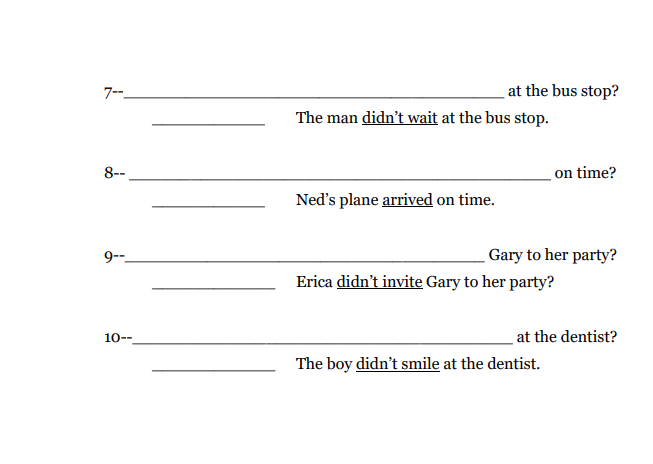
Answer
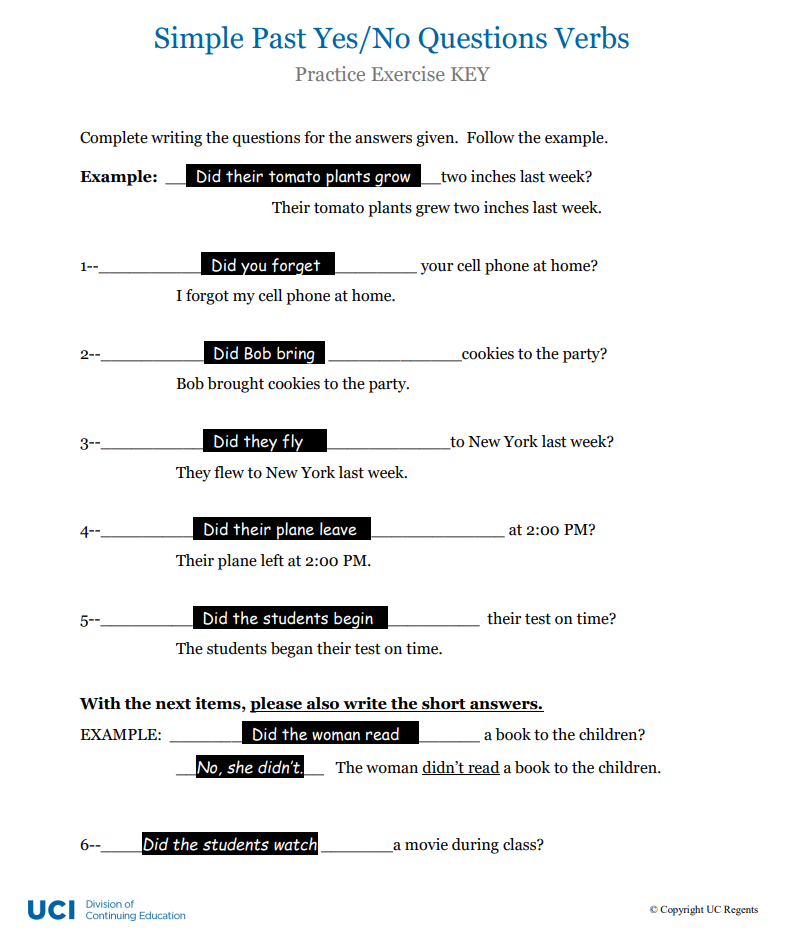
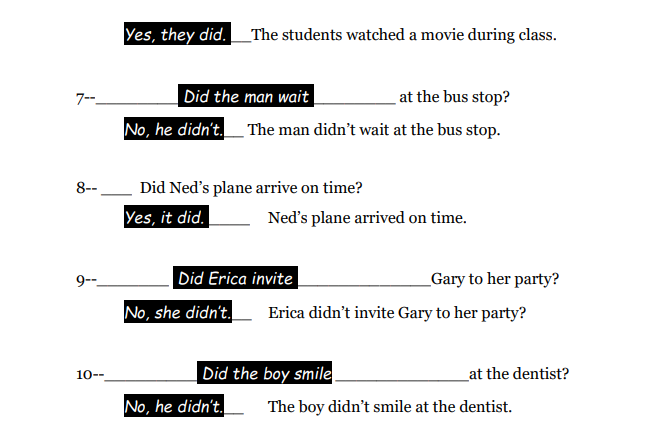
Simple Past Information Questions
Simple past
information questions. Ms. Jones asked
many questions when she interviewed Andrea
for the new job. Where did you work? How long did you work there? When did you leave that job? Why did you leave that job? Notice all of the questions
start with a question word. Where, how long, when, and why.
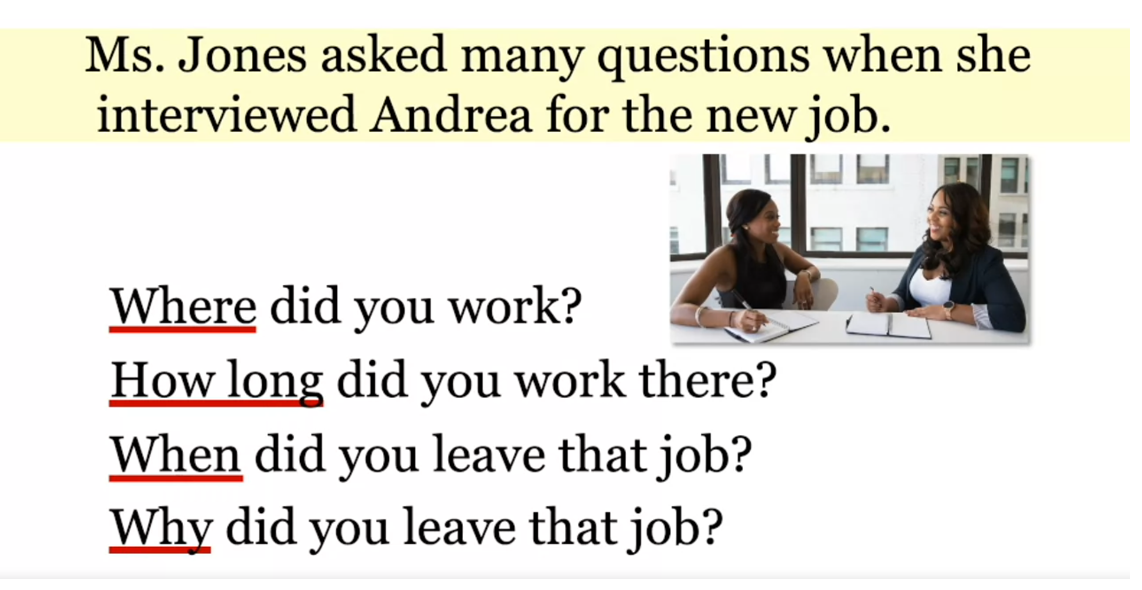
To form an information question, put the question word in front. You already know
how to ask a yes, no question in the past, like this question, did you
watch a movie last Friday? “Yes, I did.” To make the
information question, we’re going to change
this did to a lowercase. We’re going to get rid of
that extra information, and put the question
word here in front. What did you watch? “I watched a science
fiction movie.”
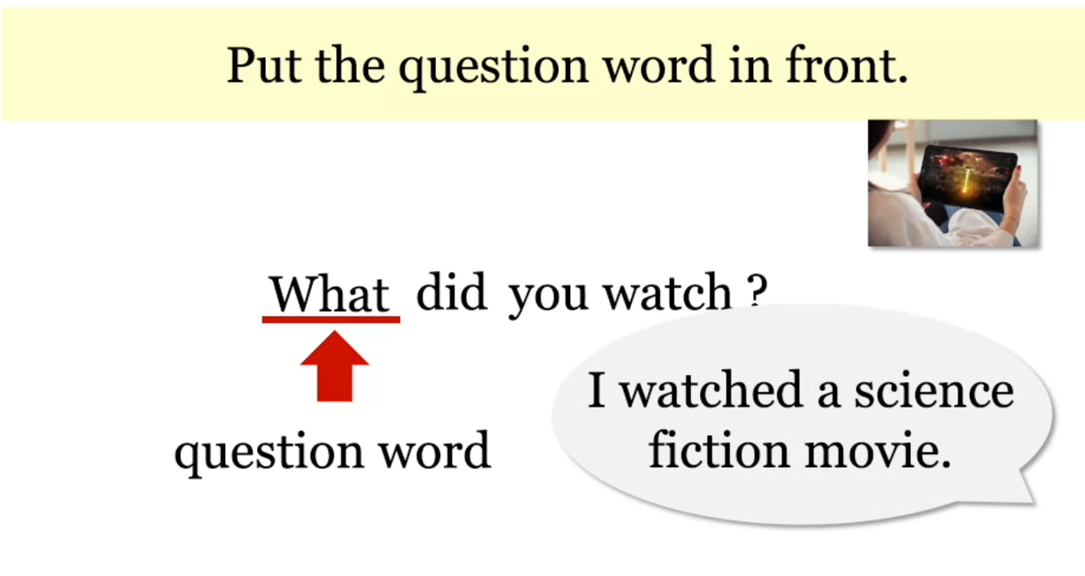
Let’s look at some examples. Did Vanessa travel last year? “Yes, she did.” This is
the yes, no question. To make information questions, let’s change the
D to a lowercase, and now we can put
question words in front. We can make many questions with this one, yes, no question. Where did Vanessa travel
last year? “Los Angeles.” When did Vanessa
travel last year? “In September.” Why did Vanessa travel last year?
“To visit a friend.” How did Vanessa travel
last year? “By plane.”
Okay. You try, what is the correct word order to
make an information question. Use these words. You have to start with
the question word. What did you eat for breakfast? What did you eat for breakfast? “I had two pieces of toast.” What is the correct word order to make an information question? Start with the question word. When did they visit the museum? When did they visit the museum? “They went last month.
They saw the new exhibit.”

What is the correct word order? Why did Rob go to the hospital? Why did Rob go to the hospital? “He broke his ankle when
he went skiing last week.”
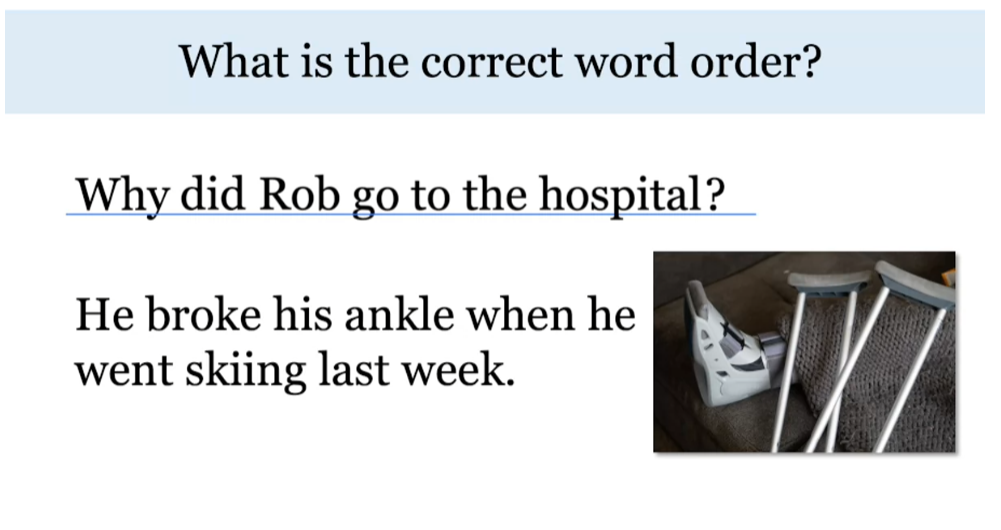
Last one. What is the
correct word order? Where did you go last weekend? Where did you go last weekend? “We went to the mountains and
camped with some friends.”
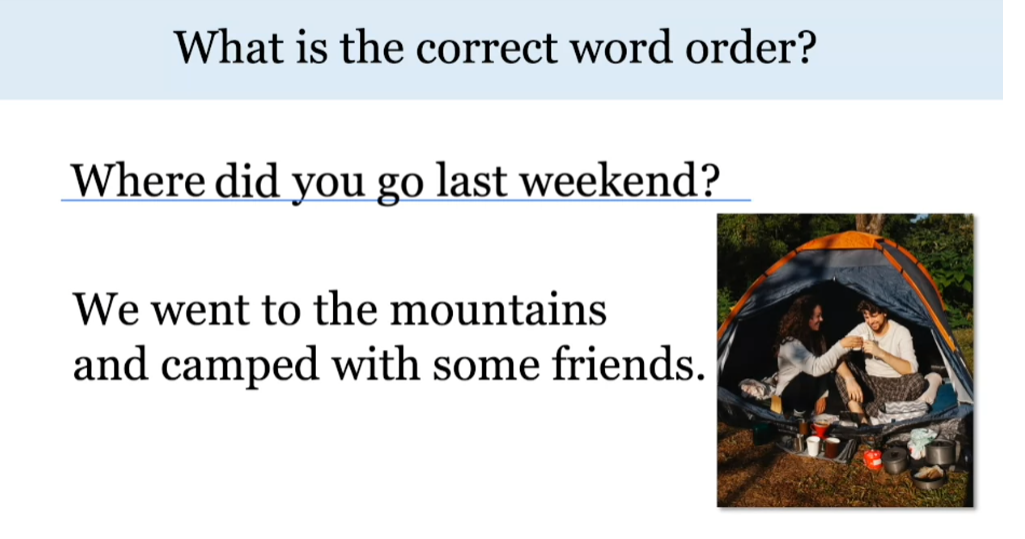
Now you know, just put the question word in
front to turn a yes, no question into an
information question. Did you work? Where
did you work? Did you leave that job? Why did you leave that job?
Simple Past Information Questions (Practice Exercise)
Exercise
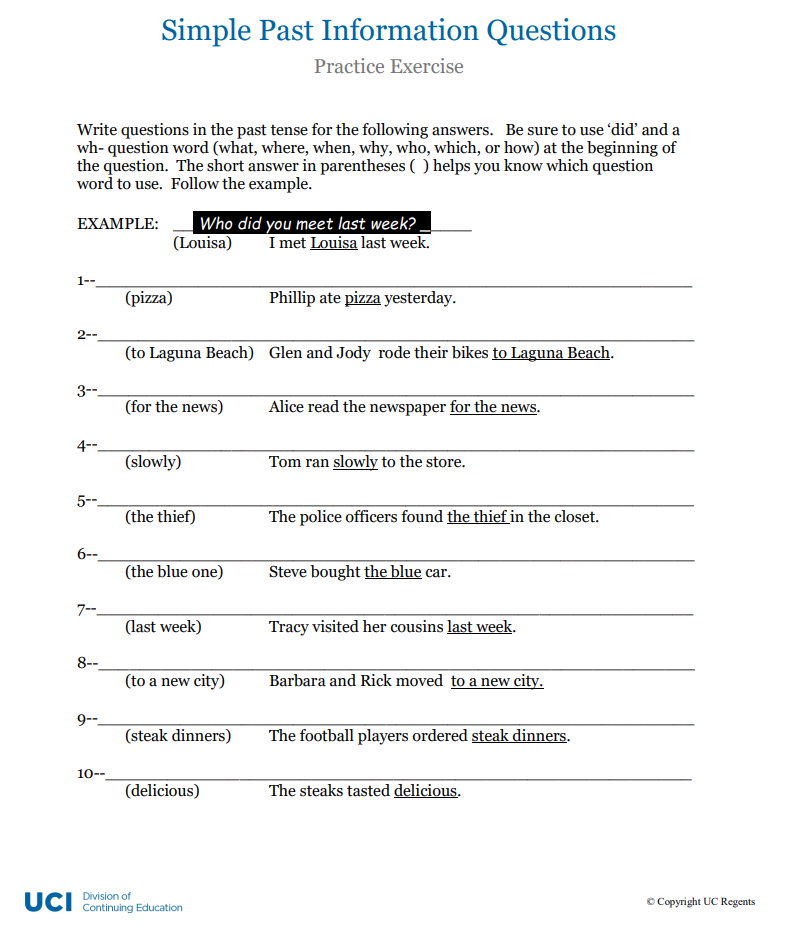
Answer
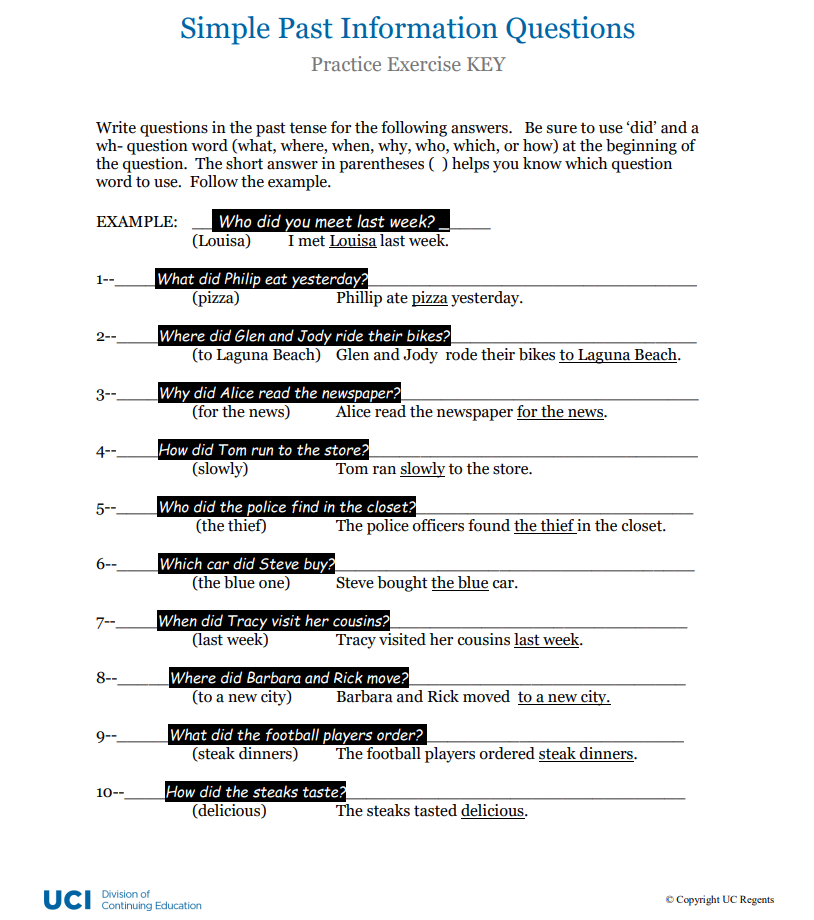
Quiz: Simple Past Question Forms

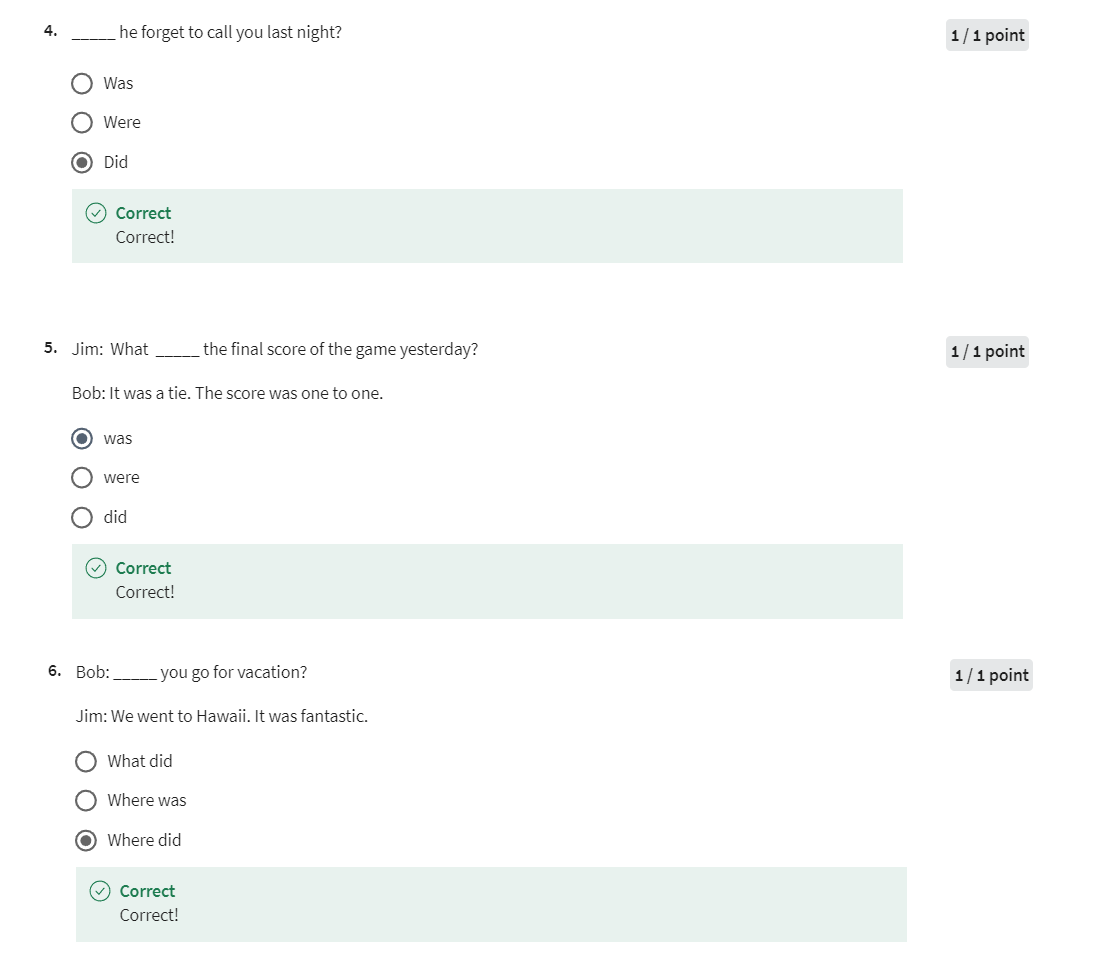
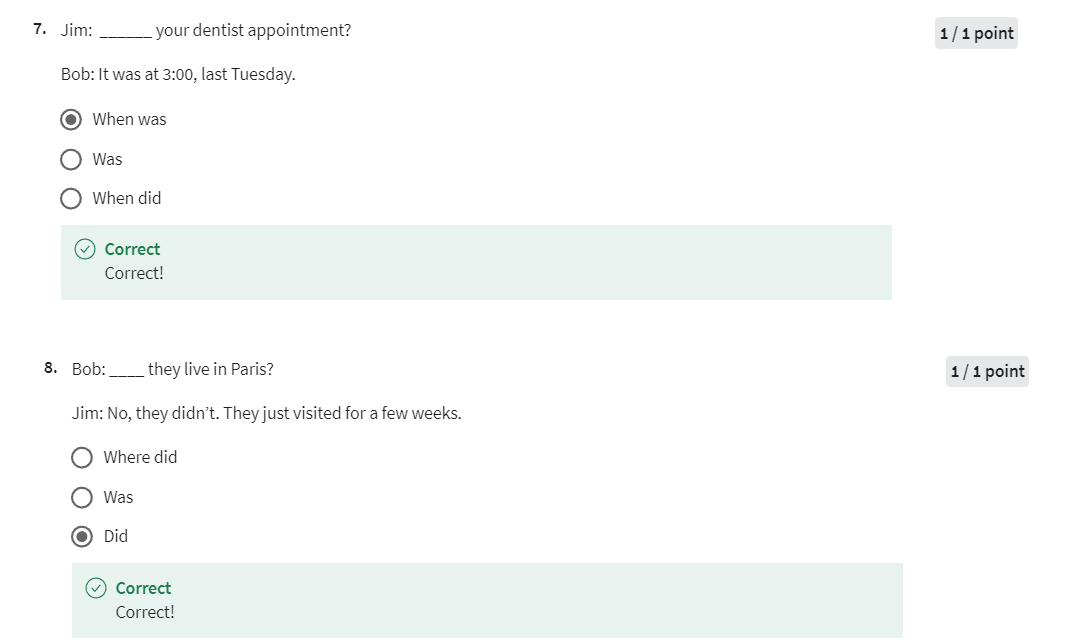
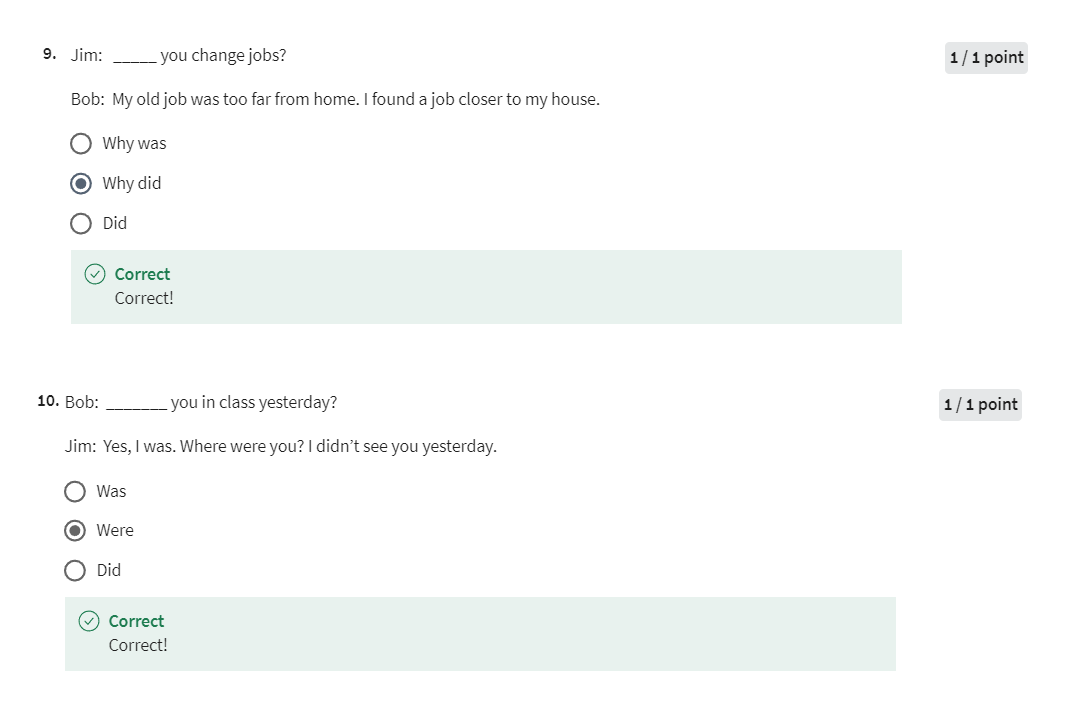
Week 04: More Useful Grammar Forms
In this last week, we will look at some other grammar points to help you express yourself in English. You will learn how to use “this,” “that,” “these,” and “those.” We will also look at how to change adjectives to make comparisons. Finally, you will learn about infinitives. Infinitives are an unchanged form of a verb with the word “to.” We use them with verbs like ”need,” “want,” and “like.”
Learning Objectives
- Identify when to use this, that, these, or those.
- Make comparisons using adjectives.
This, That, These & Those
This, that, these, those. Jill and Sue are
shopping together. I like this teapot. Did you see that plate? Do you like these pins? Yes, those pins are cute. Do you see the words this, that, these, and those? These are another
adjective we use with nouns to show where
they are.
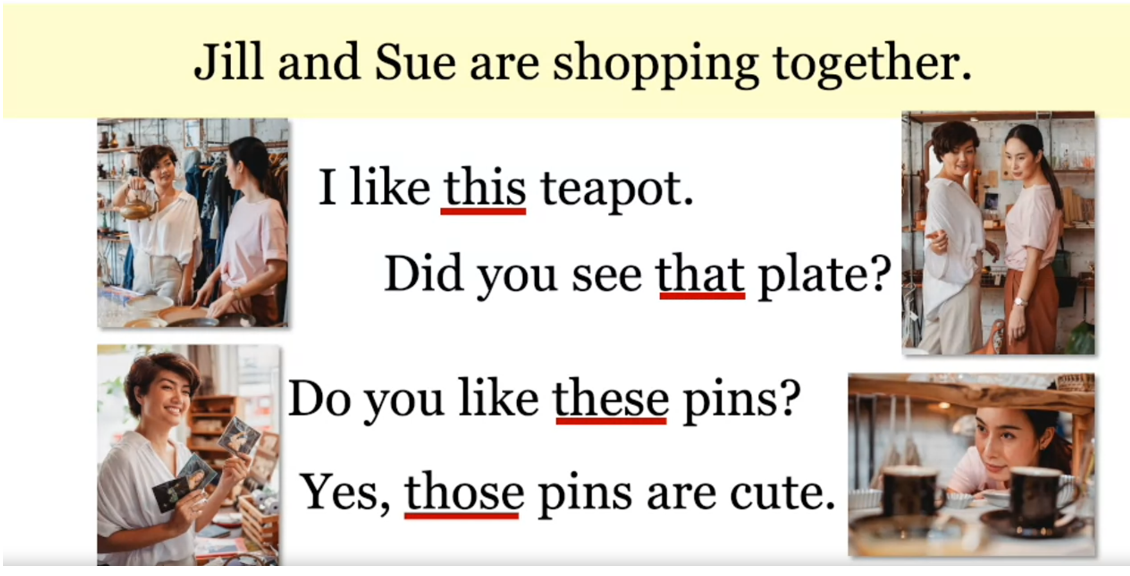
Let’s look. Here is a chart. Let’s say this row is singular
and this row is plural. This column is near, and this column is far. Our words go like this. “This” describes something
that is singular and near. “That” describes something
that is singular and far. “These” is plural and near, and “those” describe
something plural and far.
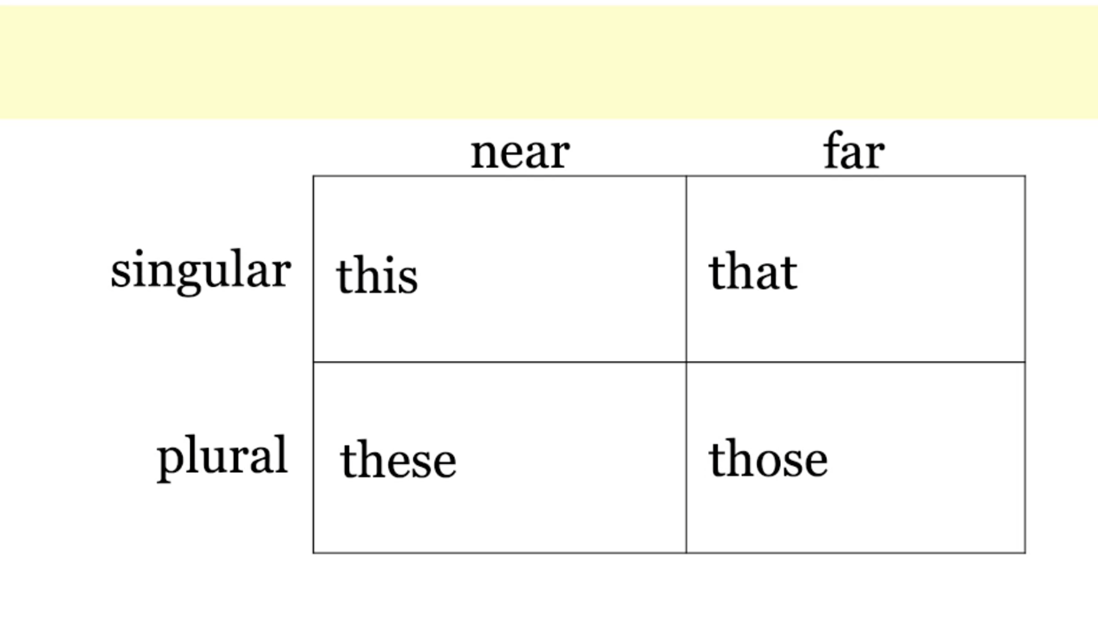
Maybe this doesn’t make
sense with just the words, so let’s look at a
room full of cats. We have some cats that are near and some cats that are
far in the corner. This cat is near and there’s
only one, it’s singular. That cat is far, but there’s only
one, it’s singular. These cats are near and there
are two, so it’s plural. Those cats are far,
plural and far.
Let’s practice with some chairs. This chair is near
and there’s only one, so we use “this”, this chair. The chair back here is
far and there’s one, so it’s that chair. This chair and that chair. Now, we have plural chairs. The chairs here, if
I’m showing you, I would say these chairs
and the chairs back there, I would call those chairs. Let’s mix it up with baskets. What should go here? This, that, these or those? This basket because it’s
near and it’s singular. How about the baskets
in the corner? Those baskets
because they’re far, but it’s plural
they’re more than one. If we change it now we have
one basket, far, that basket. Finally, two baskets
near, these baskets.
We use these words with nouns. Even in this sentence,
look, these words. These tells me which words
and words is the noun. We use these words with nouns. Let’s look. I like this teapot. “This” is the adjective
that shows me the noun, teapot is near and singular. Did you see that plate? “That” is the adjective
that shows me the plate is far, but
there’s only one. Do you like these pins? She uses “these” to describe the pins that are in her
hand they’re near her. Her friend answers, “Yes, those pins are cute.” The friend uses “those”
because the pins are not in her hand there in her
friend’s hand, far from her. When we speak, a lot of times
we don’t even use pins. We just say, “Yes,
those are cute.”
Let’s look at some examples. Here, the father is showing
the ducks to his daughter. The ducks are far, so he says, “Tasha, look at those ducks.” “Those” show that the
ducks are far and plural. Here, the husband is giving
his wife some flowers, and he says, “These
flowers are for you.” He uses “these” because
the flowers are plural, but also they’re near, they’re in his hand. Here, someone is looking at
the dress and she’s thinking, “Do you think this
dress is too short?” She uses “this”
because the dress is near her and there’s just
singular one, dress. Finally, these two are looking
off into the distance, and one points to a
building and says, “That building is new.” He uses “that” to show one
building far away.
You try. Can you fill in the
blank with this, that, these, or those? I’ll give you a hint. Near and plural. “Do you like these sunglasses?” How about here? He’s
pointing far away. It’s far and singular, so he says, “That
ship is really big.” Here, they’re looking across the water and
there’s some bears. Bears are far, far and plural. He says, “Those bears are
looking at us. Let’s go.” Finally, she’s helping
him with homework, and she’s pointing at one part, so it’s near and singular. “Did you read this part about
the history of the place?” Now you know how to use this, that, these, and those. This cat is near, that cat is far. These cats are near, and those cats are far. This, that, these, and those.
This, That, These & Those (Practice Exercise)
Exercise
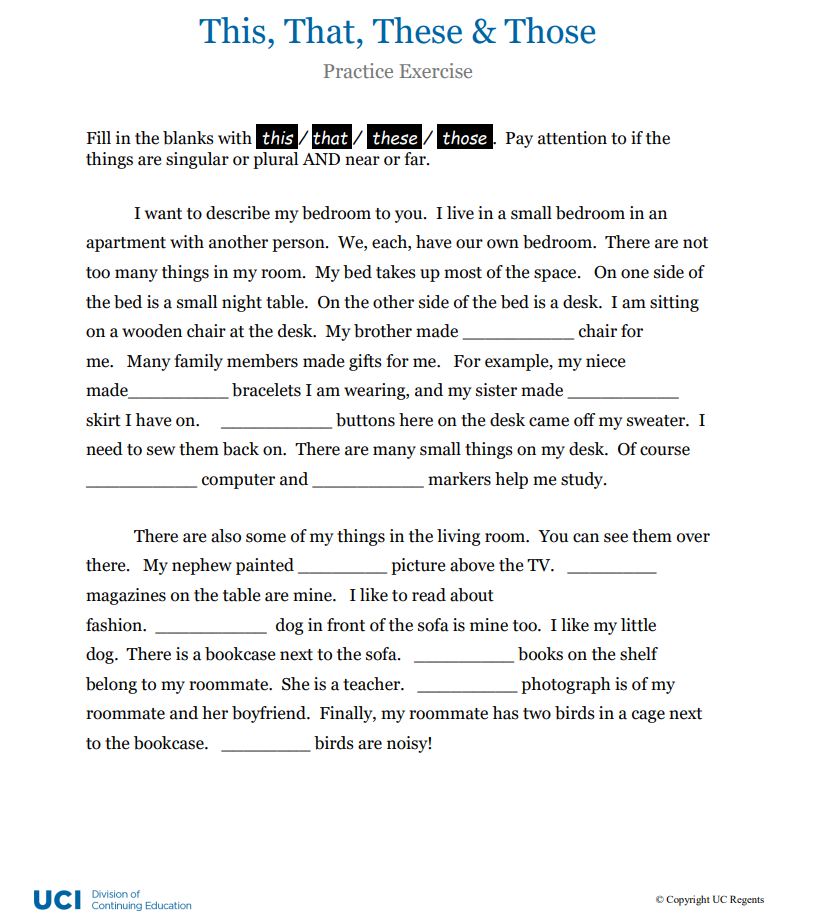
Answer
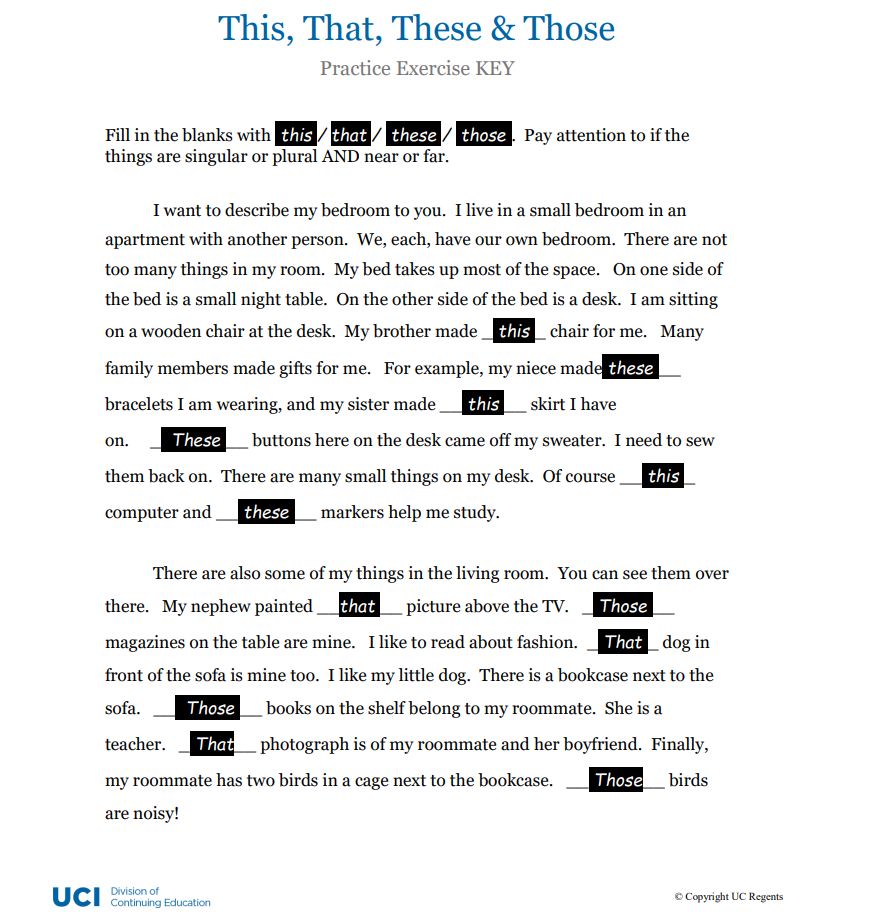
Comparatives
Comparatives. In this lesson, you will learn how to use adjectives to
compare two things. Paul and his brother
Ian are different. Paul is older than Ian. His beard is longer and
grayer than Ian’s beard. Paul is happier than Ian. Ian is more serious. Look at the comparatives:
older than, longer and grayer than, happier than, and more serious.
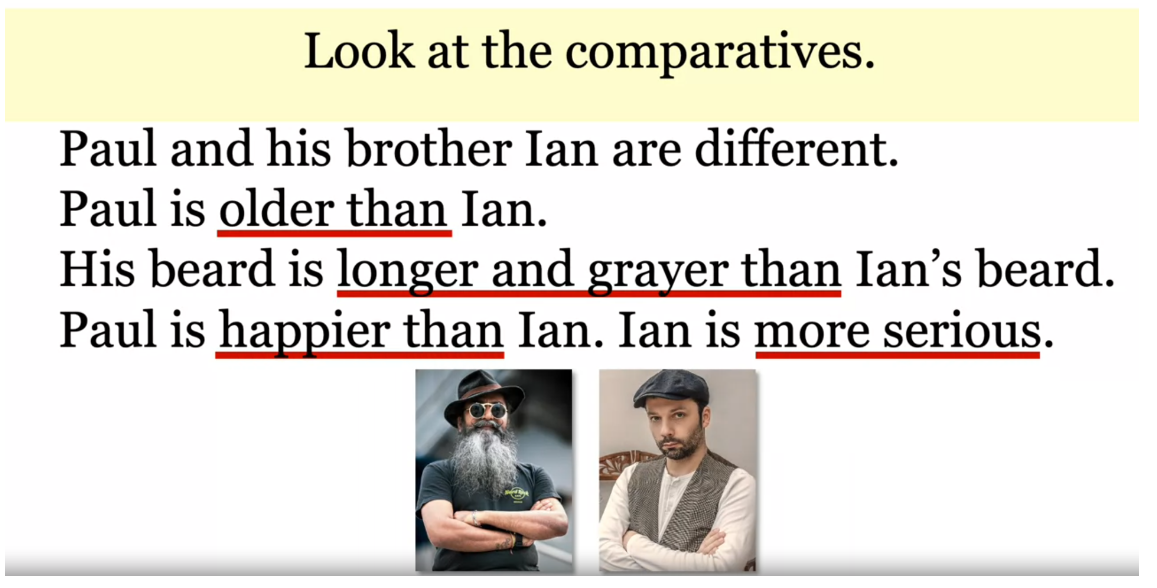
Paul is older than Ian. Ian is more serious than Paul. In the first sentence, we add er to the adjective
old to make the comparison. In the second sentence, we use more before the
adjective serious. This is because we use er for short adjectives and more
for longer adjectives. Look, old just has
one syllable or beat, old, but serious has three. We use more for longer words.
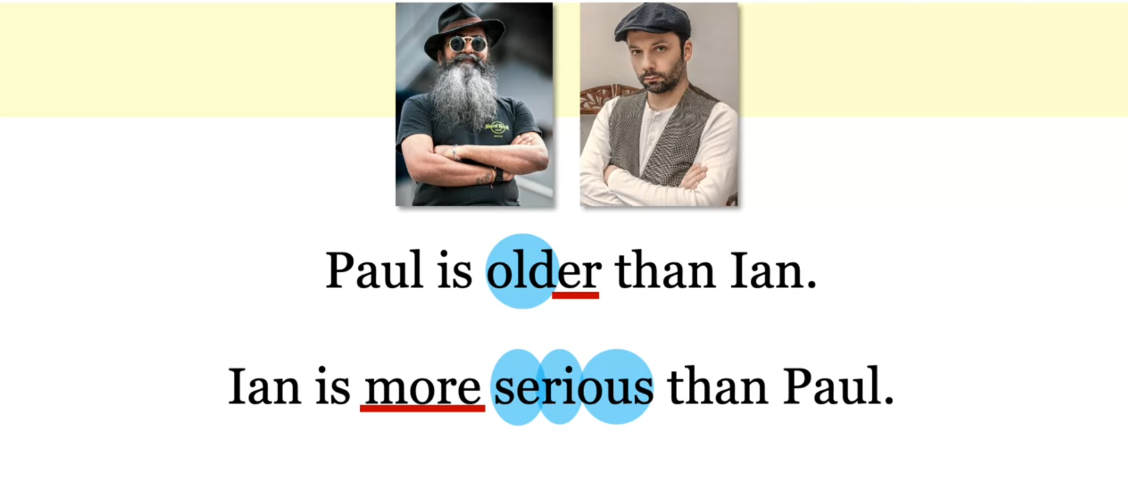
Let’s take a closer look. Add er to the end
of an adjective. Remember, an adjective is
a word that describes, like tall, hot, and pretty. We add er to get taller,
hotter, and prettier. You saw there are some
spelling changes. For many adjectives
we just add er. For some adjectives, we double
the consonant and add er. For other adjectives, we
drop the y and add ier.
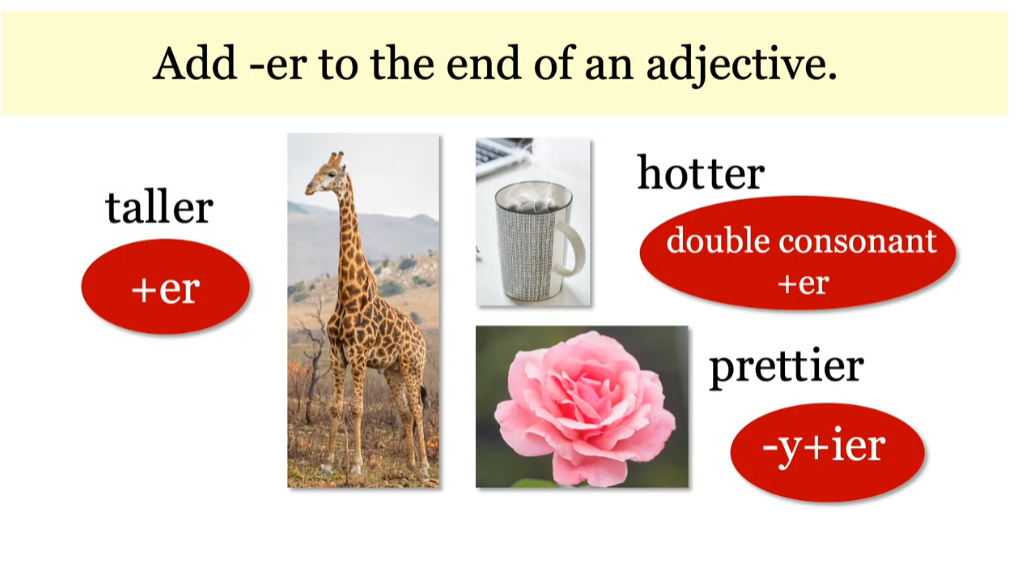
Let’s take a closer look. For many adjectives
we just add er. This turtle is slow, but this snail is slower. Cheap becomes cheaper, and
young becomes younger.
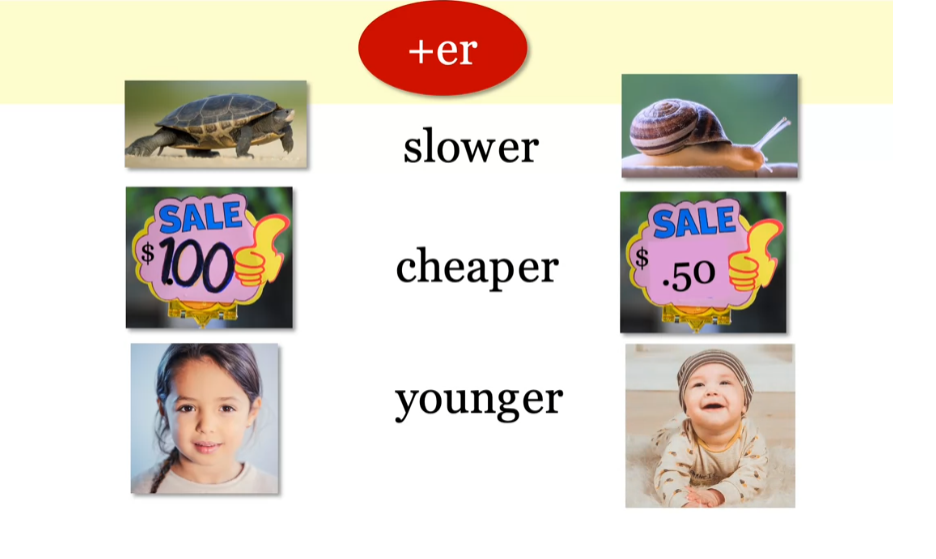
We double the consonant
and add er for adjectives that end with
consonant, vowel, consonant. You’ve seen this pattern before. Big, we have to double
the consonant and add er. This box is bigger
than that box. Hot, double the
consonant, add er. This fire is hotter
than that coffee. Thin, we double the n, add er. This pen is thinner
than that pen.
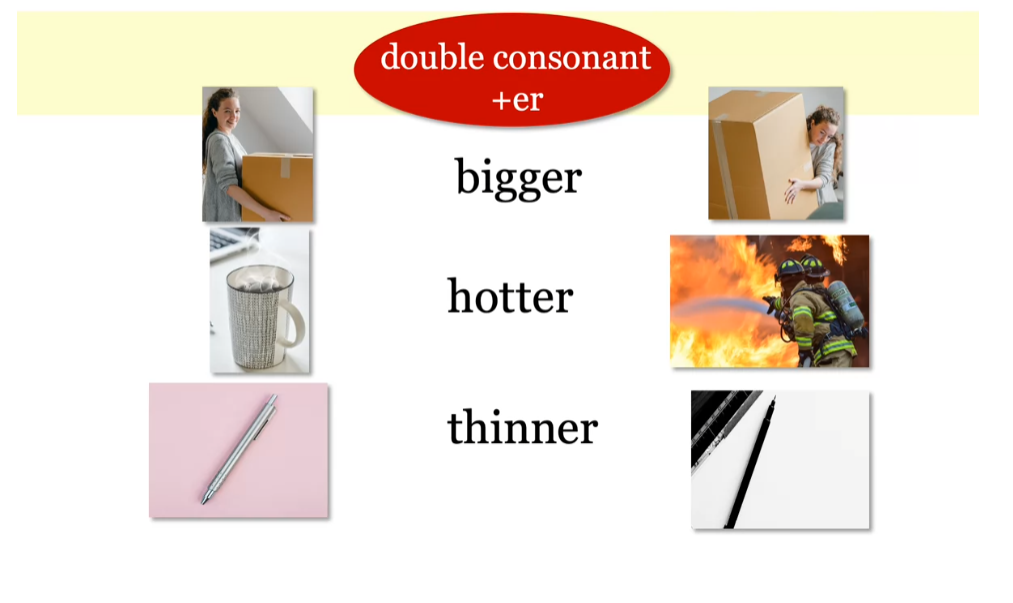
For other words, we
drop the y and add ier. That’s if the word ends
with a consonant and a y. You have also seen this
spelling pattern before. She is angry, but he is angrier. This is early, we drop
the y, and it’s earlier. She is friendly,
but we drop the y, add ier, and she is friendlier.
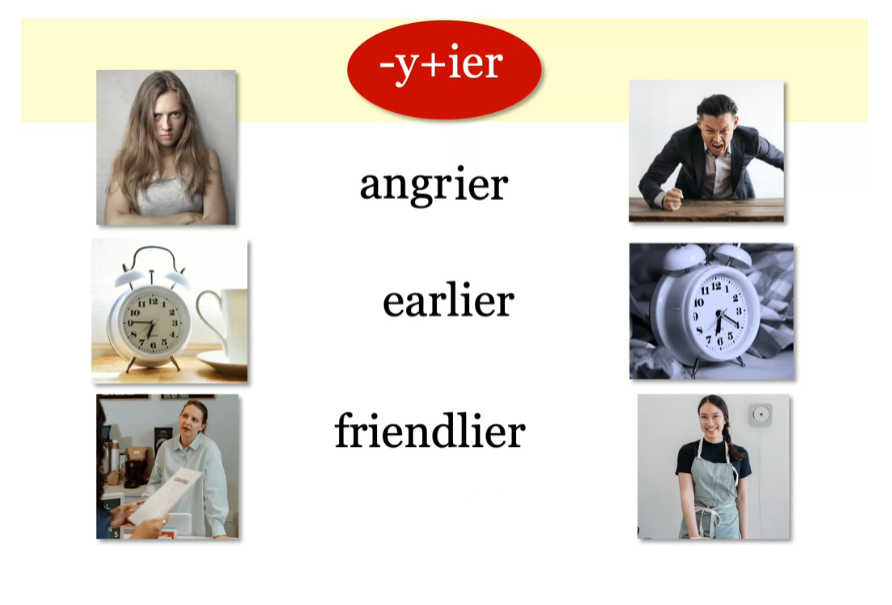
We use more for longer words. These adjectives,
comfortable, difficult, expensive have three
syllables or more, so we don’t add an er. This woman is comfortable, but this woman is
more comfortable. This looks difficult, but
this looks more difficult. A car is expensive, but a house is more expensive.
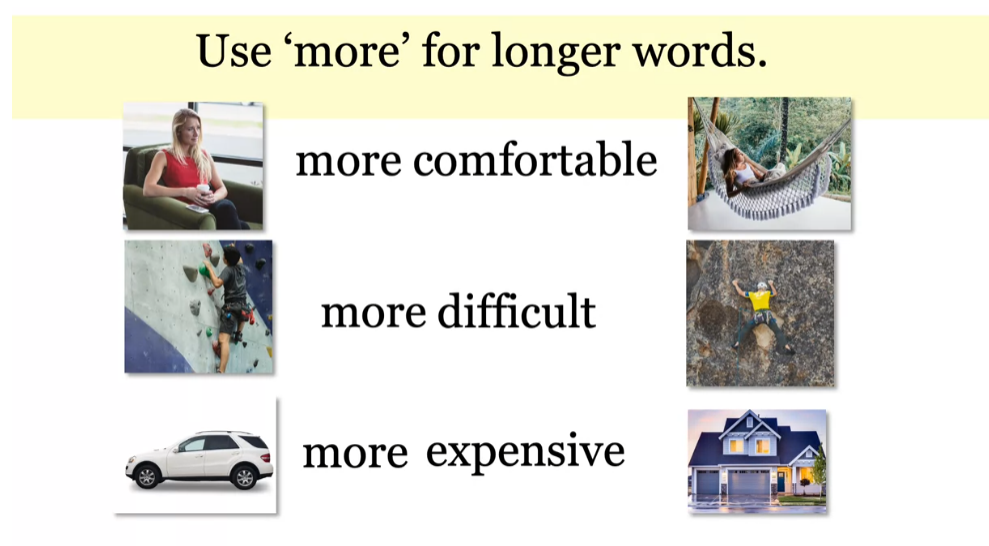
There are some irregulars. Good changes to better
and bad changes to worse. I know these don’t look like the original adjectives at all. You just have to remember them. Here’s an example. Here’s Jay. He was
sick yesterday. Today he is better
than he was yesterday. He’s still sick, but
yesterday he was worse.
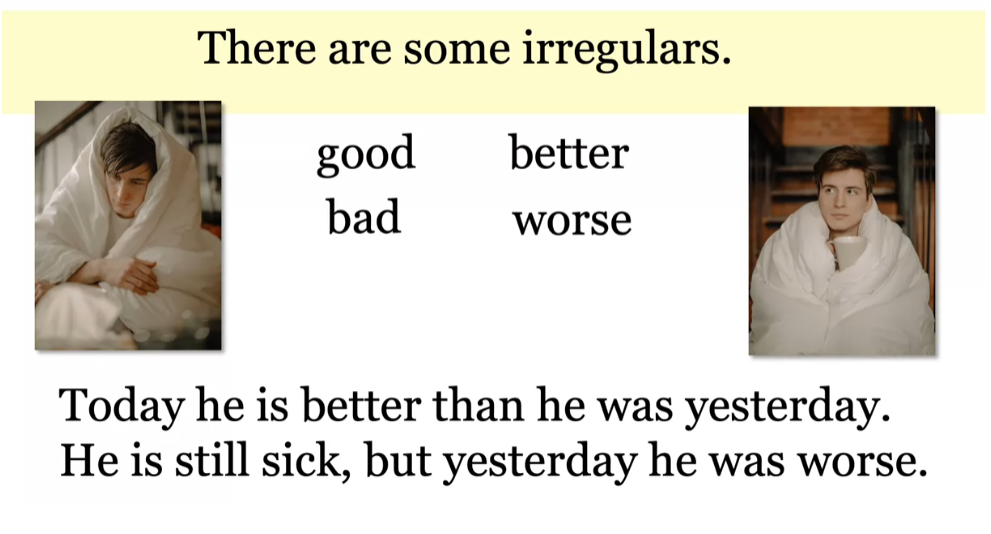
Use an adjective plus er
and then the word than, T-H-A-N. Today is
colder than yesterday. We have two nouns here that we’re comparing;
today and yesterday, and in-between, we use
the adjective with er and the word than to
make the comparison. Let’s look at some
more examples. Steven is taller
than his sister. He is older than she is too. Smokey is bigger than Mick. Mick is older than Smokey. Notice, in all of
these sentences, we have the same pattern. We have a verb, here in the
first sentence that’s is, and then we have the
adjective with an er ending, bigger, and then we use the word than to make the comparison.
You try. The adjective is green, we have the hills
and the mountains, what goes in between to
make the comparison? Remember, you need a verb, the adjective green with an er, and the word than. The hills are greener
than the mountains.
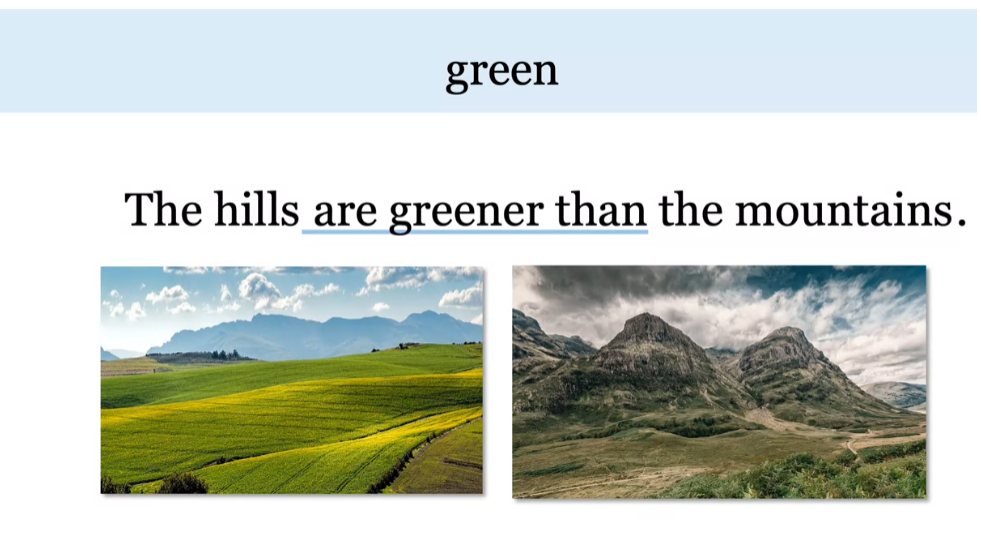
Here the adjective is dirty, and we have the
shoes, and the boots. Remember, dirty ends with a consonant and a
y. What goes here? The shoes are dirtier
than the boots.

Now the adjective is thin
and we are comparing pizza, this pizza and this
pizza. What goes here? This pizza is thinner
than this pizza. Did you remember
to double the n?
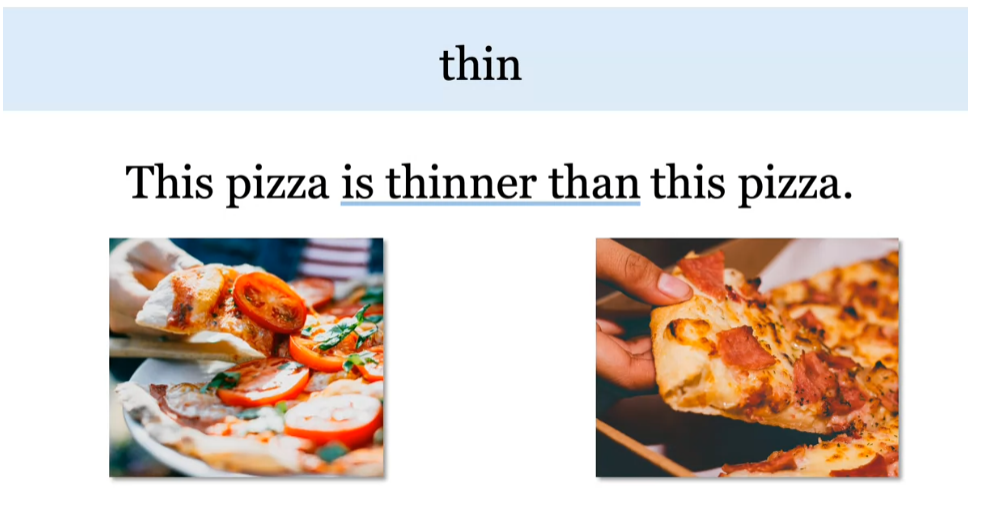
Pretty. These flowers
and those flowers. These flowers are prettier
than those flowers. Last one, interesting. We have two students in class, Lia’s class and Ann’s
class. What goes here? Lia’s class is more
interesting than Ann’s class. More because interesting
is a long word. Now you know how to compare
things with adjectives. You can say Paul is older than Ian by adding an er on old, and you can say that Ian is more serious than Paul by
using that word more.
Comparatives (Practice Exercise)
Exercise
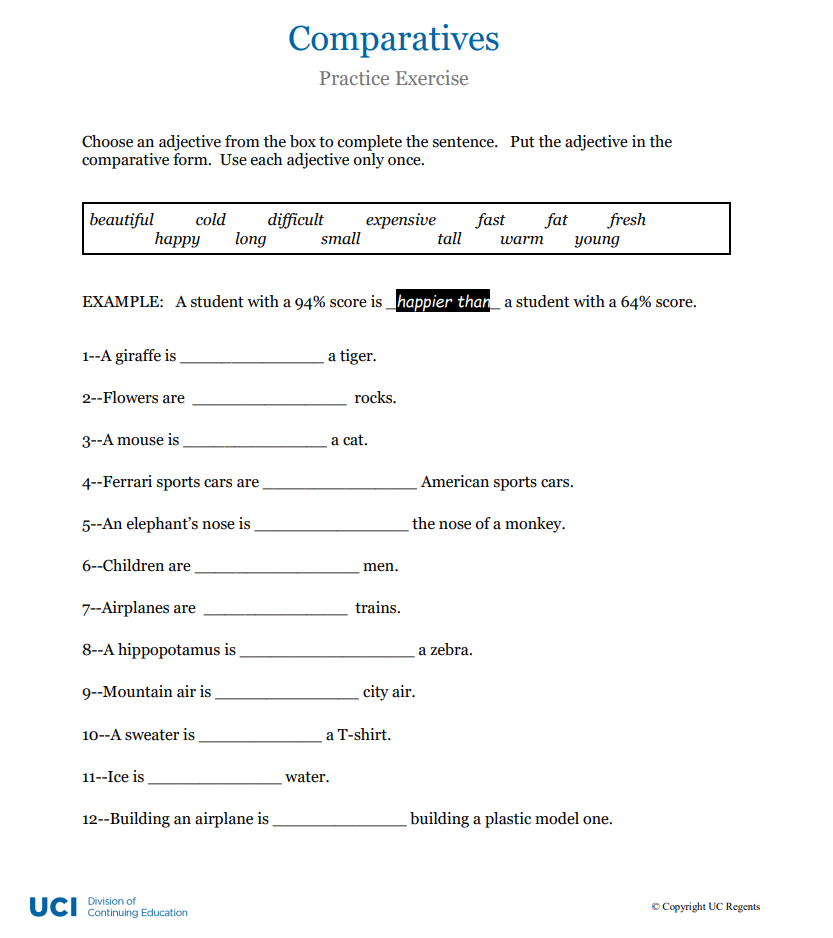
Answer
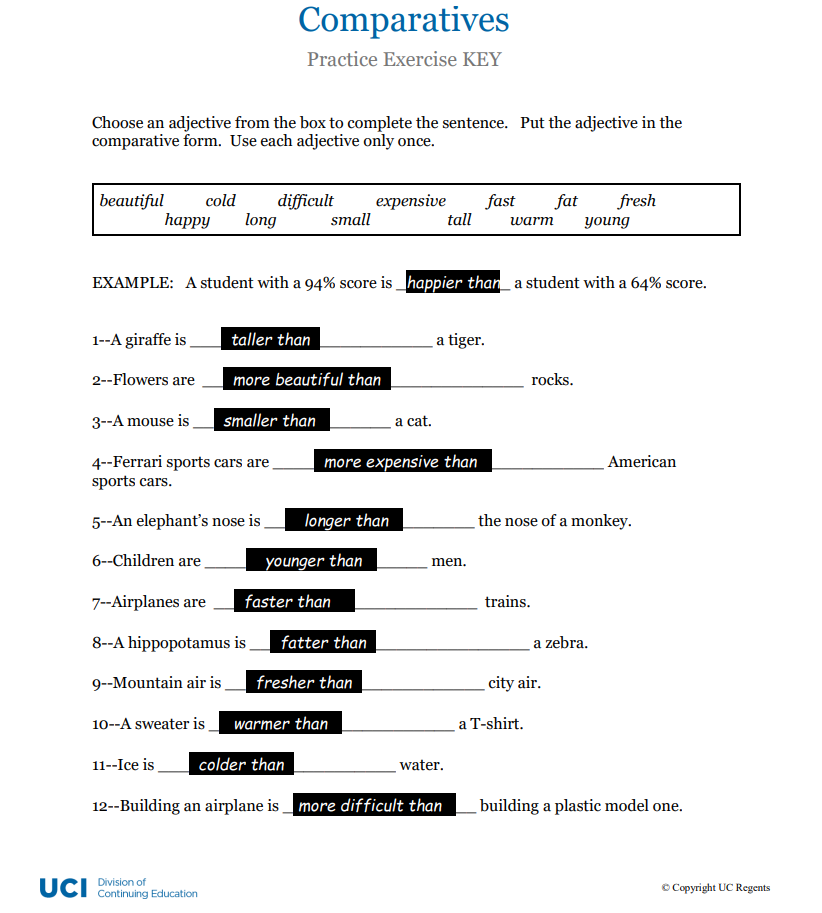
Infinitives with Want, Need & Like
Using infinitives with want,
like and need, this woman is thinking
I like to watch movies. I want to watch a movie right now,
but I need to finish this report. Like to watch, want to watch,
need to finish, in this lesson we are going to
look at how we use like want and need with another verb. And we’re calling this kind
of verb an infinitive.
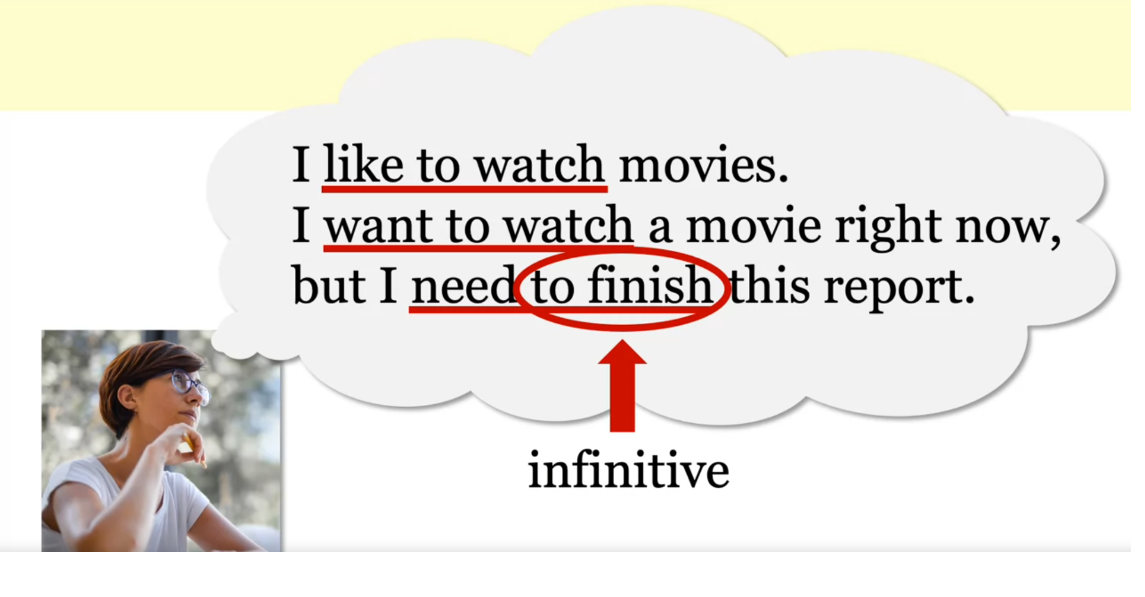
An infinitive is a verb in
simple form with the word to. So you already know a lot of
verbs to wave, to study, to swim. These are all infinitives
because they have to, to travel, to eat, to give. They’re just the simple
form with the word to. To love, to buy, to help
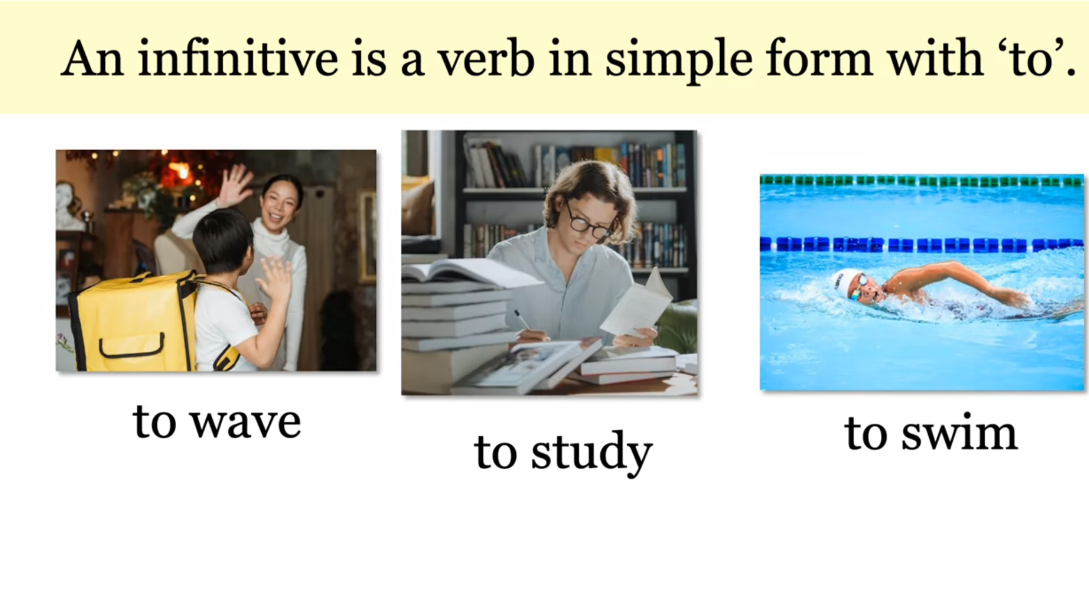
use an infinitive after want, like, and need, when you want to use a verb. So look I want an apple,
apple is a noun but in the second sentence I want to
eat an apple, to eat is the verb. It’s the infinitive of the verb eat. Just because it’s the simple
form with the word to. Here are some sentences with likes, Maggie
likes the ocean, the ocean is a noun. She likes to jump in the waves and
to jump is the verb in the infinitive

Jane needs an aspirin for her headache. Aspirin is the noun, and she needs to finish a project
at work to finish is the verb. Let’s look at more examples,
Mia likes to paint. She needs to wash her hands,
likes to paint. We use the infinitive,
likes to do something and needs to, she needs to wash. Vick wants to find a new job,
he needs to send his resume to companies,
wants to find, needs to send.

Ingrid is nervous about her exam tomorrow. She really wants to get an A,
she needs to calm down, wants to get needs to calm down. You may notice that the to is very
small when I speak but it’s there.
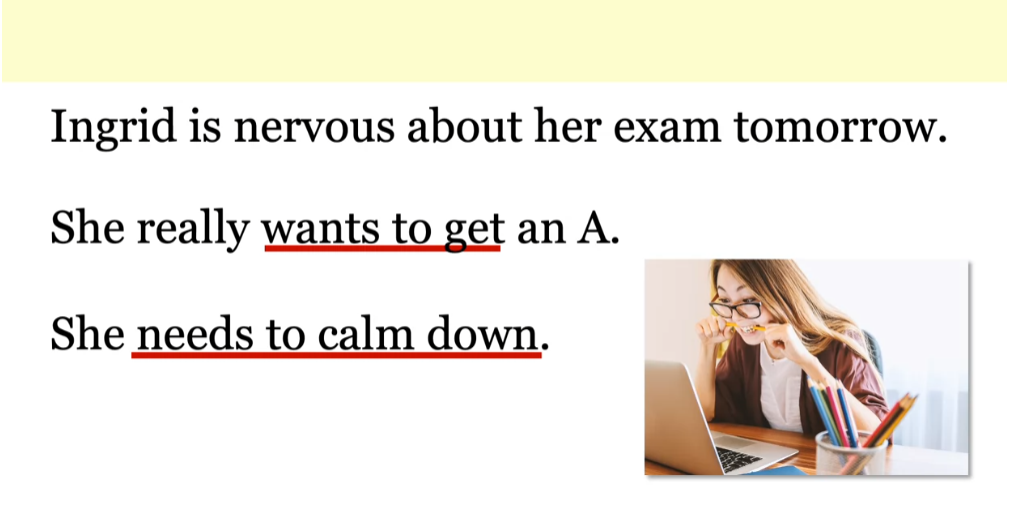
Here’s an example in negative form, Michelle doesn’t want to eat
the vegetables, doesn’t want to eat. But her mother says you need
to finish the vegetables if you want to have dessert,
need to finish want to have, need and want need the infinitive after.

Here’s some examples in question form,
I want to ask you some questions. Sure, what do you want to know? What did you like to play
when you were a little girl, here we have want to ask,
what do you want to know and what did you like to play? Look here, you see the want to a lot
of times when you hear spoken English that sounds like want to. But don’t write want to, I want to ask you
some questions, the t almost disappears.
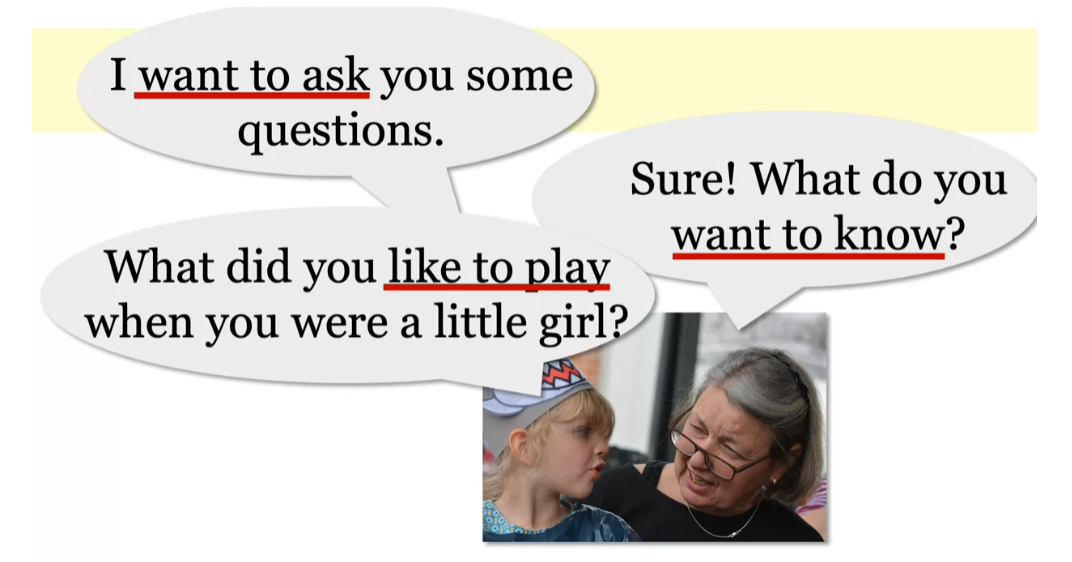
Okay, you try what’s wrong here,
she wants visit Hawaii some day. That’s right, there’s no to we
need to between wants and visit. We need the infinitive after wants, here’s another Evan likes
to listen to music. We have an extra s here, the infinitive
doesn’t ever have a different ending. It’s just the simple form with
the word to, so don’t put an s, don’t put an ed ending. Just listen Evan likes to listen to music,
he wants to be a musician. Now you know use an infinitive
after wants, like, and need, and an infinitive is
the verb with the word to. So here are your last examples,
do you like to study English? If you want to speak English well,
you need to practice.
Infinitives with Want, Need & Like (Practice Exercise)
Exercise
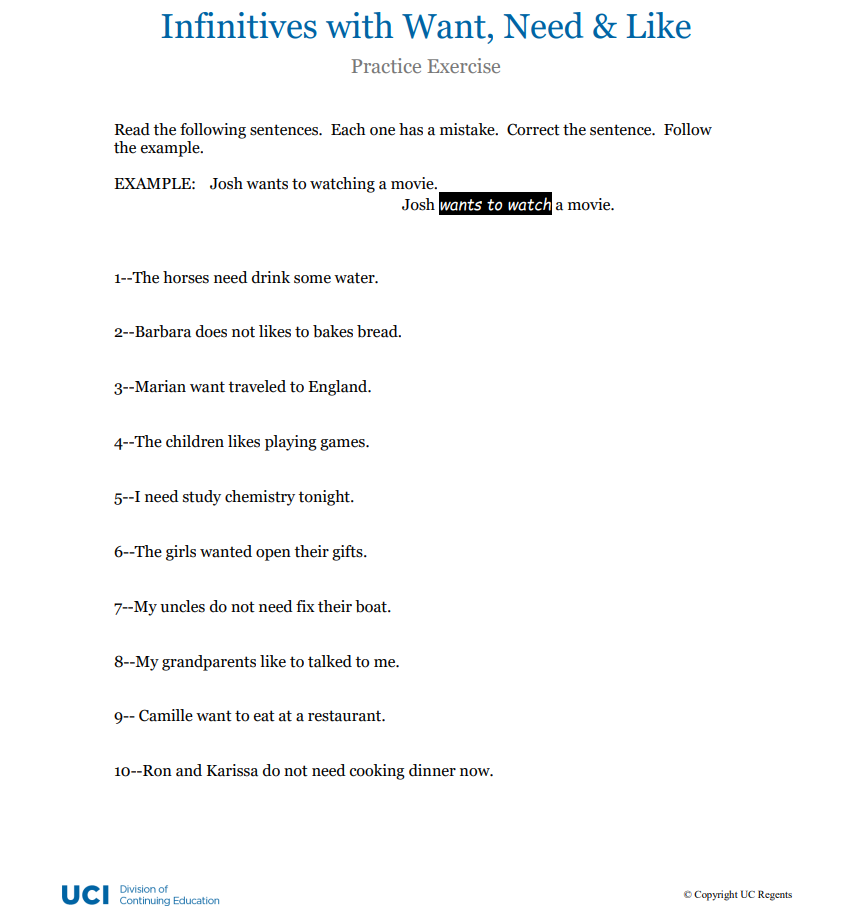
Answer
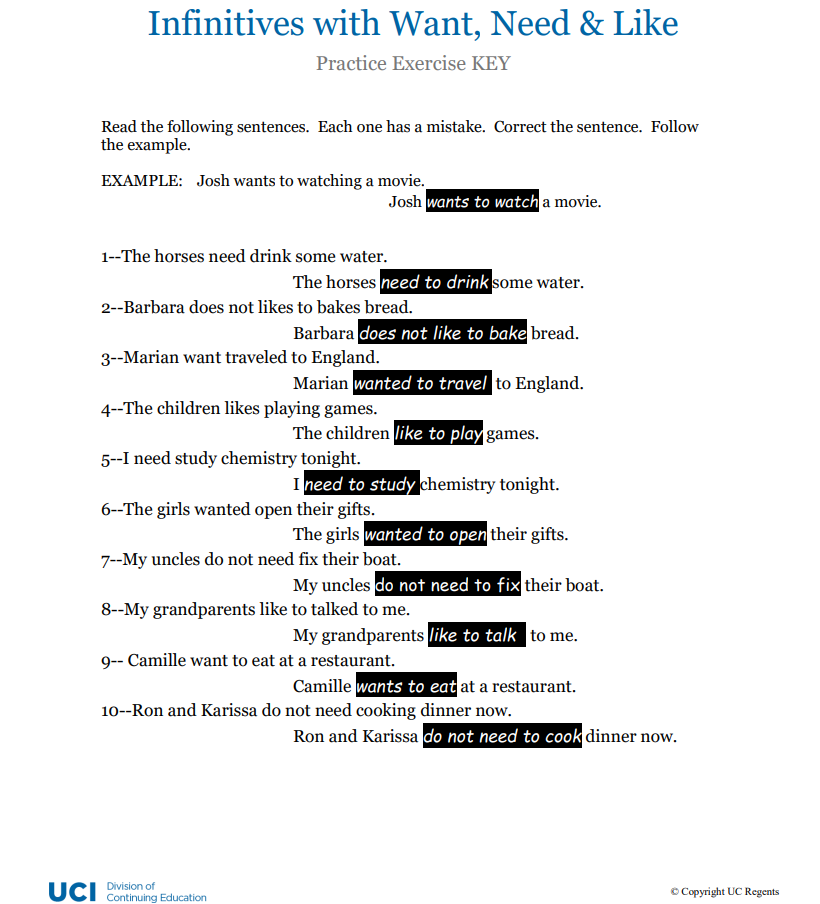
Quiz: More Useful Grammar Forms

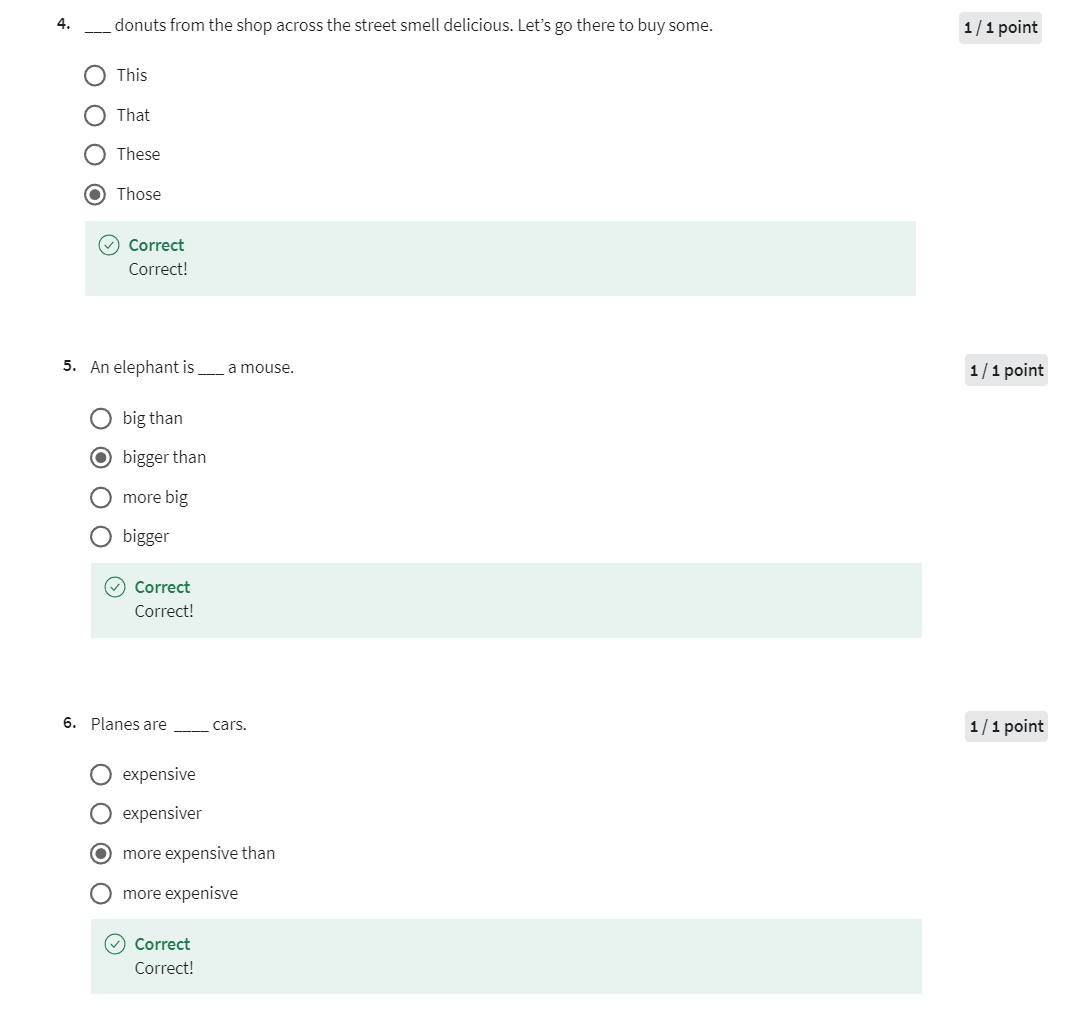

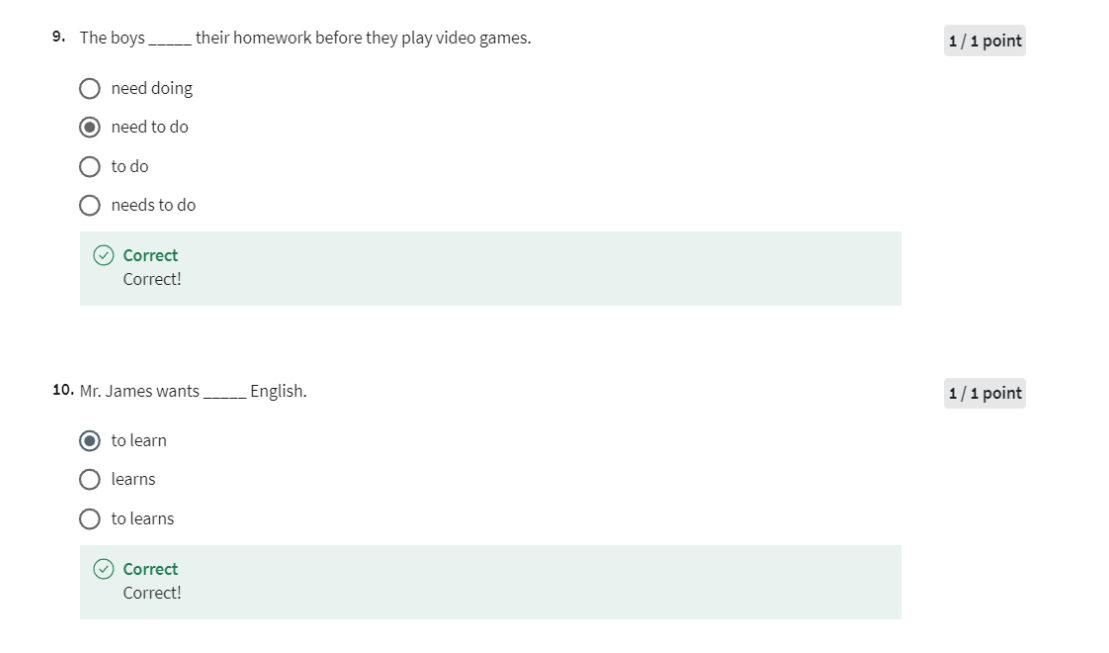
后记
2024年4月8日完成这门课,也就是说这个Beginner level的专项完成了。通过这三门课,能够学习美国的老师是如何教授语法的,并学习到一些语法的英语表述,比如 comparatives, infinitives, simple past, object pronouns等。
如果有人看到这篇笔记,笔者还是推荐把这三门课给小学生和初中生学习的。

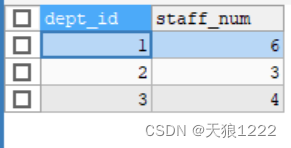






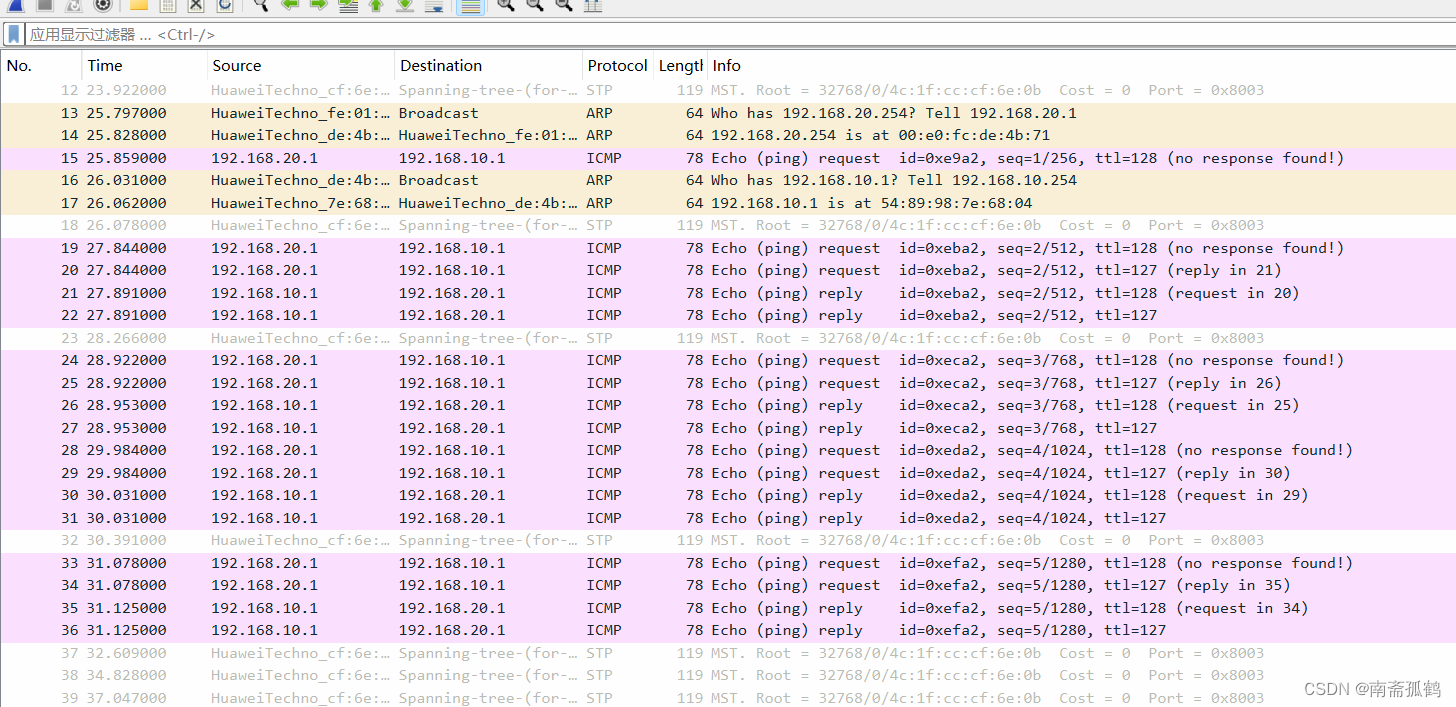

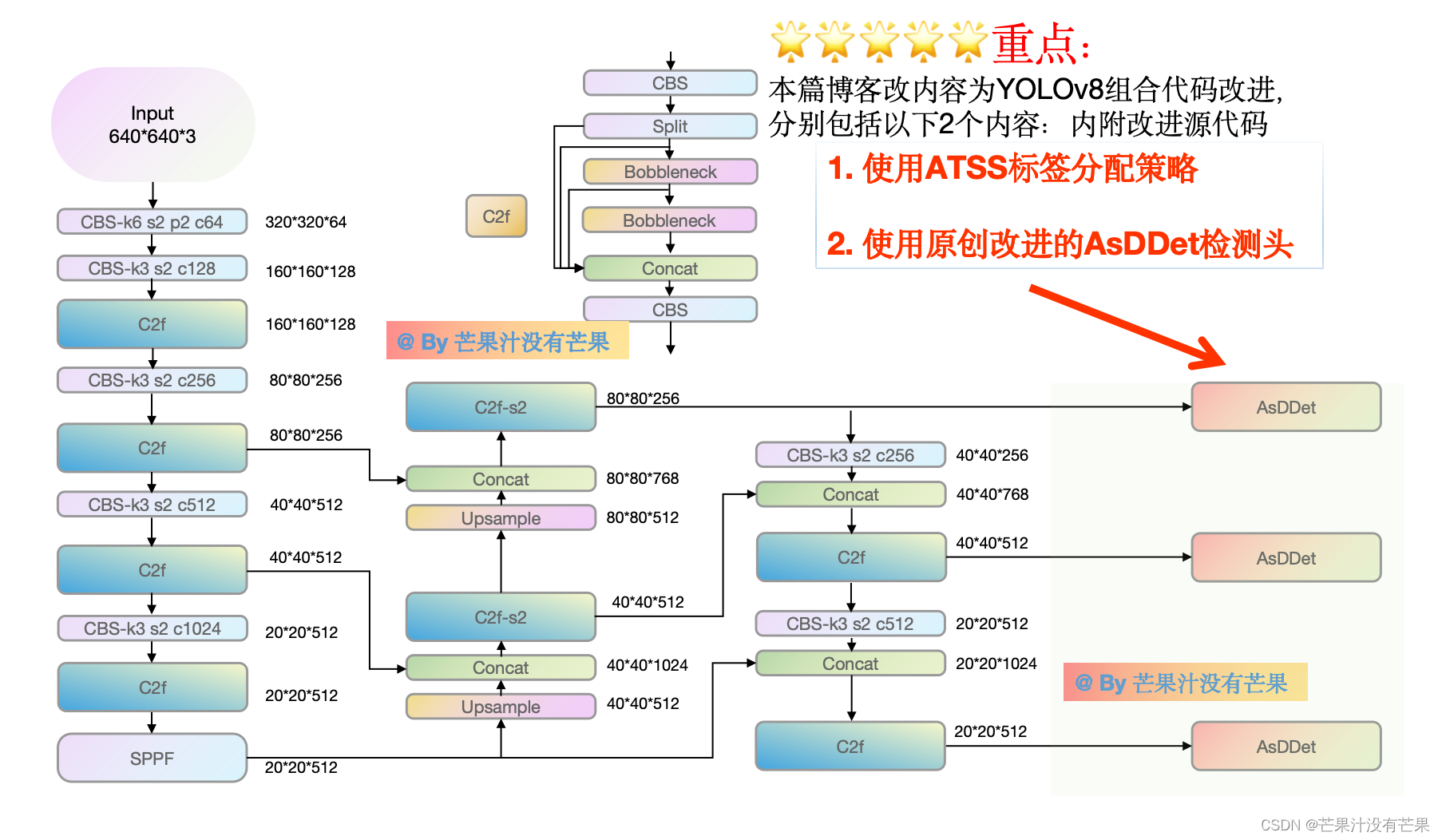




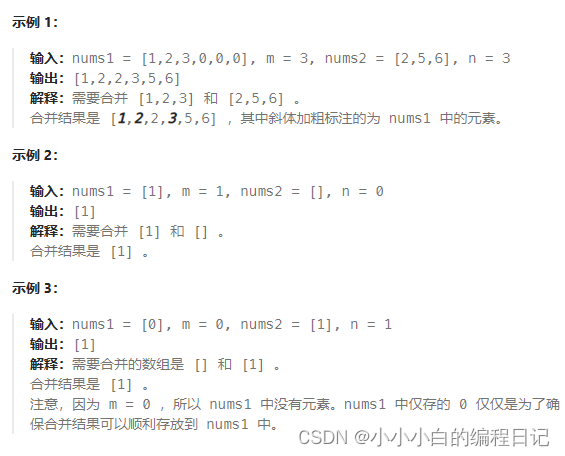
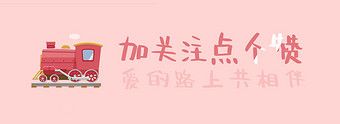

![高创新 | [24年新算法]NRBO-XGBoost回归+交叉验证基于牛顿拉夫逊优化算法-XGBoost多变量回归预测](https://img-blog.csdnimg.cn/direct/3dc8ee036a334b31be6651579d114341.png)
